Dean’s Marine
| Naam | Omschrijving | Afbeelding |
|---|---|---|
| Lis Terkol | This addition the Merchant ship fleet is an example of the feeder class of specialist tankers operated by the STOL Nielsen Organisation. Stolt Lis Terkol is one of a group of nine sister vessels designed to carry IMO Class 2 Chemicals. The cargo space is divided in thirteen tanks and two slop tanks. The hull is double skinned over the tank area and heavy fuel oil is carried in the engine room wing tanks and in the forepeak. Each Cargo tank has its own deep well pump and can discharge through a seperate pipe or though a common loading / discharge system. Cargo can be heated up to 65C by thermal heated oil exchangers. Stolt Lis Terkol is powered by a Krupp MAK pm453C of 3000kw engine turning a CP propeller giving a service speed of 13.4 knots, also driving a shaft generator though a power take off shaft. Maneuvering is assisted by a Brunvoll 326kw electric bow thruster. Her normal crew compliment is 10 all in single cabins. Details of the kit. Length 905mm Beam 150mm Scale 1/96 The model of the STOL LIS TERKOL is constructed on a glassfibre hull with bulwarks and freeing ports moulded into the hull. The decks and superstructure are in 1mm & .5mm computer generated printed plastic. The large freefall lifeboat and assorted other fittings are cast in acrylic resin for extremely sharp and accurate detailing. The H.I.A.B. crane is a kit in its own right cast in plastic and white metal. Etched brass details supply stanchions, walkways and deck fittings add the truly professional touch to this hard working merchant ship model. The complicated deck piping is assembled from styrene plastic tube and completed with all the valves, wheels and vents in metal, and using a 3 colour printed layout on the tank deck that lifts off as a complete unit for vast amounts of access to the hull. Propeller tube, fitted with oiling point and stainless steel shaft and cast rudder are included together with a comprehensive instruction book and a FULL SIZE plan. Full details are supplied for the fitting of motors, nicads and radio equipment. Van deze boot is er een tijdschrift artikel [of meer dan 1] te vinden op de pagina Modellen Tijdschrift Artikelen [Deze pagina is alleen toegankelijk voor VMBC het Anker leden] | 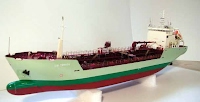 |
| Pieter Boele | In 1848 around 25 tugs were operational on the river Rhein. These were all side wheelers with a draught of around two meters. Because of the shallows in the middle Rhein it was impossible to use ships of a deeper draught. Rhein tugs were therefore lengthened to create more space for longer steam boilers, bigger engines, bunker and crew accommodation. About 1880 the first propeller driven tugs appeared on the Rhein which developed more speed and needed less crew. The "Wacht am Rhein VII" was built in 1893 as a Rhein tug by the P. Boele Shipyard at Slikkerveer in Holland. She was a tug powered by a coal fired boiler, a compound engine developing 300 IHP and was designed specially for the middle part of the river Rhein which has lots of bends and very strong currents. Her hull design is long and narrow to suit these conditions. The steering and control gear is behind the funnel giving very little view forward but with a much better view of the ships which she tows. In 1894 the ship was taken into service under the name "Wacht am Rhein VIII" by J Huttner in Wesel-Buderich. This company was established at an outstanding location on a bend of the Rhein where in addition to towage they ran a hotel-restuarant. To date (1993) this hotel-restaurant was still managed by the Huttner family although the shipping operation was sold off many years ago. Around the turn of the century the ship came under the control of the Johann Knipscheer Shipping Company who were the first firm who dared to attempt to tow a ship upstream to Basel on the Swiss border. The ship was renamed "Direktor Johann Knipscheer". In 1919 she was renamed "Speculant". Between 1924 and 1957 a number of major alterations were made to her power plant and superstructure. Today: In 1972 she was renamed Pieter Boele, after her original builder and in 1987 handed over to the Prins Hendrik Maritime Museum in Dordrecht where she has been kept in service by volunteer enthusiasts. Details of the kit Scale 1/35 Length 965mm Beam 180mm Sailing weight 2.2kgs The production of this fine and historic model could not have been achieved without the generous assistance of our friends in Holland. We would like to thank especially the following organisations:- Maritiem Buitenmuseum, Stichting, Buitenmuseum Leuvehaven, Postbus 21191, 3001 AD ROTTERDAM, Holland. Museum Voor Rijn- En Zeesleepvaart Maaskade 137d, ROTTERDAM, Holland. Uitgave van de Stichting Dordt in Stoom p/a Stationsweg 1, 3311 JW DORDRECHT, Holland Should you wish to obtain more information about the original ship these bodies will be pleased to assist. You might even consider a visit to the original at the preservation society at Dordrecht, as above. At the time of writing (March 1996) the original, now named Pieter Boele, is preserved as a working steamship by the Pieter Boele Preservation Society, and is used for passenger carrying. It would be best to check that this is still the case before planning a special trip. Van deze boot is er een tijdschrift artikel [of meer dan 1] te vinden op de pagina Modellen Tijdschrift Artikelen [Deze pagina is alleen toegankelijk voor VMBC het Anker leden] | 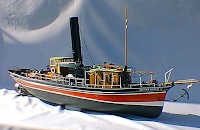 |
| Baltimore | SCALE 1:30 LENGTH 800 mm; BEAM 180 mm; HEIGHT 350 mm; WEIGHT 2.4 kg CARTON SIZE: 980 mm 350 mm 420 mm 5.3 kg BATTERY 4.5A 6-12V Pb-Acid or 7N-NiMH 8.4V 3.6 Ah (Not Included) MOTOR 1 x 550 ESC - 30A R/C CHANNELS – 2 (Not Included) The well known tug model is based on a glass fibre hull with propshaft and rudder installed. The model is assembled and painted, plus decks fitted, the cabin is constructed and detailed with a large quantity of fine fittings as per the full size vessels. Mast is pre-made and all railings and detailed parts are fitted. A quality 30amp electronic speed controller if pre-wired and fitted in place to the 550 type motor, mounted and clamped in place with a heat sink type mounting bracket. A double joint insert coupling to connects it all together for quiet running. For the modeller who just wishes to get on the water with an attractive model, this is ideal, for the ship lover that wants to add lots of extra detail this model is an ideal starting point and give a vast range of extra items and detail that can be added to give a personnel touch |  |
| Brave Class | SCALE 1:48 LENGTH 851 mm; BEAM 217 mm; HEIGHT 367 mm; WEIGHT 3.0 kg CARTON SIZE: 904 mm 304 mm 296 mm 4.7 kg BATTERY 8N-3600 NiMH 9.6V 3.6 AH (Not Included) MOTOR 2 x 550 ESC - 50A R/C CHANNELS – 2/3 (Not Included) Possibly, the most recognisable craft in the model boat world. Hull, deck in lightweight glass fibre mouldings, detailed guns and weapons painted installed and finished, mast assembled from brass, painted and ready for installation. Decals applied and a pre-cut stand lined with anti scratch rubber is included in the kit This craft makes a very impressive model of this well known fast attack craft, for the collector who does not have the time or skills to construct this highly detailed model from a kit, or the enthusiast who will repaint his model in alternative colours and add more detail, this introduction to the world of the fast launch makes a very pleasing alternative to the standard kits available on the market place. |  |
| Coastguard | SCALE 1:30 LENGTH 728 mm; BEAM 210 mm; HEIGHT 460 mm; WEIGHT 2.8 kg CARTON SIZE: 775 mm 295 mm 303 mm 4.3 kg BATTERY 5N-3000 NiMH 6V 3.6 Ah (Not Included) MOTOR 2 x 550 ESC - 30A R/C CHANNELS – 2 (Not Included) This model is based on a glass fibre hull prop-shafts and rudders installed. The model is assembled and painted, plus decks fitted, the cabin is constructed and detailed inside and out with full controls and instruments as per the full size vessels. Mast and spars and pre-made and rigged. A quality 30amp electronic speed controller if pre-wired and fitted in place to the 2 x 550 type motors, mounted and clamped in place with a heat sink type mounting bracket. Two double joint insert coupling to connect it all together for quiet running. For the modeller who just wishes to get on the water with an attractive model, this is ideal, for the ship lover that wants to add lots of extra detail this model is an ideal starting point and give a vast range of extra items and detail that can be added to give a personnel touch. | 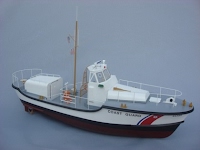 |
| Corvette | SCALE 1:72 LENGTH 871 mm; BEAM 142 mm; HEIGHT 327 mm; WEIGHT 2.1 kg CARTON SIZE: 960 mm 305 mm 470 mm 6.8 kg BATTERY 6N-2000 NiMH 7.2V 2000 NiMH (Not Included) MOTOR 1 x 380 ESC - 30A R/C CHANNELS – 2 (Not Included) This model is based on a glass fibre plated and detailed hull propshaft and rudder installed. The model is assembled and painted, plus decks are planked and the bridge is constructed and detailed as per the full size vessels. Mast and a full set of weapons pre-made and fitted. A quality 30amp electronic sped controller is pre-wired and fitted in place to the 550 type motor, mounted and clamped in place with a heat sink type mounting bracket. A double joint insert coupling to connects it all together for quiet running. For the modeller who just wishes to get on the way with an attractive model, this is ideal, for the ship lover that wants to add lots of extra detail this model is an ideal starting point and give a vast range of extra items and detail that can be added to give a personnel touch. |  |
| Eastwind | Length 1307mm Beam 298mm A timeless and classic model of one of the east coasts turn of the century fishing vessels, a timeless classic model and a joy to see on the water, scudding along in light airs. Assembled and finished with auxiliary motor and propeller, Glass fibre hull planked decking and cabin in timber planked superstructure. A huge amount of fine detail is included on this model such as working hatchways, crab baskets, planked decks, Anchors, etc This model comes complete with pre stitched sails, mast and booms plus rudder servo, Electronic speed controller large sail winch (for 3 channel radio, not supplied), cruising motor and a boat stand. | 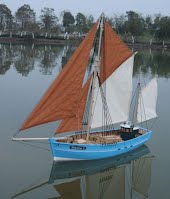 |
| Grand Captain | Length 920mm Beam 280mm This luxury yacht is very impressive because of its exquisite design and superb performance on the water. Assembled and finished with twin screws and propellers, Glass fibre hull and hi impact styrene superstructure. This model comes complete with rudder servo, Electronic speed controller, and twin powerful cruising motors and a boat stand. | 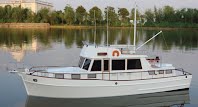 |
| Greensea | SCALE 1:18 LENGTH 600 mm; BEAM 220 mm; HEIGHT 530 mm; WEIGHT 2.4 kg CARTON SIZE: 715 mm 350 mm 405 mm 3.6 kg BATTERY 4.5A 6-12V Pb-Acid or 7N-3600NiMH 8.4V 3.6 Ah (Not Included) MOTOR 1 x 550 ESC - 20A R/C CHANNELS – 2 (Not Included) This model is based on a glass fibre hull propshaft and rudder installed. The model is assembled and painted, plus decks are planked and the cabin is constructed from timber and panelled as per the full size vessels. Mast and spars and pre-made and rigged with real cloth sails. A quality 30amp electronic sped controller if pre-wired and fitted in place to the 5550 type motor, mounted and clamped in place with a heat sink type mounting bracket. A double joint insert coupling to connects it all together for quiet running. | 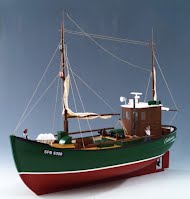 |
| Hong Kong Police | SCALE 1:50 LENGTH 850 mm; BEAM 185 mm; HEIGHT 400 mm; WEIGHT 2.8 kg CARTON SIZE: 1130 mm 360 mm 580 mm 9 kg BATTERY 8N-3000 NiMH 8.4 – 9.6V 3A (Not Included) MOTOR 2 x 550 ESC - 50A R/C CHANNELS – 2 (Not Included) This model is based on a glass fibre hull with two prop-shafts and rudders installed. The model is assembled and painted, plus decks fitted, the cabin is constructed and detailed with a large quantity of fine fittings as per the full size vessels. Mast is pre-made and rigged as is the R.I.B inflatable boat on the stern and the 20mm cannon in the bows. A quality 30amp electronic speed controller if pre-wired and fitted in place to the 2 x 550 type motors, mounted and clamped in place with a heat sink type mounting bracket. Two double joint insert coupling to connect it all together for quiet running. |  |
| Lucky XI | SCALE 1:50 LENGTH 820 mm; BEAM 250 mm; HEIGHT 645 mm; WEIGHT 2.6 kg CARTON SIZE: 990 mm 340 mm 410 mm 4.8 kg BATTERY 4.5A 6-12V Pb-Acid or 6N-3600NiMH 7.2V 3.6 Ah (Not Included) MOTOR 2 x 550 ESC - 50A R/C CHANNELS – 2/3 (Not Included) The well known and long lasting New York tug model is based on a glass fibre hull with propshaft and rudder installed. The model is assembled and painted, plus decks fitted, The cabin is constructed and detailed with a large quantity of fine fittings as per the full size vessels. Mast is pre-made and all railings and detailed parts are fitted. A quality 30amp electronic speed controller if pre-wired and fitted in place to the 550 type motor, mounted and clamped in place with a heat sink type mounting bracket. A double joint insert coupling to connects it all together for quiet running. |  |
| Michigan | Length 830mm Beam 225mm Michigan is a replica of one of the most popular luxury speed boats in the USA. This type known as a barrel- back runabout was very powerful with typical large volume engines. These boats were very popular from the 1930 to the 1940s. Hull is planked construction in Mahogany sanded and finished to a high gloss plus the underwater hull is protected with a coating to protect the woodwork from damage. This classic model comes complete with, rudder servo, Electronic speed controller, cruising motor and a boat stand and is fitted with 2 channel 40mg radio gear | 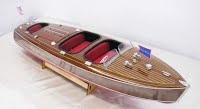 |
| Newcastle | SCALE 1:50 LENGTH 815 mm; BEAM 215 mm; HEIGHT 350 mm; WEIGHT 2.6 kg CARTON SIZE: 980 mm 350 mm 420 mm 5.7 kg BATTERY 4.5A 6-12V Pb-Acid or 7N-3600NiMH 8.4V 3.6Ah (Not Included) MOTOR 1 x 550 ESC - 30A R/C CHANNELS – 2 (Not Included) The well known and long lasting tug model is based on a glass fibre hull with propshaft and rudder installed. The model is assembled and painted, plus decks fitted, the cabin is constructed and detailed with a large quantity of fine fittings as per the full size vessels from life-raft container to towing gear Mast is pre-made and all railings and detailed parts are fitted. A quality 30amp electronic speed controller if pre-wired and fitted in place to the 550 type motor, mounted and clamped in place with a heat sink type mounting bracket. A double joint insert coupling to connects it all together for quiet running. | 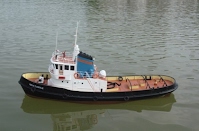 |
| Ontario | Length 1124mm Beam 230mm Ontario is a replica of the first true luxury speed boats in the USA. This type known as a Triple Cockpit Runabout was very powerful with typical large volume engines. These boats were very popular from the 1920 to the 1940s. Hull is planked construction in Mahogany sanded and finished to a high gloss plus the underwater hull is protected with a coating of glass fibre to protect the woodwork from damage This classic model comes complete with, rudder servo, Electronic speed controller, cruising motor and a boat stand and is fitted with 2 channel 40mg radio gear. | 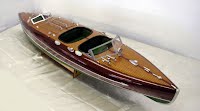 |
| Our Lass | Scale 1/32 Length 700mm Beam 230mm This well known and colourful trawler model working from Whitby is based on a glass fibre hull and deck with the propshaft and rudder installed. The model is assembled and painted, plus decks fitted, the cabin is constructed and detailed with a large quantity of fine fittings as per the full size vessel. Mast is pre-made and all railings and detailed parts are fitted. A quality 30amp electronic speed controller if pre-wired and fitted in place to the 505 motor, mounted and clamped in place with a heat sink type mounting bracket. A double joint insert coupling to connects it all together for quiet running. | 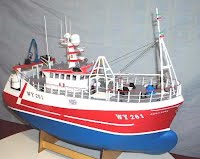 |
| Perkasa | SCALE 1:33 LENGTH 940 mm; BEAM 250 mm; HEIGHT 367 mm; WEIGHT 3.5 kg CARTON SIZE: 954 mm 304 mm 296 mm 4.7 kg BATTERY 8N-3600 NiMH 9.6V 3.6 AH (Not Included) Motor 500 type 6-7.2 volts ESC - 50A R/C CHANNELS – 2/3 (Not Included) First in the range, and possibly the most recognisable craft in the model boat world. Hull, deck and superstructure in lightweight glass fibre mouldings, detailed guns and weapons painted installed and finished, mast assembled from brass, painted and ready for installation. Decals applied and a pre-cut stand lined with anti scratch rubber is included in the kit with a etched clear plastic name plate. (But it is produced in China, it is not the correct spelling). | 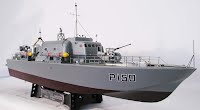 |
| Pipefish | SCALE 1:20 LENGTH 860 mm; BEAM 250 mm; HEIGHT 650 mm; WEIGHT 3.0 kg CARTON SIZE: 970 mm 408 mm 500 mm 8.7 kg BATTERY 4.5A 6-12V Pb-Acid or 7N-3600 NiMH 8.4V 3.6 Ah (Not Included) MOTOR 1 x 550 ESC - 30A R/C CHANNELS – 2 (Not Included) This model is based on a glass fibre hull propshaft and rudder installed. The model is assembled and painted, plus decks are planked and the cabin is constructed from timber and panelled as per the full size vessels. Mast and spars and pre-made and rigged with real cloth sails. A quality 30amp electronic sped controller if pre-wired and fitted in place to the 5550 type motor, mounted and clamped in place with a heat sink type mounting bracket. A double joint insert coupling to connects it all together for quiet running. | 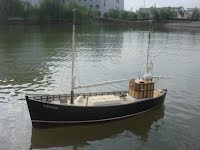 |
| Redsea | SCALE 1:18 LENGTH 503 mm; BEAM 205 mm; HEIGHT 370 mm; WEIGHT 2.4 kg CARTON SIZE: 715 mm 350 mm 405 mm 3.5 kg BATTERY 4.5A 6-12V Pb-Acid or 7N-3600NiMH 8.4V 3.6Ah (Not Included) MOTOR 1 x 550 ESC - 20A R/C CHANNELS – 2 (Not Included) This model is based on a glass fibre hull propshaft and rudder installed. The model is assembled and painted, plus decks are planked and the cabin is constructed from timber and panelled as per the full size vessels. Mast and spars and pre-made and rigged with real cloth sails. A quality 30amp electronic sped controller if pre-wired and fitted in place to the 5550 type motor, mounted and clamped in place with a heat sink type mounting bracket. A double joint insert coupling to connects it all together for quiet running. | 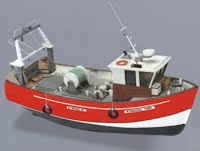 |
| Rivival | Length 850mm Beam 250mm A true to life replica of a famous Italian pleasure craft. The original was built in Sarico on Lago de Isea in the 1970s to the 1990s, which only 277 were built by hand using the most exquisite materials very powerful with typical large volume engines. These boats were very popular from the 1930 to the 1940s. Hull is planked construction in Mahogany sanded and finished to a high gloss plus the underwater hull is protected with a coating to protect the woodwork from damage. This classic model comes complete with, rudder servo, Electronic speed controller, cruising motor and a boat stand and is fitted with 2 channel 40mg radio gear. |  |
| RNLI Lifeboat | SCALE 1:30 LENGTH 728 mm; BEAM 210 mm; HEIGHT 460 mm; WEIGHT 2.8 kg BATTERY 5N-3000 NiMH 6V 3.6 Ah (Not Included) MOTOR 2 x 550 ESC - 30A R/C CHANNELS – 2 (Not Included) This model is based on a glass fibre hull propshafts and rudders installed. The model is assembled and painted, plus decks fitted. The cabin is constructed and detailed inside and out with full controls and instruments as per the full size vessels. Mast is pre-made and rigged. A quality 30amp electronic speed controller if pre-wired and fitted in place to the 2 x 550 type motors, mounted and clamped in place with a heat sink type mounting bracket. Two double joint insert coupling to connect it all together for quiet running. | 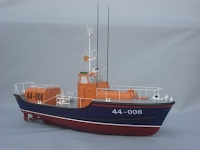 |
| Smit Frankrijk | SCALE 1:30 LENGTH 875 mm; BEAM 275 mm; HEIGHT 320 mm; WEIGHT 4.1 kg CARTON SIZE: 980 mm 380 mm 660 mm 10.3 kg BATTERY 4.5A 6-12V Pb-Acid or 7N-3600NiMH 8.4V 3.6 Ah (Not Included) MOTOR 2 x 550 ESC - 30A R/C CHANNELS – 2/3 (Not Included) The well known tug model is based on a glass fibre hull with propshafts and rudders installed. The model is assembled and painted, plus decks fitted the wheelhouse is constructed and detailed with a large quantity of fine fittings as per the full size vessels from life-raft container to towing gear Mast is pre-made and all railings and detailed parts are fitted. A quality 30amp electronic speed controller if pre-wired and fitted in place to the 2 x 550 type motor, mounted and clamped in place with a heat sink type mounting bracket. A double joint insert couplings to connect it all together for quiet running. | 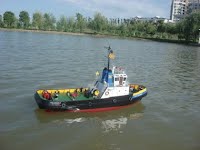 |
| Swift | SCALE 1:25 LENGTH 840 mm; BEAM 235 mm; HEIGHT 610 mm; WEIGHT 3.9 kg CARTON SIZE: 1030 mm 365 mm 605 mm 9.7 kg BATTERY 7N-3000 NiMH 8.4 – 9.6V 3A (Not Included) MOTOR 1 x 550 ESC - 20A R/C CHANNELS – 3 (Not Included) This model is based on a glass fibre hull with two prop-shafts and rudders installed. The model is assembled and painted, plus decks fitted, the cabin is constructed and detailed inside and out with full controls and instruments as per the full size vessels. Mast and bridge is highly detailed as per the full size craft. A quality 30amp electronic speed controller if pre-wired and fitted in place to the 2 x 550 type motors, mounted and clamped in place with a heat sink type mounting bracket. Two double joint insert coupling to connect it all together for quiet running. | 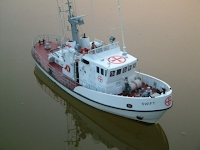 |
| US Coastguard | Length 940mm Beam 200mm The Island Class 1308 is one of the most recognized patrol / rescue ships due to its bright colours and its seaworthy hull. This model with its wealth of detail and numerous fine parts makes a stunning model of this classic amongst patrol craft Assembled and finished with twin screws and propellers, Glass fibre hull and hi impact styrene superstructure. This model comes complete with rudder servo, Electronic speed controller, and twin powerful cruising motors and a boat stand. |  |
| Vosper RTTL | Scale 1/24 Length 880mm Beam 245mm The classic Vosper Rescue & Target Towing Launch, and is probably one of the most well known craft in the world of model boating, plus the full size original sits in the entrance to the R.A.F. museum Hendon in London. This model is based on a glass fibre hull and deck with two prop-shafts and rudders installed. The model is assembled and painted, plus decks fitted, The bridge is constructed and detailed inside with full controls and instruments as per the full size vessels. Mast and bridge is highly detailed as per the full size craft. A quality 30amp electronic speed controller if pre-wired and fitted in place to the 2 x 550 type motors, mounted and clamped in place with a heat sink type mounting bracket. Two flexi joint insert couplings to connects it all together for quiet running. A rudder servo is fitted and connected to thw twin rudders installed on this craft. | 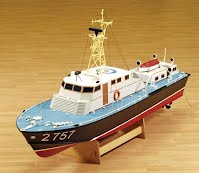 |
| Barge Set | Ideal for starting into the joys of towing, and great fun having something to push, pull and generally shove around the lake. Theses two kits in one box make up a pair of barges are based on a VACFORMED hulls for fast and simple assembly. Computer generated plastic printed in 6 colours is used for the deck and wells to give quick and crisp assembly. A full set of fittings in cast light alloy and plastic give the finishing touch to the models A crane base is included for fitting you own type of crane or lifting gear from one of the many model railway accessories on the market. Or do your own thing and design your own. A set of small scale plans are included in the kits of the equipment carried on full size barges. | 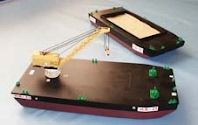 |
| Barge Single | Ideal for starting into the joys of towing, and great fun having something to push, pull and generally shove around the lake. based on a VACFORMED hull for fast and simple assembly. Computer generated plastic printed in 6 colours is used for the deck and wells to give quick and crisp assembly. A set of fittings in cast light alloy and plastic give the finishing touch |  |
| Dante | This new addition to the Compact kit range is to the slightly larger scale of 1/72 to give more working room in the model and to make the kits more suitable for the railway modeler. The details and construction methods used in the craft are the same as in all the kits in the Compact Kit range. This craft is based on one of the ships used in the petro- chemical port of Euro-port in Holland. The ships are constructed by the DELTA shipyard to a standard design and personalised by the buyers to suit there own needs. This example of the type is designed as a fire-fighting and rescue ship. She is fitted with powerful water and foam monitors, the one on the top of the mast being telescopic. She is also fitted with fast launch and recovery R.I.B.s in quick launch davits. On board she is also fitted with powerful suction pumps and a decompression chamber. The ship has two powerful diesel engines driving twin screws and are capable of handling most disasters on the largest of ships in confined waters Details of the kit Scale 1/72 Length 320mm Beam 115mm Sailing weight 857g | 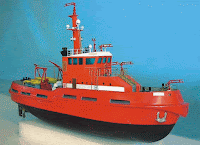 |
| Empire Susan | The EMPIRE class tugs were of traditional design for single screw, similar to previous types such as the Warrior class with variations in design and power to cover a variety of roles. They were all built between 1941 -1946 and all had steam triple expansion engines. Some of them were coal fired others oil fired and the class gave excellent service with some very long voyages from world wide bases to there credit. Approximately 144 were constructed of which about half were in Naval service. This classic ocean steam tug was launched in 1944 at Clelands (Successors) Ltd at Willington of the Modified Englishman class. She was powered by a triple expansion engine oil fired giving a bollard pull of 15 tons on rpm of 108 and a top speed of 12 knots on a displacment of 987 tons. Her weapons fit at the time was 2 x 20mm Oerlikons on bandstands Scale 1/96 LENGTH 440mm BEAM 110mm | 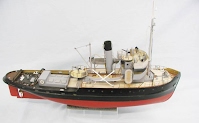 |
| HMS Bronnington | The “Ton” or Coniston class of minesweepers were constructed as minesweepers for the R.N and other navies between 1951 and 1959 making them one of the most numerous class of ships to serve in the R.N. All were constructed with timber hulls and were powered by 2 Mirrles Blackstone diesels of 2500 hp or later ships were constructed with 2 Deltic diesels of 3500 hp. on two shafts giving 15 knots Max speed. Weapons fit varied but was normally 1 x 40mm and 2 x 20mm. Mine hunters normally carried 1 x 40mm. The Bronington (ex Green Beetle ) was constructed by Cook Welton & Gemmel at Hull and Beverly. She was laid down in 1951 and launched in 1954. She was renamed H.M.S. Humber and was stationed with the 10th M.S.S. R.N.R In 1958 she was commissioned as Bronington and sent to the 100th M.S.S. In 1965 he was converted to a mine hunter at Rosyth (as she is modeled by us) and stationed with the 1st M.C.M.S. In 1974 she was refitted at Gibraltar and then stationed at Rosyth with the 1st M.C.M.S. The Lt the Prince of Wales was in command from 9/2/76 until she was visited by H.M. the Queen and Prince Philip whilst at the Tower Pier in London. Between 1980 and 1984 she was serving with the 2nd M.C.M.S and with STANAVFORCHAN. Details of the kit Scale 1/96 Length 465mm Beam 86mm Sailing weight 736g | 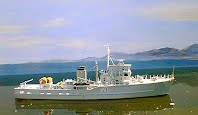 |
| HMS Bulldog | Name ship of the class of four this coastal waters hydrographic survey ship was constructed by Brook Marine and launched in 1968. Bulldog was built by a yacht builder, she is said to be fitted out more like a luxury yacht than a serving navel craft. Considered by many to be one of the prettiest ships in the Royal Navy, they are seen in coastal waters and at many small harbours on flag showing. On a displacement of 1088 tons and with a speed of 15 knots, these small and powerful survey craft are renowned for there sea keeping abilities, staying at sea in the short and rough coastal waters which is their domain. Details of the kit Scale 1/96 Length 605mm Beam 125mm Sailing weight 1.3kg | 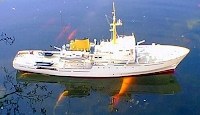 |
| HMS Royal Marine | The military classes of Naval Trawlers were constructed by Cook Welton & Gemmel ltd of Beverly who launched 75 Trawlers to Royal navy designs based on commercial ships. The Royal Marine was ordered on 20-3-43 as part of the 43 Trawler program. These ships had a displacement of 750 tons and were powered by one shaft steam reciprocating engine of 1.100 i,h,p giving a top speed of 11 knots. Heavy demands were made on the Trawlers during the war years for A/S and M/S work in the opening stages of the war and they preceded far a field, even to providing the A/s screen for some of the ocean convoys. Their Weatherly qualities always of the highest order, often resulted in their being the only form of escort operative in bad weather and they could keep the seas when even destroyers were compelled to seek shelter. She was armed with a single 4” gun plus 4 x 20mm A.A guns. With a complement of 40. Royal Marine survived the war and was sold out of navy service to become the SISAPON in 1946. She was converted to a deep water trawler with diesel engines for Icelandic fishing. Details of the kit Scale 1/96 Length 619mm Beam 102mm Sailing weight 1.06kg | 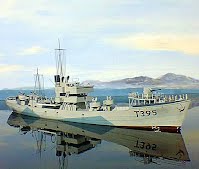 |
| MFV Vigilant | The Vigilant is based on a type of trawler and was one of the last and largest type of wooden built trawlers constructed. The design followed on from the Timber built drifters of the day but the steel built trawlers and stern trawlers coming into service replaced this type in the fishing fleets of the U.K as the larger trawlers were becoming uneconomic. She was constructed by Herde Mackenzie of Peterhead in 1958 for the Devotion Fishing Co Ltd. Powered by a Rustom Hornsby 454 engine giving a top speed of 10 knots. Her frames were 4.5” thick Oak and spaced at 21”, The planking was 4” thick so she was of immensely strong construction. The cost of Vigilance was £67,492 when launched. She carried a crew of 11 and fished from Aberdeen usually making 3 trips per fortnight Scale 1/72 Length 460mm Beam 100mm Van deze boot is er een tijdschrift artikel [of meer dan 1] te vinden op de pagina Modellen Tijdschrift Artikelen [Deze pagina is alleen toegankelijk voor VMBC het Anker leden] | 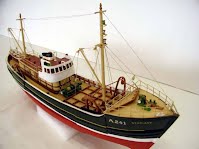 |
| Mastif | This new addition to the Compact kit range is to the slightly larger scale of 1/72 to give more working room in the model and to make the kits more suitable for the railway modeler. The details and construction methods used in the craft are the same as in all the kits in the Compact Kit range. The craft is based on one of the tugs used by the Dutch navy in Den Helder dockyard, The tugs are constructed by the DELTA shipyard for the Navy. The ships are called the “Linge” Regge Hunze Rotbe and the Gowe. The one this model is based on a craft called the “GOWE” The ship has two powerful diesel engines driving twin screws and are capable of handling the largets of ships in confined waters She is based on a standard private design and many have been constructed and sold for private service. The color scheme shown on this model is fictional as the variations and colors used in the full size craft are to numerous to mention. Details of the kit Scale 1/72 Length 320mm Beam 115mm Sailing weight 857g | 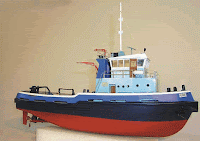 |
| Puffer | This new addition to the Compact kit range is to the slightly larger scale of 1/72 to give more working room in the model and to make the kits more suitable for the railway modeler. The details and construction methods used in the craft are the same as in all the kits in the Compact Kit range. The little “Puffer” is most probably one of the best known small craft in the U.K. Built in huge numbers in every variation possible, some are still in steam today. For a small, “cute” little model that is fun to sail in everything from the garden pond upwards the little Puffer has simplicity and charm in abundance. Details of the kit Scale 1/72 Length 269mm Beam 70mm Sailing weight 459g the puffer is the Trilight with a vafrom hull and no fittings kit, comes in a bag! This kit contains VAC-FORMED HULL with plate line detail FULL SIZE PLAN on TWO SHEETS MOTOR MOUNTING NICAD TRAY VAC--FORMED DINGHY HULL MOTORISING INSTRUCTIONS PRINTED DECK & BASIC SUPERSTRUCTURE | 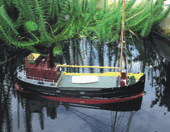 |
| Response | The steam Picket Boat was developed from the 63ft craft that were carried by Capital ships from 1863, that were launched and carried out attacks on the enemy fleet. They were never used in such a role but became maids of all work for ships. They could be armed with a 3pd gun or a Nordenfelt machine gun, The 56ft was the most numerous and became a classic of its type. After service with the Royal Navy the craft were constructed with the best quality and some even survive today in working order as does the version which has been restored to its original condition and is based at this time on the Thames river. Details of the kit Details and construction are similar to the rest of the models comprising of GLASS FIBRE HULL and BULWARKS, vac formed plastic s/structure. metal & resin fittings, plus rudder, props & shafts. A Full size colour plan with embedded colour pictures & comprehensive instruction book including details on powering this model. The deck planking is preprinted on self adhesive vinyl to ease construction All kits in the range have outstanding on the water performance as part of the design. Scale 1/36 Length 460mm Beam 80mm Van deze boot is er een tijdschrift artikel [of meer dan 1] te vinden op de pagina Modellen Tijdschrift Artikelen [Deze pagina is alleen toegankelijk voor VMBC het Anker leden] |  |
| Rumania | The RUMANIA was the ex Empire Susan when she changed hands to the WATKINS company in 1946. The main changes to the tug were the removal of weapons and gun platforms and the refitting of commercial ships boats to the davits. At the time of her service in Dover she was painted in a colour scheme of lavender grey hull (Union Castle line colour), all other Watkins tugs at the time carried a black hull livery 1946 RUMANIA, Wm.Watkins Ltd. 10.2.56 Aground on Longsands (Thames), total loss Scale 1/96 LENGTH 440mm BEAM 110mm Van deze boot is er een tijdschrift artikel [of meer dan 1] te vinden op de pagina Modellen Tijdschrift Artikelen [Deze pagina is alleen toegankelijk voor VMBC het Anker leden] | 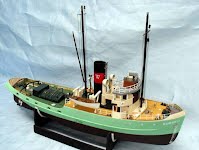 |
| Sir Francis Drake / Sir Walter Raleigh | This class of tenders & passenger carrying tug was constructed in 1908 by Cammel Laird of Liverpool for the Great Western Railway Co. The two craft were stationed at Plymouth. These craft were used to carrying passengers out to larger ships and as excursion steamers for holiday makers hence the extensive bridgework as this area was used as a bridge / boarding platform for alongside the larger ships. They were also fitted with towing hooks because of there secondary function as tugs with there short hull length / beam ratio and twin powerful steam engines these craft made a useful and powerful addition to the tug fleet when required and created extra incomen, they were used in this form in the Off season when the deck obstructions were removed. Details of the kit Details and construction are similar to the rest of our models comprising of GLASS FIBRE HULL and BULWARKS, plastic s/structure, metal & resin fittings, a set of BRASS ETCHED FITTINGS, plus rudder, props & shafts. A Full size plan & comprehensive instruction book including details on powering these diminutive models with a standard servos giving main drive motor & electronic speed control are also included. The deck planking is preprinted on self adhesive vinyl to ease construction. All kits in this range have outstanding on the water performance as part of the design. SCALE 1/96 Length 485mm Beam 130mm Van deze boot is er een tijdschrift artikel [of meer dan 1] te vinden op de pagina Modellen Tijdschrift Artikelen [Deze pagina is alleen toegankelijk voor VMBC het Anker leden] | 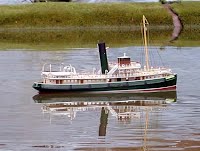 |
| Sisapon | This 1/96 scale addition to the Compact kit range is the H.M.S. ROYAL MARINE in her outfit after her service in WW11. She was converted to a working trawler a fairly major conversion as she was stripped down to her bare hull and rebuilt, after which she was based in Fleetwood for a number of years. She was later modified again (slightly) and served the rest of her days in Hull. The military class of Naval Trawlers were constructed by Cook Welton & Gemmel ltd of Beverly who launched 75 Trawlers to Royal navy designs based on commercial ships. The Royal Marine was ordered on 20-3-43 as part of the 43 Trawler programme. These ships had a displacement of 750 tons and were powered by one shaft steam reciprocating engine of 1.100 i,h,p giving a top speed of 11 knots. Their Weatherly qualities always of the highest order, often resulted in their being the only form of escort operative in bad weather and they could keep the seas when even destroyers were compelled to seek shelter. Royal Marine survived the war and was sold out of navy service to become the SISAPON in 1946. She was converted to a deep water trawler with diesel engines for Icelandic fishing. Details of the kit Scale 1/96 Length 619mm Beam 102mm Sailing weight 1.06kg | 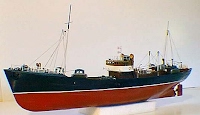 |
| SS Redshanks | Known as ”Raised Quarter Deck” coastal steamer, these small ships were larger versions of the famous “puffer” Bridge and engines were aft and the leaving a well deck forward protected by bulwarks. By far the most popular size of these vessels was between 120- 150 feet. This type of ship was used by most of the coastal sea traffic and in all of the main fleets engaged in short coastal voyages of the era. Constructed in 1920, the Redshanks is representative of the type many served until the late 1960s, and a few survive to this day. The oldest still surviving member of this class of ship is the Robin, which is now based in London at Canary Wharf and will be part of the New London Museum The kit is based on a ship that sailed from the Port of Ponders Bridge, near Ramsey, Cambridgeshire. She served the East Coast ports with general cargo and coastal passengers from the Humber to the docks of London until the late 1940,s when she was sold out of service. She was powered by compound machinery giving top speed of 9 knots on a tonnage of 287 tons gross No records are available of her subsequent fate, but she is believed to have been converted to a sand dredger with a priestman grab crane mounted forward. Details of the kit Scale 1/96 Length 403mm Beam 69mm Sailing weight 550g | 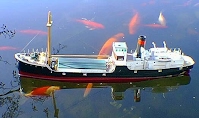 |
| Seaman | This attractive little tug that has charm in abundance is based on a full size vessel built by Cochranes of Selby in 1924 for the United Towing co. of Hull and was the first purpose built sea going tug owed by this famous company. scale 1/96 Length 400mm Beam 90mm | 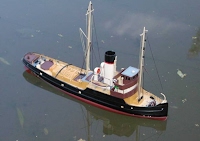 |
| Trilight | This new addition to the Compact kit range is to the slightly larger scale of 1/72 to give more working room in the model and to make the kits more suitable for the railway modeler. The details and construction methods used in the craft are the same as in all the kits in the Compact Kit range. The little “Puffer” is most probably one of the best known small craft in the U.K. Built in huge numbers in every variation possible, some are still in steam today. For a small, “cute” little model that is fun to sail in everything from the garden pond upwards the little Trilight has simplicity and charm in abundance. Details of the kit Scale 1/72 Length 269mm Beam 70mm Sailing weight 459g | 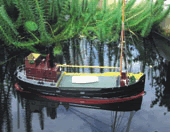 |
| Vospar Tobruk | The startling contrast between this simple little ship and the four GM corvettes now being built in Italy (1980) vividly demonstrates the change of stance of the Libyan Navy in less than a decade. This ship is classed as a MK1 B and is a repeat of the 1A class of ships that were constructed for Ghana. The weapons fit are impressive for such a small craft, consisting of one DP 4” gun, four 40mm single bofors in powered mounting and 5 x 2” rocket flare launchers. Being the first ship of any size built for the Libyan navy, she was built to a very simple specification and also included in the design was state accommodation for her to serve as a presidential yacht. To this end she carries a crew 0f 5 officers and 58 men. The Tobruk is fitted with lower power engines than the latter i,e, two Paxman Ventura 16 YJCM diesels with an output of 3,800 HP on two shafts giving a top speed 18knots . Her displacement is 500 tons full load with a draught of 13ft. As far as is known she still serves this function, and is still afloat and active. She was later refitted with two modern 40mm in single mountings with radar control. Details of the kit Scale 1/96 Length 560mm Beam 95mm Sailing weight 1.6kg | 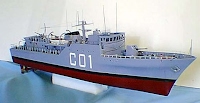 |
| Air Sea Rescue Launch “128” | The PROTOTYPE OF THE MODEL served in Malta throughout the siege and she was credited in saving the lives of 106 Airman and many enemy Aircrews. With a top speed of over 30 knots these sports cars of the fast launch world are so well known that the outline of these craft formed part of the badge of the H.S.L's crews. SCALE 1/24 Length 812mm Beam 215mm The Model, The hull of this model is moulded in lightweight glass fibre, with a moulded in rubbing strip that forms a seating for the 1.5mm PLASTIC deck. The superstructure cabin is a vac forming in HI Impact styrene sheet. All of the deck structure parts are in pre-printed 1mm colour plastic. To complement this most attractive model a full set of fittings in cast metal and resin are included along with propeller shafts, tubes and rudders. To assist in the construction a FULL SIZE COLOUR PLAN with digitally embedded pictures of the prototype model is provided along with a complete set of comprehensive instructions, plus a set of decals to give a colourful finished model. | 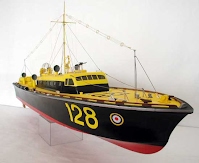 |
| ASR 63' | The design of these Air Sea Rescue launches was an adaptation of a Motor Gun Boat being developed by British Power Boats for the Royal Navy, (see the M.G.B. in our range). These craft were the first to be fitted with aircraft type turrets from the start. After experience in the Channel these vessels earned a great reputation amongst their crew members. The racy lines of the craft added a touch of glamour when the outline of the type was used for the arm badge worn by the crews. Although the Whalebacks saw service around the coasts of Britain, some of the type were sent to the Med and to the coasts of India. During the Dieppe raid when some of the craft were attacked and sunk with loss of life they were more heavily armed with a 20mm machine cannon on the stern (see the B.P.C.63ft) Details of the kit Scale 1/24 Length 812mm Beam 215mm Sailing weight 1.8kg The 2 models in this range of craft are based on a lightweight glass fibre hull capturing the racy lines of the prototype. The deck is of 1/8" resin bonded marine plywood fitted to the top of the rubbing strip which is moulded into the hull for easy construction. | 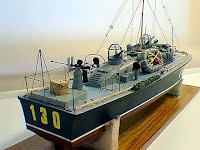 |
| Crash Tender | The two boats in the class 93 & 94 of the 46ft Crash & Rescue tenders were constructed by Vosper Ltd of Portsmouth in1952 for the R.A.F. The hulls were of double skin mahogany on birch plywood framing. Powers was from two Rover Metorite engines of 375 hp each, This was a 8 cylinders V type engine of 18 litres Drive was to 2 X 3 blade props (both rotating the same way) Giving a top speed of 28 + knots Fire fighting was from two 3.5” fire monitors that could spray water of foam. The power for the pumps was from a Ford V8 engine to give 5-600 g.p.m. This pump was also be used as a salvage pump. For rescue work she was fitted with a spring tow hook, line throwing equipment and rockets, stretchers and a portable davit. The two craft were taken into service in 1952-53 at Calshot. They spent many year as experimental craft for it is alleged that they were designed to complement the SARO princess flying boats that spent many years at Calshot. The craft were reported to have startling acceleration and could stop in there own length once the automatic 7 sec time delay came into effect on the reverse gear. They had a turning circle of three boat lengths at 28,5 knots. Both boats were sold from service in 1958. Details of the kit Scale 1/24 Length 610mm Beam 180mm Sailing weight 2kgs The kit is based on a detailed glassfibre hull with rubbing strip, fender strip, proptube and rudder exits, moulded into the hull. The Deck is from 1mm printed plastic. Vac-fomings supply the nicads battery tray, rudder servo mount and motor mounting for the internals. Vacformings in clear styrolux form the forward and aft cabin assembly. Printed plastic supplies the construction for the aft cockpit. A new system for clear windows has been developed for this model consisting of computer cut masking film which is fitted onto the clear mouldings, the cabin is then primed and painted and the film removed. Computer cut "aluminum" frames fitted onto the clear plastic for windscreens etc, cabin windows, skylights etc. Cut window frames are then applied over the edge of the clear parts. This removes one of the jobs that modelers tell us they dislike, that of cutting our complicated windows from mouldings, all similar sizes, with complex corners. A full set of fittings in cast alloy and resin is included in the kit , along with propshaft,proellor, rudder, and tillers arm, plus decals for that finishing touch to this colourful model. To aid construction a comprehensive instruction book and full size plan is included. The full size craft were noted for their rocket like acceleration and stopping ability, plus outstanding handling. The model with its boat weight of 970gms and powered by its recommended black 400 motor and nicads gives all handling characteristics of the full size craft, i,e it is a delight to drive. Deans Marine wish to express there appreciation to VOSPER THORNYCROFT Ltd of Southhampton for the invaluable help they have given us from the archives, plans, and the photographic section without this help and assistance the project for this delightful, and well known craft would not have been possible. | 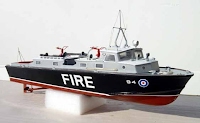 |
| D Class MTB | The ‘Dog Boats’ - the D class Fairmile MTBs and MGBs - formed one of the classes of wooden boat produced by the Fairmile Marine Company. The history of that company is a tribute to one man’s vision and drive and to the positive and speedy decision-making that resulted from the existence of an urgent requirement: exactly the conditions that existed in 1939. It is remarkable that such decisions had to be taken with so little long-term planning to make rapid expansion possible, and that the man, Noel Macklin, should be there ready to take risks and invest money, even before the slow response and reactionary thinking of the Admiralty had taken only faltering steps. The type D was produced to combat the known advantages of the German S-boat [from Schnellboot, but always called E-boats by the Allies]. Their low silhouette and excellent sea-keeping qualities were much sought after, and they were more heavily armed that the British ‘short boats’. The lines of the D were developed at the Admiralty by William John Holt, then head of the boat section of the Royal Corps of Naval Constructors. The distinctive hull form was developed, figuratively speaking, by splicing a destroyer type bow on to a fast motor boat stern. The hull form was tested in the Admiralty Experimental Tank at Haslar towards the end of 1939, though with the testing of variations it was not to take its final shape until March 1941. It was then linked with the powerful American Packard petrol engine, again provided under Lend-Lease, with four engines, and four propeller shafts fitted into the wide after hull. Fairmile construction techniques had proved themselves, and the D type was built in some thirty small shipyards in the UK, being supplied in kit form, as for the previous designs. The prototype D, MGB601, was constructed by Tough Brothers at Teddington on the Thames, and not far from Cobham. She was laid down on 1 June 1941, lauched on 4 October, and after trials, handed over on 20 February 1942. Details of the kit Scale 1/24 Length 1.46m Beam 2580mm Sailing weight 5.4kgs Our Representation Model MTB605 in November 1944, armed with one 6-pounder gun on a Mark VII mounting, two twin .5-in machine guns on Mark V [power] mountings, two twin .303-in Vickers machine-guns (not shown), one twin 20-mm Oerlikon on a Mark IX mounting, one 6-pounder gun on a Mark VI mounting, two 18-in torpedo tubes, two depth charges, a single 2-in rocket flare launcher and provision for mines. Glass fibre detailed hull, 1.5mm Plastic deck and superstructure, 1mm Printed plastic details, Colour code printed superstructure, Vacformed details, liferafts, gun cabs etc, Moulded motor mounts, Pre-printed deck paneling, Full metal fittings set, Cast resine fittings Stainless steel Propshafts, propellers, & skegs Full size full colour plan WITH EMBEDDED HI RESOLUTION COLOUR PHOTOS and full colour detailing of metal, plastic and resine parts, Digital instructions, Pre- cut waterproof vinyl Decals set. | 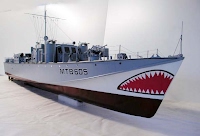 |
| Dimarcha | When a designer builds a yacht for his own use it is intriguing to see just what he has got up to. When the designer is Commander du Cane, of Vospers, the whole thing becomes even more exciting. First of all, the statistics - ‘Dimarcha’ is 60 ft in length overall, 51 ft 9 in on the waterline with a maximum beam of 17 ft. 03/4 in and in greatest draught, of approximately 5 ft. She is mainly of plywood construction, and is a big boat for this form of building, while twin G M diesels each developing a maximum of 323 s.h.p. will drive her along at about 19 knots at full throttle or 16.1/2 knots at cruising revolutions. Such are the bare bones and though mildly interesting in themselves they need to be clothed with a bit of detail of whys and wherefores. Sticking everything in the stern; having the sound insulation carried out by experts specialising in such work; and flexibly mounting both the engines and vee drives as has been done here, has led to an exceptionally quiet vessel where one is only just conciooous of the motors when in the saloon or wheelhouse. All the steering is intended to be done by an S.G.Brown automatic pilot and by twiddling a milled knob this can be adjusted for a new heading quite readily enough for Commander du Cane to manoeuvre the vessel up the crowded Hamble River by this means alone. The auto-pilot can be overridden by a small lever on the steering panel which simply applies helm in the direction required. If one tires of this lever there is a miniature wheel which can be used in the conventional manner while there is also a steering position on the sun deck. All the work is done on an electro-hydraulic system . Also in the wheelhouse are the presentation for the Decca 202 radar, the Armo-Brown gyro compass (which is part of the auto-pilot system) plus an overhead aircraft compass, the Hecta echo sounder, Woodson ship-to-shore radio and Woodson d/f set. A veritable Alladin’s cave, in fact. There is also of course, all the engine instruments and single lever controls. The vessel is still alive and well having been re-named a number of times througout her history. She is now the M Y Angela and is working out of Chania in Crete providing cruises around the islands of Theodorou and Lazaretta. Details of the kit Scale 1/24 Length 780mm Beam 230mm Sailing weight 1.6kgs Glass fibre detailed hull, Light weight glass fibre deck, Moulded clear Styrolux Cabin, Moulded clear canopy, Vacformed Boston whaler kit, Moulded motor mounts, Moulded deck recess, Pre-printed deck paneling, Vinyl cut vinyl “wood” panels, Vinyl cut “Aluminium” window frame, Pre cut masking films, Full metal fittings set, Cast resine fittings, Propshafts, propellers, & skegs, Full size plan, Digital instructions, Decals set. | 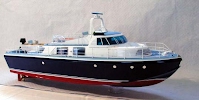 |
| Dufresne | Said to be one of the finest pleasure craft ever built in New Zealand. She is the 65ft twin screw motor yacht, Dufresne, designed by Laurent Giles and partners of England for Mr Jack Butland of Auckland, and built by M.C. Carter Ltd. Laurent Giles is noted not only for the excellence of his designs, but also for the very distinctive character and good looks of his boats. Dunfresne is no exception, and the workmanship of her New Zealand builders matches the high standard of her design. Mr Butland and Mr Carter went to England to discuss both design and construction methods with Jack Giles in November, 1964, and found that they had not yet used glued construction to the extent that we have in the U.K. Max Carter took with him photos of some of the local boats built by the methods he wanted to use, and Mr Giles was most impressed with them and keen to see so much laminating used in the proposed boat. He was, however, a little taken aback at the idea of building such a large boat upside down. The hull design was left entirely up to Laurent Giles exept for a suggestion that she could have more beam. This was increased by 18in at the deck but the bottom shape, which had been tank tested,and was not altered. Building started on May 19,1965 and she was launched on October 1, 1966. One of the first jobs and the biggest laminated member was the stem. Construction is unconventional, there are no floors in the boat other than at the main bulkheads. These are replaced by 2 3/4 x 3/4 ribs from gunwale to gunwale dinghy fashion, at varying centres according to positions but averaging about 2ft spacing. Ordinary spotted gum timbers were fitted at 7in centres with multiple light stringers of 2 3/4 by by 3/4, running force and aft. Planking is two diagonals of 1/4in, and one fore and after outer skin of 9/16in, all Epiglued and through fastened. It was estimated that in 1965, half a ton of nails and over £1000 worth of glue were used. The complete hull was sheathed in dynel before being turned over. The whole constuction is unusually light for a boat of this size but undoubtedly very strong. Dufresne`s probable top speed is 15 knots at 3,000 rpm and 13 knots cruising speed at 2,500. The hull is of a round bilge high speed displacement type and an unusual feature is the knuckle built into the topsides for`ard. The fast displacement hull needs a fine entry and the knuckle allows this while still gaining plenty of reserve bouyancy very quickly. It also gives the effect of a big flare without excessive width on the decks, and makes the boat relatively steady and dry in a seaway. Mr Butland has named his boat after the famous Frenchman Marion du Fresne (pronounced du Frain), who came to N.Z. in 1772 in his ship Marquis de Castries, in company with Lieut. Crozet comanding the Mascarin. They spent several months in the Bay of Islands carring out repairs and du Fresne was the first person to survey the area. He also attempted to claim New Zealand for France and called it France Australe, although he knew Captain Cook (1769) had already claimed it for Great Britain. History books record different versions of the events leading up to his violent death. Some say it was revenge for the cruelty of another Frenchman, others that Marion du Fresne and his crew were the friendly with the Maoris until they inadvertently desecrated some sacred tribal ground. However, it is a fact that du Fresne and about 20 of his crew were enticed ashore, killed and eaten in the Bay of Island. Details of the kit Scale 1/24 Length 825mm Beam 203mm Sailing weight 3.8kgs The kit is based on a detailed glassfibre hull with rubbing strip, bulwark scrollwork, proptube and rudder exits, moulded into the hull. The Deck is from printed plywood with lining for engraved planking. Vacformings in styrene form the complete cabin assembly and ships boat. Printed plastic supplies the construction for the wheelhouse cockpit. A full set of fittings is included in the kit with propshatfs, rudders, prop and tillers arms, plus decals and details to complete the wheelhouse To aid construction a comprehensive instruction book and full size plan is included. Printed plastic supplies the construction for the wheelhouse cockpit. A full set of fittings is included in the kit with propshatfs, rudders, prop and tillers arms, plus decals and details to complete the wheelhouse interior To aid construction a comprehensive instruction book and full size plan is included. | 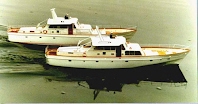 |
| Dutch Police | This is a limited edition kit. The production batch has been run and is now closed. At the present time there are no plans for further Production. STAN P 47 DUTCH POLICE LAUNCH STAN PATROL 1800 P57 “GORINCHEM” Scale 1/20, Length 950mm, Beam 250mm, Weight 7 Kg ( R.A.M.B. kit ) The R.A.M.B. type of kits is a new venture in the Deans Marine range of kits. The format of these kits is to choose a model that contains some very complicated construction parts, and do all the very difficult parts as a completed assembly. This kit come with a moulded hi-impact styrene hull and deck, props shafts, rudders and all linkages are pre -installed, the deck is fitted and the hull is painted, the superstructure is assembled and painted, the window frames and glazing are pre-fitted, The mast assembly is constructed from soldered brass tube/rod and is a complete item, with a folding top mast, all lights and Ariel's are pre-fitted, this is also painted, all that is required to do, is bolt the mast to the rear of the cabin and fit the top mast, the HI-HAB crane is pre-assembled and only requires fitting in place along with the pre-made sea raider inflatable, all railings are again pre-soldered and only require fittings to the pre-drilled holes in the deck. Stainless steel prop-shafts are included in the kit along with 2 handed brass propellers, with recommendation for motors, couplings, speed controllers, alternative power units and propellers. An instruction book with assembly details plus hints/tips, there is also a set of colour decals included to complete this attractive and colourful model of the latest high speed Police Launch in service in Holland. Fitted with the recommended twin motors and multi channel radio gear this outstandingly fast and manoeuvrable model is a joy to drive. | 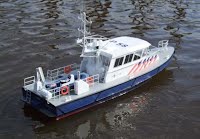 |
| HSL 2661 | In 1942 the RAF were looking for a suitable type of HSL to replace existing 64ft and 63ft designs. Three designs were chosen the 67ft Thornycroft being one of them. The specs called for a craft more suited for use in the western approaches in its particular severe weather conditions. It had better accommodation for the crew and more space in the sick bay. This type of launch was well liked by its crew for its gentle ride and its well equipped galley. As can be expected from a builder with such a renowned reputation for the construction of motor yachts the 67ft had a “yacht” like appearance and superb detailing and finish. The 67ft was designed from the outset for rescue work. Speed was sacrificed for greater range and comfort. The MK1B was powered by twin non-handed Thornycroft RY/12/1 engines giving 650BHP at 2000 rpm through Vee drives giving a max sped of 24.5 knots with a range of 350 miles, extra fuel was carried on the deck in racks to extend the range when required. Most of the class in this range were stationed in UK waters for WWII, and were disposed of in 1946/47, HSL 2661 was recoded as being written off in May 1947. SCALE 1/24 Length 850mm Beam 210mm The Kit is based on a lightweight glass fibre hull capturing the racy lines of the prototype. The deck is of 1.5mm H.I.P. plastic fitted to the top of the rubbing strip which is moulded into the hull for easy construction. The complete superstructure moulding, along with the gun cabs and the dinghy, plus the battery boxes, are all in vacformed plastic to speed construction. The gun turrets are formed in clear acrylic along with a full set of weapons and fittings. A Full size COLOUR Plan and comprehensive instructions including many digital pictures, plus a set of decals to give a colorful finished model. As in all of the Deans range, the on the water performance is outstanding. | 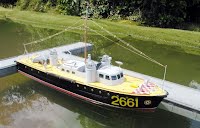 |
| Lady Beale | This launch is based on Thames launches constructed around 1920 and used on many rivers, estuaries and lakes in the U.K. Many are still in regular use and are often seen at boat gatherings in many parts of the country. Scale 1:10 Length 720mm Beam 160mm This kit is based on a glass fibre hull with rubbing strip and detail moulded into the surface of the hull. The deck is also supplied as a glass fibre moulding The deck planking is supplied cut to width in Mahogany and Obeche. A full set of fittings in cast alloy is included in the kit, along with a full size plan and a comprehesive set of instructions. | 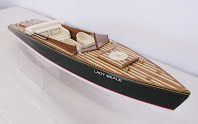 |
| Lady of Wroxham | This launch is based on one of the many Ex service launches constructed around 1920 and used for general duties in rivers, estuaries in the U.K. for the Royal Navy. Constructed from the very best materials, and designed to be worked hard, they were then sold out of service and used as work boats and for pleasure craft. Many are still in regular use and are often seen at boat gatherings in many parts of the country. The particular craft we have modelled is of a launch based on the river Thames and is used as a day boat and picnic launch. She is powered by a modern Perkins diesel engine and is designed to be as silent as possible, the forward accommodation consists of 2 x bunks, a small kitchen and heads plus storage space. The kit is based on a glass fibre hull with rubbing strip and detail moulded into the surface of the hull. The deck planking is supplied cut to width in Mahogany and Obeche. A full set of fittings in cast alloy is included in the kit, along with a full size colour printed plan and a comprehesive set of instructions. SCALE 1/15 Length 720mm Beam 160mm | 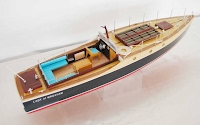 |
| MASB | British Power Boat Co. 63ft MOTOR ANTI-SUBMARINE BOAT "M.A.S.B." These high speed craft were designed and constructed in 1941 by British Power Boat Co for the Royal Navy as coastal Anti Submarine craft. Power by 3500 b.h.p Power Napier sea lion engines giving a top speed of 30 knots,. The craft were numbered from 22-39 + 49 The concept was that the craft sat in harbour and when a surfaced submarine was spotted these fast craft left harbour at high speed and attacked the submarine with depth charges. The twin .5” Vickers machine guns were used to keep the submarines guns crews suppressed. As these craft had no asdic fitted and the only methods of finding a submerged submarine was to stop and lower a hand held hydrophone over the side it quickly became clear that the concept was flawed from the start. These craft were then used a Motor Gun Boats, but as they only carried light weapons and the top speed of approx 30 knots loaded they came off the worst when faced with German E boats with armed with 20mm machine cannons and a top speed of 40 knots. At the time, early19 41-42 they were used in the coastal force battles in the narrow seas of the channel as M.G.B.s the depth charges were dropped close to the enemy ships in the hope that the explosion would damage the hull, lightly armed and with 3000 gallons of high octane fuel aboard they suffered horrific losses until replaced with more heavily armed craft. Later used as Rescue launches even in this they were not effective as the access to the cabin was complicated and there was no space for stretchers for any wounded airmen and the harsh ride in anything but flat calm was very uncomfortable and could result in broken bones for the rescued survivors. SCALE 1/24 Length 812mm Beam 215mm The model of this craft, is one of the fastest M.A.S.B. to serve during W.W. II, with a top speed of over 30 knots. The hull of this model is moulded in lightweight glassfibre, with a moulded in rubbing strip that forms a seating for the 1.5mm PLASTIC deck. The superstructure cabin is a vacforming in HI Impact styrene sheet and all deck Structure parts are in pre-printed 1mm colour plastic. To complement this most attractive model a full set of fittings in cast metal and resin is included along with propeller shafts, tubes and rudders. To assist in the construction a FULL SIZE COLOUR PLAN with digitally embedded pictures of the prototype model is provided along with a complete set of comprehensive instructions, plus a set of decals to give a colourful finished model. |  |
| Melita | The twin screw motor yacht Melita was designed by Laurent Giles ltd of Lymington, to very exacting specifications laid down by her owner. She was to be based in the UK and had to be fitted out for long range cruising in home waters. The main cruising area would be the MEd, and for this purpose she was designed to be seaworthy enough the cross the Bay of Biscay in one trip, no small task for such a small vessel. when on station she is a motor cruiser, or lose footed main and a mizzen sail can be hoisted for sail assistance. to take advantage of the warmer climes in the MEd the wheelhouse roof and windows are retractable for open top sailing. For home water cruising the mizzen mast can be stepped amidships, the boom is then used as a derrick to handle the ships boat. Truly a Multi boat in the full sense of the word. The owner at launching was Wing Commander R.G. Grant Ferris m.p. She was designed by Laurent Giles in 1963. constructed by Moodys boatyard to Lloyds 100A1 and launched in 1964. She is still afloat today and is little changed in her style, At the present time she is the owner is the Commodore of the R Y S, so she can fly the Commodores pendant and the White ensign. Deans Marine wish to express their appreciation for the kind assistance from Laurent Giles Ltd without whose help this project would not have been possible Details of the kit Scale 1/24 Length 750mm Beam 178mm Sailing weight 2kgs The kit is based on a detailed glassfibre hull with rubbing strip, bulwark scrollwork, proptube and rudder exits, moulded into the hull. The Deck is from printed plastic with a self adhesive 1mm Maple veneer for planking. Vac-formings in clear styrolux form the complete cabin assembly and ships boat. Printed plastic supplies the construction for the wheelhouse cockpit. A new system for clear windows has been developed for this model consisting of computer cut "wood" fitted with cut "aluminium" frames fitted onto the clear plastic for windscreens etc, cabin windows, skylights etc have computer cut masking film which is fitted onto the clear mouldings, the cabin is then painted and the film removed. Cut window frames are then applied over the edge of the clear parts. A full set of fittings is included in the kit with propshatfs, rudders, prop and tillers arms, plus decals and details to complete the wheelhouse interior, we even supply the carpets. To aid construction a comprehensive instruction book and full size plan is included. | 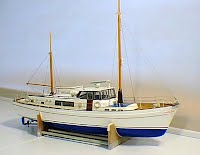 |
| MGB 77 | Following the design of the SGB and its shortcomings, The Admiralty working in conjunction with British power Boats designed a MGB to fill similar duties but with the simpler construction than that of the SGB design. In 1941 the type 74 design was produced with similar lines to the 1938 PV design but with a considerably stronger structure. This batch is based on one of this group commanded by Lt Cmd Hitchens of “E Boat alley” fame. The success of this design resulted in a second order in 1942 for the craft with order for boats from numbers 107 -176. They were powered with 3 shafts x 3 Packard engines giving 4,050 BHP with a top speed of 42 knots in good condition. Weapon fit was one 2pdr gun and a twin 20mm powered mount and two twin 303 Vickers or Lewis gun on pedestal mountings. She carried a compliment of 12 officers and crew Details of the kit Scale 1/24 Length 920mm Beam 270mm Sailing weight 2.9kg The model of this craft, one of the fastest M.G.Bs. to serve during W.W.11, with a top speed of over 40 knots. The hull of this model is moulded in lightweight glassfibre, with a moulded in rubbing strip that forms a seating for the 1.5mm PLASTIC deck. The complete superstructure cabin is a vacforming in HI Impact styrene sheet and all deck structure parts are in preprinted 1mm colour plastic. To complement this most attractive model a full set of fittings in cast metal and resin is included along with propeller shafts, tubes and rudders. To assist in the construction a FULL SIZE COLOUR PLAN with digitally embedded pictures of the prototype model is provided along with a complete set of comprehensive instructions, plus a set of decals to give a colourfull finished model. As in all of the Deans range, the on the water performance is outstanding. | 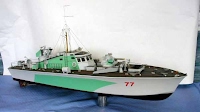 |
| Monitor 60 ft. | The programmed 4 monitors were converted from ex-army LCM 6 for use by the riverine forces in Vietnam. they carried a formidable array of weapons in there hulls. Most were fitted with a main gun turret of 40mm with a co-axial .5” machine gun. A 20mm in a turret, plus two .5” in side turrets up to four 30 cal machine guns and in he well forward of the bridge a 81mm mortar with a top mounted .5” machine gun. Truly a battleship of the waterways, the hull and bridge was covered in steel bar Armour to detonate R.P.Gs at a safe distance. Details of the kit Scale 1/24 Length 769mm Beam 205mm Sailing weight 6.1kg The model is based on a glassfibre hull with full plating, freeing ports, side extensions and prop shafts tunnels moulded into the hull. Computer generated plastic printed in 6 colours is used for the decks and superstructure to give quick and crisp assembly. A full set of fittings in cast light alloy and plastic including the vast array of assorted weapons give the finishing touch to the model adding the vital clutter that is so much part of the MONITORS appeal. To complete the model and to add the extra fine detail finish, a sheet of brass etchings is included along with the glass fibre main turret and the resin cast secondary turrets. The exclusive “bar” Armour is also included as cast light alloy fittings. As in all of the Deans kits a set of running gear is included, consisting of the propshafts, props, and tillers. A full instruction book keyed to a FULL SIZE plan to assist in the construction of the model. | 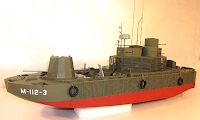 |
| Motor Gun Boat 63 ft. | The design of these Air Sea Rescue launches was an adaptation of a Motor Gun Boat being developed by British Power Boats for the Royal Navy, (see the M.G.B. in our range ). These craft were the first to be fitted with aircraft type turrets from the start. After experience in the Channel these vessels earned a great reputation amongst their crew members. The racy lines of the craft added a touch of glamour when the outline of the type was used for the arm badge worn by the crews. Although the Whalebacks saw service around the coasts of Britain, some of the type were sent to the Med and to the coasts of India. During the Dieppe raid when some of the craft were attacked and sunk with loss of life they were more heavily armed with a 20mm machine cannon on the stern (see the B.P.C.63ft) Details of the kit Scale 1/24 Length 812mm Beam 215mm Sailing weight 1.8kg The 2 models in this range of craft are based on a lightweight glass fibre hull capturing the racy lines of the prototype. The deck is of 1/8" resin bonded marine plywood fitted to the top of the rubbing strip which is moulded into the hull for easy construction. The complete superstructure moulding, along with the carly float, battery box, are all in vacformed plastic to speed construction. The gun turrets are formed in clear acrylic along with a full set of weapons and fittings to complement the FULL SIZE PLAN and instructions. | 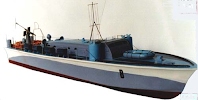 |
| MTB 385 | The third series of M.T.B.s entered service in 1944 and differed from earlier boats in having four tubes instead of two mounted on a flush deck. They had a compliment of 13 men and carried 3 Packard engines as a powerplant. Easily reaching 35 knots gave the craft the edge over many attacking vessels. They were well armed for their size, carrying a twin 20mm Oerlikon. Four 21” torpedo tubes, two twin 303 lewis guns and two rocket flare launchers. M.T.B..s. usually lay in wait under cover if darkness with their engines off and fired their spread of torpedoes. If discovered they started the engines and tried to avoid any counter measures by sheer speed. Details of the kit The model is in the well know scale of 1/24 which gives great scope for detail and an easy to construct kit range of craft, based on a light weight glass fibre hull capturing the racy lines of the prototype. The deck is of 1.5mm high impact plastic fitted to the top of balsa and ramin deck beams which details are supplied in the instructions for the modeler to fit in to the hull for easy construction. The complete superstructure is constructed from 1mm & .5mm printed plastic, Vacformed plastic mouldings, for the carly float, gun base ring, and battery box, to speed construction. The kit is complete with running gear and along with a full set of weapons and fittings to complement the FULL SIZE PLAN with embedded color pictures and a full instructions book | 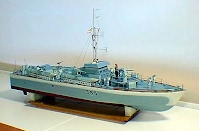 |
| MTB 488 | MTB 476 was a former British Power Boat MGB that was reclassified as an MTB. She was fitted with two 18” Torpedo Tubes and a power operated 6pdr gun was added forward plus a twin 20mm Oerlikon aft. They were powered with 3 shafts x 3 Packard engines giving 3,600 BHP with a top speed of 39 knots in good condition. The lower top speed than her sister was due to the extra weight carried by the 6pdr gun and the two torpedo tubes Weapon fit was one 6pdr gun and a twin 20mm powered mount and two twin 303 Vickers or Lewis gun on pedestal mountings. She carried a compliment of 12 officers and crew Some of the 400 class were transferred after the war to the Royal Neth Navy in1943 and in 1944 numbers 459 - 466- 486- 491 to the Royal Canadian Navy. The alternative Pennant numbers 488 was a craft commissioned on Sept 6th 1944 by her C.O Sub Lt G. F. INNES R.N.V.R. This craft was powered by 3 x Packard Marine engines with a total B.H.P 4050 giving a speed of 39 knots max and a range of 600 miles at 15 knots. She carried a crew of 17. Details of the kit Scale 1/24 Length 920mm Beam 270mm Sailing weight 2.9kg The hull of this model is moulded in lightweight glassfibre, with a moulded in rubbing strip that forms a seating for the 1MM PLASTIC deck. The complete superstructure and all deck structure parts are in preprinted 1mm colour plastic. To complement this most attractive model a full set of fittings in cast metal and resin is included along with propeller shaft, tube and rudder. To assist in the construction a FULL SIZE PLAN is provided along with a complete set of comprehensive instructions, plus a set of decals to give a colourful finished model. As in all of the Deans range, the on the water performance is outstanding. | 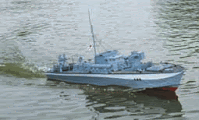 |
| PBR Cannedheat | n 1965 a river patrol force was formed to control the rivers of Vietnam designated “Game Warden” and was controlled by the U.S.Navy. They had no craft suitable for the work, and the press of time precluded the normal design processes. Approaches were made to the commercial market, and a craft was found that generally matched the requirements. In 1965 the firm of United boat builders of Bellingham, Washington, started the first of the MK1 PBRs with an order for 160 of these craft. The craft was a 9.5 meter fiber glass boat powered by two water jets and were capable of 25 knots. In 1967 a further order for 80 boats was placed with modifications reflecting operational experience, these were designated MK11 (the subject of our kit). When the craft were in service, with weapons and extra weight, plus water absorption into the hull they were well over 1000 kgs overweight, hence the bows down attitude at rest. The craft served throughout the Vietnam war, and many were retained by the Vietnamese forces after the departure of the American forces. Details of the kit Scale 1/24 Length 430mm Beam 145mm Sailing weight 2kgs A departure from the norm with this new addition to the fast launch range of kits that makes a excellent companion for the Swift boat in our range. The kit of this well known fast craft is based on a one piece vacformed hull. To speed assembly the deck, wheelhouse, motor mount, and nicads tray are also vacformed in styrene. As with all the Deans range of kits, a complete set of fittings is included, plus all the weapons carried by these heavily armed fast craft. A full size plan, and comprehensive instruction book aid assembly, and to add the finishing touch a complete set of decals in precut waterproof vinyl and self adhesive crests. Due to the light weight of the model, the on the water performance with 6 volts and the recommended motor is outstanding, and with its short waterline length and the forward propeller and shaft set up, fast torque turns are possible, if nerve racking. This model is also available with a lightweight glass fiber hull moulding at extra cost, for modelers well used to working in this medium and wishing to fit one of the small jet units available on the market | 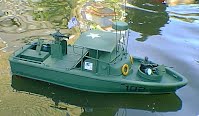 |
| PCF Swift | One of the larger types of craft used in the task of coastal and riverine patrols in the Vietnam war was the PATROL CRAFT FAST. This craft was adapted from a commercial design for oil rig support work in the bay of Mexico. About 200 PCFs were constructed between 1965 and 1966 all by the firm of Sewart Seacraft of Berwick, Louisiana, U.S.A. The craft we have modeled is a type 1 with a displacement of 19.3 tons of which 104 were built that were sent to Vietnam between 1967 -1970 and smaller numbers to Cambodia. As in all wars the craft grew in weight as time progressed and this effected the performance and handling. Many pictures of the craft in action shown the craft with a distinct bows down attitude and pushing a large bow wave in front. The weapons for of the type 1 was 2 x 12.7mm (.5”) machine guns in a forward turret and one 12.7mm mounted on top of a 81mm mortar in a single mounting. Personnel weapons were also carried, mainly AR15 and M16 rifles plus often a M19 machine guns for close range work.>br> Power was supplied by two 480 hp General Motors diesels giving (empty weight) speed of 28lnots and a range of 400 miles, The craft carried a crew of 6. Many were exported to other countries and served in Cambodia, Philippines, South Korea, South Vietnam, Thailand, U.S.A, Brazil, and Zaire. Details of the kit Scale 1/24 Length 604mm Beam 180mm Sailing weight 2kgs This model is constructed on a glassfibre hull with the chine strips and the deck fender as part of the hull moulding. The superb hull lines of the original design have been faithfully reproduced to give this model the outstanding seakeeping qualities of the original vessel. The complete superstructure and all deck structure parts are in pre-printed 1mm colour plastic. To complement this most attractive model a full set of fittings in cast metal and resin is included along with propeller shaft, tube and rudder. To finish this model a full set of fittings in cast light alloy and plastic are supplied. A FULL SIZE PLAN and comprehensive instructions are included to assist the modeller with the construction of this most attractive model. As in all of the Deans range, the on the water performance is outstanding. | 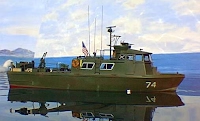 |
| Pilot No.4 | This free lance design is based on a proposed craft to be constructed by Vosper Ltd for a sea going, river pilot boat. The high forward cabin is a notable design feature to give all round visibility in congested waters and for spotting flotsam, jetsam, and the odd tree trunk that happens to be a hazard. To get out of the way of these hazards the craft is designed to have outstanding handling and a rapid response to helm and throttle commands. The full size vessel is designed to be powered by twin turbo charged diesels giving a top speed of 20 knots. The after well, plus the large cabin, give ample space for pilots awaiting vessels and for more volatile parts of the world, space for boarding parties etc. The basis for this craft was a more economic version of the P.L.4, one of the largest and most powerful pilot launches constructed in the 1950's. Details of the kit Scale 1/24 Length 692mm Beam 152mm Sailing weight 1.1kg The hull is moulded in glass fibre with the chine protection strips part of the moulding. To complete the model all the superstructure parts are vacformed in styrene plastic, along with nicad boxes, engine covers, etc for quick construction. The plywood deck has a novel and speedy method of construction for simulating the deck planking. As in all of the Deans range of models, a full set of plastic and cast alloy fittings are included in the price of the kit, along with propshaft, tiller arm and tiller. To assist in the assembly of this attractive launch, a full set of instructions are included with a FULL SIZE plan. To add the final finish, dual painting instructions are included for modern Acrylic car spray paint, or modelling enamels. | 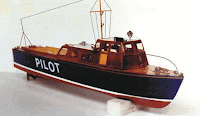 |
| Robert Peel | This model is of the Metropolitan Police launch the "Sir Robert Peel". These attractive craft are based at the Wapping Police depot on the river Thames, not far from Tower Bridge. The craft are not for show purposes but are part of the Thames fleet of Police launches and they are worked hard, requiring overhauls every 6 months. With their green hulls and light mahogany cabins they are one of the most attractive and well known craft to be seen on the river Thames. The latest craft to bear these famous names are constructed by Halmatics Ltd, on a heavy duty glass fibre hull with a hand crafted superstructure in mahogany. With a top speed of 22 knots from the power of the twin Perkins engines, they are one of the fastest of the river Police launches. Details of the kit Scale 1/24 Length 692mm Beam 152mm Sailing weight 1.1kg The hull is moulded in glass fibre with the chine protection strips part of the moulding. To complete the model all the superstructure parts are vacformed in styrene plastic, along with nicad boxes, engine covers, etc for quick construction. The plywood deck has a novel and speedy method of construction for simulating the deck planking. As in all of the Deans range of models, a full set of plastic and cast alloy fittings are included in the price of the kit, along with propshaft, tiller arm and tiller. To assist in the assembly of this attractive launch, a full set of instructions are included with a FULL SIZE plan. To add the final finish, dual painting instructions are included for modern Acrylic car spray paint, or modelling enamels. | 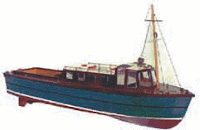 |
| Royal Barge | This craft was constructed by the Vosper yard in 1938 as the tender to the Royal Yacht "Victoria and Albert" and at the time was the last word in seakeeping qualities. She was designed and constructed as a triple screw vessel and was extensively tested by Vospers in all sea conditions. Legend has it that she is one of the finest small craft ever constructed. The barge was placed in store during W.W.11 after which she was refitted with more modern engines and automatic fire extinguisher systems. In 1947 H.M.S. Vanguard carried her for the Royal tour of South Africa and later the Royal Yacht Brittannia was modified to carry her on its davits. The barge has since been replaced by a more modern craft in the Royal Yacht and this vessel again is in store to be used for special occasions until a decision is made as to her future. Deans Marine wish to express their thanks to Vosper Thornycroft for the kind assistance in the research for this kit. Details of the kit Scale 1/15 Length 762mm Beam 203mm Sailing wieght 1.9kg This model is constructed on a glassfibre hull with the chine strips and the deck fender as part of the hull moulding. The superb hull lines of the original Vosper design have been faithfully reproduced to give this model the outstanding sea keeping qualities of the original vessel. The deck is of 1/16th marine whitewood ply, with a novel method of simulating the deck planking. The complete superstructure, the cabin wells and the spray dodger are in 1mm vacformed plastic to give fast assembly. To complete this model a full set of fittings in cast light alloy and plastic are supplied, along with decals for the boat's crest. To add the finishing touch, sets of standards for 3 members of the Royal family, and the board of Admiralty are provided. A FULL SIZE PLAN and comprehensive instructions are included to assist the modeller with the construction of this most attractive model. |  |
| RSL 1640 | The model of this craft, constructed by Thornycroft, for target towing and gunnery range safety duties, is a welcome addition to the fast launch range of kits. The hull of this model is moulded in lightweight glassfibre to give superb handling on the water, the deck is from 1mm printed plastic as is the after well and cabin internals. The complete superstructure, nicad boxes and the motor/ propshaft seating are in vacformed plastic to give light weight and fast assembly, to complement this most attractive model a full set of fittings is included along with propeller shaft, tube and rudder, and to add the finishing touch the planked deck areas are in pre-printed cast vinyl. To assist in the construction a FULL SIZE PLAN is provided along with a complete set of comprehensive instructions including many digital pictures, plus a set of decals to give a colorful finished model. As in all of the Deans range, the on the water performance is outstanding. Details of the kit Scale 1/24 Length 550mm Beam 62mm Sailing weight 1.05kg Twenty nine of theses craft were built by Thorneycroft ltd from the mid 1950s to early 1960s. They were numbered consecutively from 1640 to 1668. They were constructed of Mahogony on Oak frames with double diagonal planking with a layer of calico between the hull planks. Displacement was about 12 tons and power was supplied by 2 Rolls Royce C6SFLM Turbo-charged diesel engines of 220HP each, This gave a maximum speed of 24 knots. The radio fit of the craft was comprehensive and varied in each station All carried 1 x PTR175 UHF radio for use with aircraft and other marine craft. They all had a Pye Maritime VHF radio for use with other vessels, lifeboats, and the coastguard. Most carried a HF set for distant work Also carried was a notification to the PTR175UHF called Violet Picture. This was a direction finding device used to home the craft onto a survivors SARBE or other UHF?VHF survival beacon. Those craft in Home waters were painted gloss black above the waterline with green non-skid decks and RN light gray superstructure. The cabin tops, ventilators and the mast and ensign staff were white. There was a 2" white line around the hull at the waterline and the lower part of the hull was red anti-fouling. This turned green after some exposure to sea water. The inside of the hull and cabin was white with some varnished woodwork such as the gunwales. the numbers were white. Those serving in the Mediterranean, or east of Suez were painted white all over and had black waterline and numbers. They had the same green decks and red anti-fouling, of theses craft 1640 spent all of her career in Scotland at Lossiemouth or invergordan at 1100 MCU. Others in the range are 1645 1656 & 1666 spent time at RAF Glugnor near Penang in Malaysia and were sold the Malaysian government when the station closed in 1971. 1649 served in Bahrain 1650 in Singapore at RAF Gan in the Maldive Islands. | 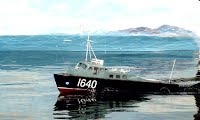 |
| Air Sea Rescue Series 1 | The design of these Air Sea Rescue launches was an adaptation of a Motor Gun Boat being developed by British Power Boats for the Royal Navy, (see the M.G.B. in our range ). These craft were the first to be fitted with aircraft type turrets from the start. After experience in the Channel these vessels earned a great reputation amongst their crew members. The racy lines of the craft added a touch of glamour when the outline of the type was used for the arm badge worn by the crews. Although the Whalebacks saw service around the coasts of Britain, some of the type were sent to the Med and to the coasts of India. During the Dieppe raid when some of the craft were attacked and sunk with loss of life they were more heavily armed with a 20mm machine cannon on the stern (see the B.P.C.63ft) Details of the kit Scale 1/24 Length 812mm Beam 215mm Sailing weight 1.8kg The 2 models in this range of craft are based on a lightweight glass fibre hull capturing the racy lines of the prototype. The deck is of 1/8" resin bonded marine plywood fitted to the top of the rubbing strip which is moulded into the hull for easy construction. The complete superstructure moulding, along with the carly float, battery box, are all in vacformed plastic to speed construction. The gun turrets are formed in clear acrylic along with a full set of weapons and fittings to complement the FULL SIZE PLAN and instructions. | 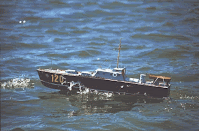 |
| Showgirl | “SHOWGIRL” is latest style of modern reflection of the famous “Maine” lobster boat. This style of the well known lobster boat was never designed to get it good looks dirty, by working for a living,? Built by some of the best ship-crafters in the US of A, these craft are for the wealthy owners who wish to “blend” in with the working boats around them in the bays and harbours of the popular Maine coastal areas. Although the Downeast lobster boat is based on an age-old design originating in Maine, the modern equivalent is more of a "feeling" and "look", than the image the name produces. Originally the boat style was indeed used to lobster, hence the large cockpit area and enclosed fore-space for when the weather took a turn. But today's lobster boat offers a bit more amenities than the watermen of Maine needed, or wanted, Downeast boats are as at home in the Chesapeake, ICW or canals of Europe as they are in the fishing waters of Maine. Constructed from the finest materials, fitted out inside to suit the most discerning owners with lots of fine timbers, marble, and best quality leathers, and fitted with the latest in mechanics and electronics, The latest reflection of the working boat is for the wealthy owners who wish to not overstate their wealth, and try to be a little less noticeable when sunning themselves on the vast stern deck or cruising around busy and crowded harbours. Today, many companies have their own version of the Maine inspired lobster boat. They share basic characteristics, like a fine bow entry forward, a fair amount of deadrise amidships, that flattens out towards the stern, a graceful shear line, a full length keel and a considerable cockpit. All of these feature combine to make a boat that is seaworthy and manageable, proven by decades of trial and error. From that point, every boat varies. The high end boats have much more to offer in details and amenities for the casual cruiser, while basic boats may be built for actual working watermen. Either way, the lobster boat is a "culture" and has it's permanent place in history. Details of the kit Scale 1/24 Length 590mm Beam 200mm Sailing weight 2.5kgs The model is based on a glassfibre hull with fender strips, hull windows, and port detail moulded into the hull. Computer generated plastic, printed in 6 colours is used for the 1.5mm H.I.P. plastic decks and 1mm plastic superstructure to give quick and crisp assembly. A full set of fittings in cast light alloy and resine give the finishing touch to the model adding the vital clutter that is so much part of this attractive luxury launch appeal. As in all of the Deans kits a set of running gear is included, consisting of the propshafts, tillers and full instructions keyed to a FULL SIZE plan with embedded colour pictures to assist in the construction of the model. Painting instructions are part of the construction notes with tips for using the latest car spray ACRYLIC paint which gives a fast and hard wearing finish. Pre-printed cast vinyl decking, Chome plating strip and detail sheet printed vinyl instruments are included in the kit along with a set of waterside decals for the final finish. | 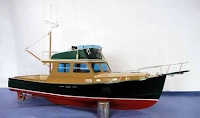 |
| ST 441 | These craft were constructed by the British Power Boat Co, Hythe nr Southhampton. They were designed by George Salman as seaplane tenders, running the crews out to moored aircraft and acting as tugs and service craft, As the war progressed and more use was made of land base they became surplus to requirements. These small handy craft were held by many to be superb sea craft and often handled bad weather that would have taxed far larger craft. Power was supplied by 2 x 130 hp Perkins s6m diesel engines giving a speed of 23 knots and were constructed between 1941 -1944 The purpose of these small air sea rescue launches was to provide a comprehensive cover of the waters around the coats and to this end it was necessary to use some of the smaller tidal harbours. It was almost impossible to use any of the larger High Speed craft for the purpose, and as there were a large number of seaplane tenders, usually the 41ft 6” power boat type these were taken up as A.S.R.s and known as air sea rescue seaplane tenders. Some of the harbours these craft worked from were Montrose, Littlehampton, Sheerness, and Lyme Regis. Some of the notable rescues by these small craft such as no 1515 operating out of Lyme Regis picked up 26 paratroops from Lyme Bay on D day and 441 is know to have rescued a complete crew of a Fortress bomber and 444 the crew of a Lancaster who were located by light signals. The craft represented by this model is one of the only surviving types of the launch still in its original condition. Details of the kit Scale 1/24 Length 523mm Beam 53mm Sailing weight 1.05kg | 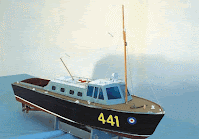 |
| Whaleback 63 ft. | The design of these Air Sea Rescue launches was an adaptation of a Motor Gun Boat being developed by British Power Boats for the Royal Navy, (see the M.G.B. in our range ). These craft were the first to be fitted with aircraft type turrets from the start. After experience in the Channel these vessels earned a great reputation amongst their crew members. The racy lines of the craft added a touch of glamour when the outline of the type was used for the arm badge worn by the crews. Although the Whalebacks saw service around the coasts of Britain, some of the type were sent to the Med and to the coasts of India. During the Dieppe raid when some of the craft were attacked and sunk with loss of life they were more heavily armed with a 20mm machine cannon on the stern (see the B.P.C.63ft) Details of the kit Scale 1/24 Length 812mm Beam 215mm Sailing weight 1.8kg The 2 models in this range of craft are based on a lightweight glass fibre hull capturing the racy lines of the prototype. The deck is of 1/8" resin bonded marine plywood fitted to the top of the rubbing strip which is moulded into the hull for easy construction. The complete superstructure moulding, along with the carly float, battery box, are all in vacformed plastic to speed construction. The gun turrets are formed in clear acrylic along with a full set of weapons and fittings to complement the FULL SIZE PLAN and instructions. | 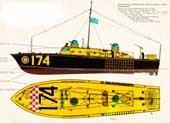 |
| Christiaan Brunings | The first of a new range of model ships to be added to the DEANS range for Steam power. The S.S. CHRISTIAAN BRUNINGS is a museum steam ship preserved in running order at the VEREENIGING NEDERLANDSCH HISTORISCH SCHEEPVAARTMUSUEM where she is kept in full working order providing trips to the public during summer season. She was constructed of steel in 1900 as tender and pilot boat to the Dutch Icebreakers and to this end she is fitted as a coastal Icebreaker in her own right. Details of the kit Scale 1/ Length 1.04m Beam 226mm Sailing weight 9.1kg This kit of a preserved steam ship is the first of a new range of model designed to be powered by a STEAM ENGINE or standard electric motor, instructions for both units are included. Plated glassfibre hull; Detailed glassfibre superstructure. Computer generated printed parts. Full set of metal fittings. FULL SIZE PLAN and instructions. Full set of vacformings, propshaft, prop and tiller. Van deze boot is er een tijdschrift artikel [of meer dan 1] te vinden op de pagina Modellen Tijdschrift Artikelen [Deze pagina is alleen toegankelijk voor VMBC het Anker leden] | 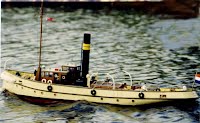 |
| Ditmar Koel | The great estuary of the Elbe is renowned for its difficult navigation, and a posting to the Elbe 1 station requires some of the best pilots on the seas. The pilot service is still of prime important despite technical advances over the years, and the Elbe 1 station has a long tradition. Named after a legendary Captain of the Hamburg authorities in Hanseatic times. The first Pilot cutter of this name was launched in 1934 at the Stucken yard. The ship is stationed in the Elbe estuary and Pilots are put aboard inbound vessels and taken of on outgoing vessels, in all but the very worst conditions. The ship has a large mess on the main deck, and a large dormitory below. On a gross tonnage of 670 tons the Ditmar Koel is powered by 2 triple expansion steam engines developing 1,700 hp, this gives a speed of 13 knot. The ship has a compliment of 31 crew and carries 44 pilots. Details of the kit Scale 1/45 Length 1.21mm Beam 229mm Sailing weight 8.5kg The model is based on a glassfibre hull with all details such as rubbing strips and freeing ports moulded into the hull. The decks are from marine grade plywood with the Deans planking method. The superstructure is assembled from pre-printed plastic sheets and the complete fwd and aft assembly is removable for access. Funnel, cowl vents and ships boats are vacformed in polystyrene to speed construction. The kit is complete with a full set of fittings and all running gear. A comprehensive instruction book and a full size plan is included. The instructions also will include details of fitting a live steam plant when the new twin cylinder, twin engine, plant reaches the market. | 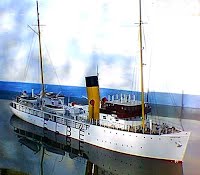 |
| Tradition | This model is based on a type of Seine Net Trawler traditionally used particularly around the North coast of Scotland. This trawler is not based on a specific ship, but a type of ship. TRADITION was one of the last and largest of the Siene Net Trawlers built of timber in the traditional method by traditional craftsmen, with a superstructure made of steel or aluminium and painted to give an effect of timer, often called “scrumbling”. She was fully modern in machinery and electronics. This type of vessel served their owners well and many are still in service today, thirty or forty years after first being launched. With the reduction of the fishing fleets in the late 90’s due to EEC Regulations the majority of these craft were scrapped, not because they were inefficient but due to their need for skilled craftsmen for repairs and maintenance. With the loss of these skills this type of vessel became more and more expensive to maintain. Details of the kit Scale 1/24 Length 590mm Beam 200mm Sailing weight 2.5kgs The model is based on a glassfibre hull with fender strips and detail moulded into the hull. Deck is from 3mm marine grade plywood, laser cut and finished off with 7mm laser cut boxwood planks. Computer generated plastic, printed in 6 colours is used for the 1.5mm H.I.P. plastic superstructure to give quick and crisp assembly. A full set of fittings in cast light alloy and resin give the finishing touch to the model adding the vital clutter that is so much part of this attractive siene net trawler. As in all of the Deans kits a set of running gear is included, consisting of the propshaft, tiller. Full instructions keyed to a FULL SIZE plan with embedded colour pictures to assist in the construction of the model. Painting instructions are part of the construction notes with tips for using the latest car spray ACRYLIC paint which gives a fast and hard wearing finish. Pre-printed cast vinyl “wood” panels, Chome plating strip are included in the kit along with a set of waterside decals for the final finish. | 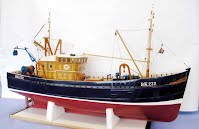 |
| SY Komet | S.Y. KOMET was constructed at Bremer Vulcan a.g. Vegesack 543 and launched on the 6-4-1911. She was designed and built as a governor’s yacht for Deutsche Neu Gunea (German New Guinea). Komet was built of steel up to the boat deck, the wheelhouse was of Mahogany or steel and panelled in the same, Her GRT was 977 tons. Her power was from twin steam boilers powering twin triple expansion engines to two screws with a H.P of 1400 giving a top speed of 13 knots. She carried a crew of 160 and was lightly armed with one 37 mm rapid fire cannon and one 8mm machine gun both on pedestal mountings. She was stationed in New Guinea as the German Governors yacht until 11-10-14. When she was taken as a war prize by the Australian navy and taken into service as a packet / patrol boat. She was armed with three 4” guns on pedestal mountings at that time. She was then renamed H.M.A.S. UNA (one of a kind). After the war she was sold into service as the Pilot boat for the Port Phillip pilot service and renamed AKUNA. She was commissioned in to the R.A.N. as an examination vessel for Port Phillip. In 1943 she was retained until late in WW11. She was still used as a standby vessel until 1954. She gave long service at this position with a legend for rolling on wet grass. The AKUNA was finally broken up in Melbourne in 1955. Deans Marine would wish to express their appreciation to the Australian pilot authority for their kind help and assistance with information and photographs Details of the kit Scale 1/50 Length 1.157mm Beam 212m Sailing weight 8.7kg This model is based on a glass-fibre hull with full plating and port detail. The two main cabin assembly are also glass fibre detailed moulding to ease construction and make the model more suitable for the fitting of a stem plant if desired. The main and boat decks are from 1/16th marine plywood with pre-printed deck planking. The funnel, ships boats, ventilator cowls, and water tank are supplied as vacforming in 1mm styrene, and to complete the model a full set of detailed fittings in cast metal and plastic are included in the kit and to add the superfine detail to this elegant model, a full sheet of brass etched parts of over 300 components add the superfine detail to this model. Also included is a comprehensive instruction book and two full size plans. As in all the Deans kits propshafts, props and rudder are included. And new item in the kit range is the use of computer cut “wood” paneling for fine details such as doors and paneling to give the correct “timber” effect and relief detail to door panels and paneling, and to remove the arduous task of cutting, sanding and staining very unscale woodwork. | 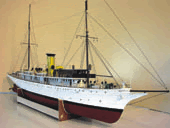 |
| SS Furie | The last sea going steam tug of the Netherlands. The FURIE was built in 1916 by G.H.Bodewen at Martenshoek as the "Bodewes 6" and sold to Holmen Bruke in Norrkoping Sweden when she was renamed "Holmen 3" The ship changed hands again in 1969 to A Akerlund in Stockholm and was named "Holvick", she was used to tow timber rafts to the sawmills. In 1976 she was purchased by AVRO television to play the leading part in the T.V. series "Hollands Glorie" after the book of the same name. She changed hands again in 1977 to Handels Mij. In 1978 she was purchased by the Foundation Hollands Glorie in Maassluis whose aim is to preserve the ship in her original condition. The ship is now in Maasluis and open to the public where she gives frequent trips on the river and is part of the Tug Museum in Maasluis. Details of the kit Scale 1/48 Length 698mm Beam 140mm Sailing weight 3.3kg The model is based on a glassfibre hull with full plating, freeing ports, bulwarks and port detail moulded into the hull. Computer generated plastic printed in 6 colours is used for the decks and superstructure to give quick and crisp assembly. Vacformed plastic mouldings supply the ships boat hulls, engine casings, skylights, motor mount and trays for the nicad batteries. A full set of fittings in cast light alloy and plastic give the finishing touch to the model adding the vital clutter that is so much part of the "TUG" appeal. As in all of the Deans kits a set of running gear is included, consisting of the propshaft, tiller and full instructions keyed to a FULL SIZE plan to assist in the construction of the model. The sailing qualities of the Furie are excellent, as is the standard for all the kits in the range. Painting instructions are part of the construction notes with tips for using the latest car spray ACRYLIC paint which gives a fast and hard wearing finish. Voted by Readers of Modelwerft magazine, as one of the best Models of the year in the annual Compass Competition | 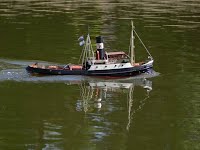 |
| SY Medea | Named after a woman in Greek Mythology the Medea has a history as interesting as her namesake. She was completed in 1904 in 51 days a record time or those days. Build on a steel hull and fitted out with exotic timbers inside. She was the last word in luxury and was used by her owner a Mr Macallister Hall a British army officer for social and hunting trips around the Isles and Lochs of Scotland. Her engine was a 254 HP compound reciprocating, giving her a top speed of 10 knots. She was converted to oil in 1964. During WW1 she was purchased by the French navy and armed with a 75mm gun and depth charges and an observation balloon she was operated as a convoy escort. After the war she returned to UK and was used in the Mediterranean by members of parliament. During WW11 she was taken up by the Royal Navy and stationed in the Thames as a barrage balloon vessel She later was stationed in Scotland and used by the Norwegian navy as an accommodation vessel for Norwegian Commando officers. By 1946 she was cruising on the south coats of the U.K. In the 1950 - 60s Medea became a charter yacht and finally sold to Swedish owners in 1969. She then was purchased by Paul Whittier who restored her to he 1904 condition and donated her to the San Diego Maritime museum in 1973 After a long and interesting history serving in Three navies under six national flags she is still afloat and steaming in the San Diego Maritime Museum, giving VIP trips approx. twice a month. Details of the kit Scale 1/48 Length 870mm Beam 125mm Sailing weight 1.7kgs This model is based on a glass-fibre hull with rubbing strip and port detail, The main and boat deck is from 1mm plastic with pre-printed deck planking, The funnel, ships boat and ventilator cowls, are supplied as vacforming in 1mm styrene, and to complete the model a full set of detailed fittings in cast metal and plastic are included in the kit. Also included is a comprehensive instruction book and two full size plans, As in all the Deans kits propshaft, prop and rudder is included. And a new item in the kit range is the use of computer cut "wood" paneling for fine details such as doors and paneling to give the correct "timber" effect and relief detail to door panels and paneling, and to remove the arduous task of cutting, sanding and staining very unscale woodwork. | 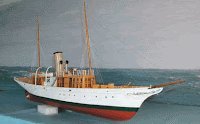 |
| Victoria & Albert [a] | This near scale model is of one of the launches constructed by J Samuel White for the royal yacht Victoria & Albert 11 This is one of several of these type of craft built for the royal yachts over the years. The craft was used as a general purpose crew launch and luggage boat. She did not carry the loads herself but was used as a “tug” , pulling one of the 32ft cutters also carried on the yacht. With her Royal Blue hull, white underwater and gold cheat lines, she makes a handsome and powerful model on the water. Details of the kit Scale 1/15 Length 814mm Beam 228mm Sailing weight 5.02kgs This kit is based on a glass fiber hull with rubbing strip and quarter badge detail moulded into the surface of the hull. The deck and coaming are also a fiberglass moulding to make an easily constructed model designed to take a live steam plant. A full size plan of a set of templates for the internal construction is also included to simplify the construction of the model, these are printed on heavy paper that can be modified to take an alternative steam plant. The templates are then pasted on to you choice of timber and cut out to create a one off kit. The deck is planked onto the glass fibre deck to speed construction and to protect the timber decking, and to give immense strength to the open launch, for with a Puffin steam plant and boiler she is a powerful and maneuverable model. A set of fittings in cast alloy are included, along with a full size plan and a plan sketch of our installation of the Cheddar “Puffin steam plant. (a) A set of glass fibre moulding for the modeller wishing to construct his own prototype based on our hull. (b) A set of mouldings as above, plus all the parts to construct the model as a kit, including the deck planking in mahogany & obeche to plank onto the glass fibre sub deck. | 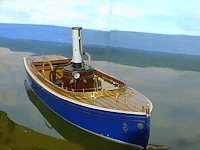 |
| Victoria & Albert [b] | This near scale model is of one of the launches constructed by J Samuel White for the royal yacht Victoria & Albert 11 This is one of several of these type of craft built for the royal yachts over the years. The craft was used as a general purpose crew launch and luggage boat. She did not carry the loads herself but was used as a “tug” , pulling one of the 32ft cutters also carried on the yacht. With her Royal Blue hull, white underwater and gold cheat lines, she makes a handsome and powerful model on the water. Details of the kit Scale 1/15 Length 814mm Beam 228mm Sailing weight 5.02kgs This kit is based on a glass fiber hull with rubbing strip and quarter badge detail moulded into the surface of the hull. The deck and coaming are also a fiberglass moulding to make an easily constructed model designed to take a live steam plant. A full size plan of a set of templates for the internal construction is also included to simplify the construction of the model, these are printed on heavy paper that can be modified to take an alternative steam plant. The templates are then pasted on to you choice of timber and cut out to create a one off kit. The deck is planked onto the glass fibre deck to speed construction and to protect the timber decking, and to give immense strength to the open launch, for with a Puffin steam plant and boiler she is a powerful and maneuverable model. A set of fittings in cast alloy are included, along with a full size plan and a plan sketch of our installation of the Cheddar “Puffin steam plant. (a) A set of glass fibre moulding for the modeller wishing to construct his own prototype based on our hull. (b) A set of mouldings as above, plus all the parts to construct the model as a kit, including the deck planking in mahogany & obeche to plank onto the glass fibre sub deck. |  |
| Wacht am Rhein | In 1848 around 25 tugs were operational on the river Rhein. These were all side wheelers with a draught of around two meters. Because of the shallows in the middle Rhein it was impossible to use ships of a deeper draught. Rhein tugs were therefore lengthened to create more space for longer steam boilers, bigger engines, bunker and crew accommodation. About 1880 the first propeller driven tugs appeared on the Rhein which developed more speed and needed less crew. The "Wacht am Rhein VIII" was built in 1893 as a Rhein tug by the P. Boele Shipyard at Slikkerveer in Holland. She was a tug powered by a coal fired boiler,a compound engine developing 300 IHP and was designed specially for the middle part of the river Rhein which has lots of bends and very strong currents. Her hull design is long and narrow to suit these conditions. The steering and control gear is behind the funnel giving very little view forward but with a much better view of the ships which she tows. In 1894 the ship was taken into service under the name "Wacht am Rhein VIII" by J Huttner in Wesel-Buderich. This company was established at an outstanding location on a bend of the Rhein where in addition to towage they ran a hotel-restuarant. To date (1993) this hotel-restaurant was still managed by the Huttner family although the shipping operation was sold off many years ago. Around the turn of the century the ship came under the control of the Johann Knipscheer Shipping Company who were the first firm who dared to attempt to tow a ship upstream to Basel on the Swiss border. The ship was renamed "Direktor Johann Knipscheer". In 1919 she was renamed "Speculant". Between 1924 and 1957 a number of major alterations were made to her power plant and superstructure. Today: In 1972 she was renamed Pieter Boele, after her original builder and in 1987 handed over to the Prins Hendrik Maritime Museum in Dordrecht where she has been kept in service by volunteer enthusiasts. Details of the kit Scale 1/35 Length 965mm Beam 180mm Sailing weight 2.2kgs The model is based on a glassfibre hull with full plating, freeing ports, bulwarks and port detail moulded into the hull. Computer generated plastic printed in 6 colours is used for the decks and superstructure to give quick and crisp assembly. Vacformed plastic mouldings supply the ships boat hull, engine casings, skylight A full set of fittings in cast light alloy and plastic give the finishing touch to the model adding the vital clutter that is so much part of the "TUG" appeal. As in all of the Deans kits a set of running gear is included, consisting of the propshaft, tiller and full instructions keyed to a FULL SIZE plan to assist in the construction of the model. Painting instructions are part of the construction notes with tips for using the latest car spray ACRYLIC paint which gives a fast and hard wearing finish. | 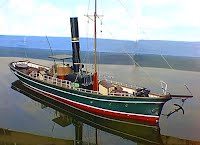 |
| Celastine | M.V. Celestine is owned and by NOVOMAR SA, LUXEMBOURG and chartered to the COBELFRET FERRIES NV company. She is managed by EUROSHIP services, Purfleet U.K. She Launched in 1996 at the KAWASAKI HEAVY INDUSTRIES LTD based in SAKAIDE SHIPYARD Hull no 1465 delivered to the owners on 4th October 1996. She is a roll-on-roll off vehicle carrier of 23,986 GRT, on a length of 162.5 metres. She is powered by two MAN B&W 7L40/54 diesels of 6.690 shp each, giving a service speed of 18.5 knots. She a constructed to carry 654 cars and 157 trailers. At present the class of ships run from Purfleet to Zeebrugge, and between Immingham and Zeebrugge The Celestine is one of 6 in the class all being nearly identical, other ships in the class are the CELESTINE – VALENTINE - CLEMENTINE – MELUSINE – CELANDINE - VICTORINE At the present time (2002) the Celestine is under charter to the MOD and has been renamed SEA CRUSADER for the duration of the charter. Details of the kit Scale 1/100 Length 1.62m Beam 240mm Sailing weight 10kg This model ship kit is the second ship in our range of modern Ro-RO ferries and one of the largest and most complex to be added to our range. This kit is based on a 65" x 10" x 9.5” internal depth moulded glass fibre hull with all prop, rudder and fairlead detail moulded into the hull. For the first time in our range of kits, and to allow for the size and weight of this model the car deck and main hold deck is in 1.5mm high impact plastic sheet included in the kit When Bonded to the 9mm square ramin deck beams this gives a hull deck combination of immense strength without the normal large number of bulkheads and multitude of deck beams associated with a model of this size and weight. The main superstructure is in printed 1mm plastic as is the funnel casings. A full set of detailed cast alloy fittings is included using some of the latest moulding technology to give detail to an outstanding degree. To compliment this large items such as the lifeboats and the massive main winches are finely detailed cast metal and plastic fittings finished off with the fine detailed brass etchings. To compliment the kit and to add superfine detail and complete sheet of brass etchings approx 152 x 12” is crammed full of incredible detail from the huge side openings in the hull, all the deck stanchions of three different types, the complicated masts, we even have the windscreen wipers at 1/96 scale. Ships inflatable liferafts and assorted other fittings are cast in acrylic resin for extremely sharp and accurate detailing. Cast metal stanchions, and deck fittings add the truly professional touch to this hard working merchant ship model. Propeller tubes, fitted with oiling points and stainless steel shafts are included. Full details are supplied for the fitting of motors, nicads and radio equipment. Should the modeller wish to add variations to his ship, we have included detail and variations of the other ships in the class along with colour schemes. Two full size plans are included in the kit to aid construction plus a comprehensive instruction book using some of the latest digital imaging to provide picture and sketches to aid construction. The Celestine model is of massive proportions but still has outstanding sailing qualities as in all of the Deans fleet especially when fitted with the recommended motors and bow thruster. | 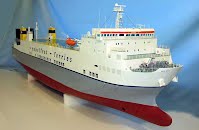 |
| City of Ely | Built by Joshua Henry Ironworks, Sunnyvale, California. In 1940, Great Britain stood alone, fighting the Axis Powers, and after nine months of war had already lost one million tons of shipping that had been sent to the bottom of the Atlantic by German U boats. The U boats were sinking ships faster than the British yards could build them. In September 1940, a British Merchant Ship-building Mission, headed by a representative of J. L. Thompson & Sons of Sunderland, was sent to the U.S.A. with the sole motive of ordering ships to be built there. To speed up possible production, they brought with them the Thompson designed "Dorrington Court" plans, and so it was, with slight modifications that the Liberty Ships came to be built. A total of 2,700 ships were constructed and whilst "built by the mile and chopped of by the yard" they are credited with saving not only Great Britain, but in the Allied cause, the whole world from disaster. The model shown is of a standard armed cargo ship serving with the United States Navy. THE CITY OF ELY REPRESENT THE CIVILIAN VERSION OF THESE FAMOUS SHIPS Details of the kit Scale 1/96 Length 1.384m Beam 185mm Sailing weight 16kgs |  |
| Cordene | S.S. Cordene II Model of a 1900 Steam Trampship, vessels still in service in 1950 .They used to be called 3 legged nineknotters. Details of the kit Scale 1/96 Length 914mm Beam 127mm Sailing weight 4.2kgs Plated glass fibre hull with loading doors and porthole detail moulded into the hull. Decks are of 1mm plastic to give lots strength for this small but heavy model with lots of carrying power. The planked midships deck are from “planked” cast vinyl for rapid assembly and fine detail as are the “teak” hold covers. Plenty of cast metal fittings, for winches, deck fittings etc plus brass etchings for ladders and brass wire for rigging the cast metal stanchions. Vacforms for the boats, funnel and all hold covers are included. The superstructure is of 1mm plastic. A FULL SIZE PLAN is the basis for the instructions along with a comprehensive instruction book with picture assembly sequences. | 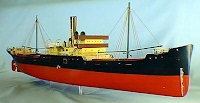 |
| Fairwind | The M.V. Fairwind was built in 1989. This model represents the ship as original constructed. She was later modified and the bridge raised in 1993 and was re-named the M.V. Celtic Commander and operated by the Charles Willie company of Cardif . Her main engine type is the MAK 8M 453 with an output of 2650Kw and a top speed of 13 knots. She is a multi-purpose vessel designed to suit the carriage of containers and project or bulk cargoes. She is equipped with both bow and stern thrusters of 500kW avoiding the use of tugs and her length and draft permit entry into a number of the smaller ports and berths. The vessel is currently employed on time-charter carrying containers between ports in the East Med and the Black Sea. Details of the kit Scale 1/76 Length 1.01mt Beam 165mm Sailing weight A 1/76 SCALE RAILWAY MODEL The model is based on a glassfibre hull with plating, freeing ports, bulwarks and port detail moulded into the hull. Computer generated plastic, printed in 6 colours is used for the decks and superstructure to give quick and crisp assembly. A full set of fittings in cast light alloy and plastic give the finishing touch to the model adding the vital clutter that is so much part of this attractive little merchant ships appeal. To add the final finishing touch a sheet of brass etchings supplying such details as Stanchions, 2 types, ladders and stairways, intake grills and platforms to add that museum quality finish. As in all of the Deans kits a set of running gear is included, consisting of the propshaft, tiller and full instructions keyed to a FULL SIZE FULL COLOUR plan with embedded drtials pictures to assist in the construction of the model. Painting instructions are part of the construction notes with tips for using the latest car spray ACRYLIC paint which gives a fast and hard wearing finish. | 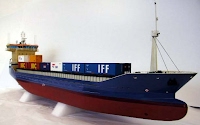 |
| Grampian Pride | Launched in 1981 in Norway this standby rescue vessel is now operated by North Star Shipping, part of the Craig group and is in service in the North sea Glass fibre detailed hull, CNC cut decks, 1mm Printed plastic details, Colour code printed superstructure. Full set of metal and cast resin fittings, life rafts etc Motor mount. Stainless steel Propshaft, propeller, 2 Full size full colour plans with embedded colour photo's and full colour detailing, Digital instructions. Pre- cut waterproof vinyl Decals set. Scale 1:48 Length 830mm Beam 200mm Van deze boot is er een tijdschrift artikel [of meer dan 1] te vinden op de pagina Modellen Tijdschrift Artikelen [Deze pagina is alleen toegankelijk voor VMBC het Anker leden] | 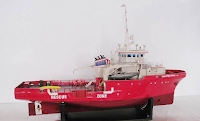 |
| Hudson Firth | Built by the Ailsa Shipbuilding co, Troon, Launched 1949 In the post war rebuilding period, a series of 4,500 ton colliers was built between 1946-1956 with an average length between PP of 320 feet. The first vessel delivered was the HUDSON STRAIT, completed in 1946 for the Hudson Steam ship co followed by her sister the HUDSON FIRTH in 1949 She was designed as a collier to supply the London power stations. and did sterling work for many years in this trade. When the decline in the coal trade became evident the Hudson Steamship Co refitted her with oil burning engines and cargo handling gear for mixed freight trade. Far and wide she did roam in her new work, she is recorded in place such as Canada. South Africa, and many ports on the Atlantic seaboard. She passed to Panamanian owners in 1967 who traded her for a further five years, and after her last cargo was discharged at Birkenhead, she departed for the breakers yard of W.H. Arnott Young at Dalmuir on the Clyde. Details of the kit Scale 1/96 Length 1.09m Beam 146mm Sailing weight 6.1kg This attractive model makes into a super detailed replica of the ship, with all of its cluttered appearance. It has lots of carrying capacity for the largest nicads to please those who like a long sail together with plenty of room inside for adding smoke, sound, lights etc. Three trays of fittings come with the kit to add all the detail including cast metal fittings for the 10 massive cargo winches. Anchor windlass and mooring windlass. All this is on our standard plated glassfibre hull with prop and propshaft with fitted oiler, a comprehensive set of instructions and a FULL SIZE PLAN included. | 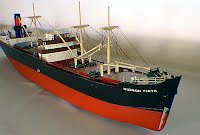 |
| Hudson Gate | Built by Joshua Henry Ironworks, Sunnyvale, California. In 1940, Great Britain stood alone, fighting the Axis Powers, and after nine months of war had already lost one million tons of shipping that had been sent to the bottom of the Atlantic by German U boats. The U boats were sinking ships faster than the British yards could build them. In September 1940, a British Merchant Ship-building Mission, headed by a representative of J. L. Thompson & Sons of Sunderland, was sent to the U.S.A. with the sole motive of ordering ships to be built there. To speed up possible production, they brought with them the Thompson designed "Dorrington Court" plans, and so it was, with slight modifications that the Liberty Ships came to be built. A total of 2,700 ships were constructed and whilst "built by the mile and chopped of by the yard" they are credited with saving not only Great Britain, but in the Allied cause, the whole world from disaster. The model shown is of a standard armed cargo ship serving with the United States Navy. Details of the kit Scale 1/96 Length 1.384m Beam 185mm Sailing weight 16kgs | 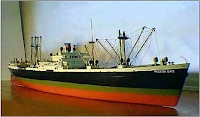 |
| Hudson River | This model of the HUDSON RIVER has been added to a range of ships from this famous company to make a collection in the same livery. With the assistance of the Hudson Steamship Co we introduce the second of their fleet and although she looks similar to the Hudson Sound she is a considerably larger and more modern vessel. She was built by the Ailsa Shipbuilding Co, at Troon and was completed in 1949 on a gross tonnage of 3,128 tons and capable of a cruising speed of 11 knots. The Hudson River had the reputation of being the last of the large coal burning colliers on the English coast. In the late 1960's she was converted to oil burning as good quality bunkering coal was becoming hard to obtain. The noticeable lack of derricks was part of her design since coal in that period was unloaded by dockside grabs and this gave them clearance. For those who wish to modify the kit, the derricks were refitted in her later life when she went on to normal cargo traffic. Details of the kit Scale 1/96 Length 1.09m Beam 146mm Sailing weight 6.1kg The model of this fine lined and graceful merchant ship is based on a plated and detailed glassfibre hull with all freeing ports moulded in. Decks and the superstructure are in printed 1mm plastic for ease of construction. For those difficult items a sheet of vac-formings in .75mm plastic is included to construct items such as ships boats, funnel and hatch covers. When constructed the completed model captures all the grace of the prototype which is thought by many to be one of the most elegant of merchant ships. | 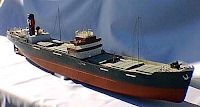 |
| Hudson Sound | This ship is the third addition to our growing range of MERCHANT vessels and is thought by many to be one of the most attractive ships to grace the North Sea. With the full co-operation of the owners, the HUDSON STEAMSHIP CO., we have modelled this version of one of their colliers that ran to the Thames until the 1960's supplying the huge demand for coal to feed the power stations of the London area. In betwen this task she ran many sea voyages from London to the ports of North Africa,Finland and Canada. She was eventually sold to a Panamanian Company. This hard working and proud little ship is still giving good service and was last seen transitting the Panama Canal resplendant in a lilac and black colour scheme. Details of the kit Scale 1/96 Length 990mm Beam 139mm Sailing weight 6.1kgs This attractive model with a length of 39" and beam of 5.5" makes into a super detailed replica of the ship, with all of its cluttered appearance. It has lots of carrying capacity for the largest nicads to please those who like a long sail together with plenty of room inside for adding smoke, sound, lights etc. Three trays of fittings come with the kit to add all the detail including cast metal fittings for the 8 massive coaling winches. All this is on our standard plated glassfibre hull, with prop, propshaft with fitted oiler, a comprehensive set of instructions and a FULL SIZE PLAN included. | 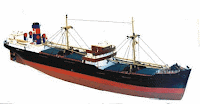 |
| Maersk Anglia | The ship was constructed in Japan in 1977 by the Iskikanigima Harima shipyard and named the "Saint Remy". She had a L.o.a. of 122.95m beam of 18.5m and a draught of 4.8m. Her displacement is 6994.65 tons and she has a capacity to carry 86 forty foot trailers. The main engines are two single acting, air cooled, turbo charged non reversing diesels, each with an output of 3,600 b.h.p.. The two four bladed, variable pitch propellers provide a service speed of 14 knots. On purchase by a company in Norway she was renamed "Admiral Caribe" when for six years she sailed the west coast of the U.S.A. to Europe route. In 1983 she was sold to a French company and renamed the "Admiral Nigeria" under this name she plied the North Africa to Europe route. She was again sold in 1983 the MAERSK shipping co and renamed the Duke of Anglia and about two years ago (1990) her name was again changed to the MAERSK ANGLIA. At present she is under contract to the Ford Motor Company and runs between Dagenham and Zeebrugge. Deans Marine wish to express sincere thanks to the MAERSK shipping co. the captain and crew of the MAERSK ANGLIA and the FORD motor co. for all their kind assistance in supplying the help and information for the design of this model. It was whilst at Zeebrugge she was to play the vital role of coordinating ship for the rescue aboard the "Herald of Free Enterprise" using the ships boats, the Mate, 2nd Engineer and seamen took part in the early rescue attempts. The mate was later awarded the M.B.E. Details of the kit Scale 1/100 Length 1.24m Beam 203mm Sailing weight 6.5kg One of the most spectacular vessels to be added to the Deans Marine merchant fleet with probably the most complicated and detailed glass fibre moulding to come from our workshops. The hull is moulded up to the bridge deck level and includes all port and rubbing strip detail. The bulwarks are part of this moulding. The bridge structure is of computer generated 1mm printed plastic. All fittings, including the four massive multi purpose hydraulic winches that are provided in the kit along with a full set of running gear. These, together with a comprehensive instruction book and a FULL SIZE PLAN assist in the assembly of this impressive model. | 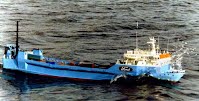 |
| Melani | Melanie 11 is a model of one of a type of ship known as a TRAMP, or more correctly a Three Island type. Built in vast numbers at the beginning of the 1900's, this class of ship is still in service today. The engines were installed in the centre section, along with most of the accommodation. This was to assist with the stability of the vessel. When first built, most of the type had an open bridge on an exposed platform. This was later modified to the raised enclosed type shown on the model which came in to service during the 1920's. Many were lost in both wars since they made up the bulk of the convoys. During W.W.11 large numbers of obsolete weapons were pressed into use to defensively arm merchant ships. The main purpose of the gun aft was to open fire on a U boat and force them to dive??, while the ship made its escape, virtually useless! This made the ships justifiable targets for the U boats and was thought to be one of the contributory factors that brought about the "unrestricted sinking" style of warfare. Details of the kit Scale 1/96 Length 914mm Beam 127mm Sailing weight 4.2kgs Plated glass fibre hull with loading doors and porthole detail moulded into the hull. Decks are of 1mm plastic on a plywood subdeck to give lots of strength for this small but heavy model, with lots of carrying power. The prototype is fitted with sound and smoke generators and brings the model to "life" for this attractive yet ugly little model. Plenty of cast metal fittings. Vacforms for the boats, funnel and all hold covers are included. The supertructure is of 1mm plastic. A FULL SIZE PLAN is the basis for the instructions along with a comprehensive instruction book. | 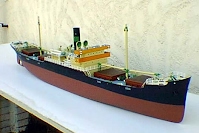 |
| MV Anna-Marie | ANNA-MARIE This model of the Anna-Marie is based on the Type 132 Class of Heavy Lift ships. She was built and launched in Hamburg on 1-3-1997 as the Torm Cote D Ivoire as a dry cargo ship. The class type is L+100 A% G Solas 11020Reg-19 General cargo ship Strengthened for Heavy Cargo. She has been re-named a number of times and has had alterations to he bridge and the heavy cranes fitted to her, Past names have been Maersk Cartengena, Jummentor, Delmas Manoka & the Torm Cote d Ivoire. She is a multi purpose ship that can carry long and heavy loads on her strengthened main deck, from extra long oil pipes to bulk timber cargo. Her main engine type is the MAK 8M 453 with an output of 2650Kw and a top speed of 13 knots. She is a multi-purpose vessel designed to suit the carriage of containers and project or bulk cargoes. She is equipped with both bow and stern thrusters of 500kW avoiding the use of tugs and her length and draft permit entry into a number of the smaller ports and berths. The ship is fitted with ballast compensation tanks to allow for offset cargo loads and to assist in stability when unloading. She is at times taken on charter for delivering luxury yachts to various ports world wide as the cruising seasons change though the year and this is how we have modelled her to add interest to her cargo load, The deck cargo of models is NOT included in the kit but is available from the collectable models wagons range as cargo loads and some assembly plastic kits as per the new Sunseelker Predator from Revell, also from the range of ready to run radio controlled boats from such firms as Kyosho. Details of the Kit Length 1.1m Beam 165mm Scale 1/83 The model is based on a glassfibre hull with plating, freeing ports, bulwarks and port detail moulded into the hull. Computer generated plastic, printed in 6 colours is used for the decks and superstructure to give quick and crisp assembly. A full set of fittings in cast light alloy and plastic give the finishing touch to the model adding the vital clutter that is so much part of this attractive little merchant ships appeal. To add the final finishing touch a sheet of brass etchings supplying such details as Stanchions, 2 types, ladders and stairways, intake grills and platforms to add that museum quality finish. The two heavy lift cranes are separate little kits within the main kit and can be position as required on the model. As in all of the Deans kits a set of running gear is included, consisting of the propshaft, tiller and full instructions keyed to a FULL SIZE FULL COLOUR plan with embedded detail pictures to assist in the construction of the model. Painting instructions are part of the construction notes with tips for using the latest car spray ACRYLIC paint which gives a fast and hard wearing finish. |  |
| MV Muirneag | The latest addition to the merchant ship fleet and one of the most up to date additions and the most colourfull. The MUIRNEAG has just “2003” been introduced to the Caledonian Macbrayne fleet for service on there famous Highlands ferry service. She was built in 1982 at the Frederikshaven werf in Denmark as a class FV 610 256 TEU RO/RO ship. Her power is supplied by a MaK 12M453AK diesel engine giving output of 5000 hk driving a single VP propeller giving a service speed of 15 knots. To aid close confine handling she is also fitted with a 2000 HK$ bow thruster unit. Details of the kit Scale 1/100 Length 1.11m Beam 205mm Sailing weight 6.1kg One of the most up to date vessels to be added to the Deans Marine merchant fleet with probably one of the most complicated and detailed glass fibre moulding to come from our workshops. The hull is moulded up to the bridge deck level and includes all port and rubbing strip detail. The bulwarks around the main car deck are part of this moulding. The bridge structure is of computer generated 1mm printed plastic. All fittings, including the multi purpose hydraulic winches are provided in the kit along with a full set of running gear for single shaft and twin rudders. Instructions are also included for the fitting of a bow thruster unit for those drivers that require extreme manouvering power as per the prototype ship. These, together with a comprehensive instruction book and a FULL SIZE PLAN assist in the assembly of this impressive model. |  |
| Rix Harrier | The Rix Harrier was constructed by the Yorkshire dry-dock company in 1979 as the Merchant ship WIB. She was renamed the Breydon Enterprise. Her propulsion was by Holland Roe machinery. In 1996 she was purchased by T & S Rix company of Hull and converted to a bunkering tanker for service in Hull docks. She was re-engined with two caterpillar 1036 diesels driving podded propellors with a s.h.p. on each prop of 480 H.P. giving a service speed of 9 knots. Auxillary power supply is by Cummins diesels. She now has a deadweight of 1009 tons , gross tonnage is 572 and nett tonnage 0f 354 tons. The Rix Harrier can be seen servicing larger ships in and around Hull docks, her and her near sister have been seen Details of the kit Scale 1/50 Length 915mm Beam 195mm Sailing weight 8.5.kgs The model of the M.V RIX HARRIER is constructed on a glassfibre hull with bulwarks and freeing ports moulded into the hull. The decks and superstructure are in 1mm & .5mm computer generated printed plastic. Ships inflatable and assorted other fittings are cast in acrylic resin for extremely sharp and accurate detailing. The H.I.A.B. crane is a kit in its own right cats in plastic and white metal. Cast metal stanchions, and deck fittings add the truly professional touch to this hard working merchant ship model. The complicated deck piping is assembled from styrene plastic tube and completed with all the valves, wheels and vents in metal, and using a 3 colour printed layout on the tank deck. Propeller tubes, fitted with oiling points and stainless steel shafts are included together with a comprehensive instruction book and a FULL SIZE plan. Full details are supplied for the fitting of motors, nicads and radio equipment. | 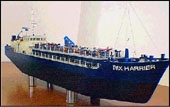 |
| Robert E Peary | Built by Joshua Henry Ironworks, Sunnyvale, California. In 1940, Great Britain stood alone, fighting the Axis Powers, and after nine months of war had already lost one million tons of shipping that had been sent to the bottom of the Atlantic by German U boats. The U boats were sinking ships faster than the British yards could build them. In September 1940, a British Merchant Ship-building Mission, headed by a representative of J. L. Thompson & Sons of Sunderland, was sent to the U.S.A. with the sole motive of ordering ships to be built there. To speed up possible production, they brought with them the Thompson designed "Dorrington Court" plans, and so it was, with slight modifications that the Liberty Ships came to be built. A total of 2,700 ships were constructed and whilst "built by the mile and chopped of by the yard" they are credited with saving not only Great Britain, but in the Allied cause, the whole world from disaster. The model shown is of a standard armed cargo ship serving with the United States Navy. Details of the kit Scale 1/96 Length 1 384m Beam 185mm Sailing weight 16kg The large one piece fiberglass hull of this model, with its belt detail, gives a vast amount of space, with plenty of access through the 5 holds. It makes an ideal model for those who wish to add working features such as lights ,sound ,smoke, and even music. It will all go into this cavenous hull. As in all the kits in our range many fittings of cast metal and plastic, the boats, ventilator cowls and funnel are supplied as vacformed plastic mouldings. A large battery will fit into the midships section, giving a long running time and this model steers very well for its size. She is fitted with the "split rudder" as in the prototype. A full size plan is included in the kit, along with a set of comprehensive instructions, stainless steel propshaft, proptube, and rudder. | 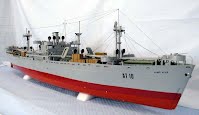 |
| Trein Maersk | The "T" class container feeder ships have been designed and constructed for the Maersk line in 1990 by the Tsoneishi shipbuilding co, Japan. There are four ships in the class all sailing under the Maersk flag, the ships are named, m.s Trein Maersk, m.s. Tobias Maersk, m.s. Thorkil Maersk, and the m.s. Torben Maersk. In 19951996 the Trein Maersk was renamed the T.R.S.L. Antares and was registered in Douglas I.O.M. as are many of the Maersk ships working from the U.K. The deadweight tonnage of the ships is 21,229 mt on the principal dimensions of Length oa 161.02mt; Length bp 152.00mt; Beam oa 31.00mt; Depth mld 15.30mt. Full load draught ext 10..02mt on a Gross tonnage of 17.700 tons, The ships are constructed to the highest standards class LRS .x100A1 x LMC. UMS. container ship ocean going. The vessels are used as a feeder ship and container vessel to country and ports where no container terminals are based, this accounts for the full size container crane with extended reach to enable the containers to be unloaded direct onto local transport or the dockside. For this reason she is fitted with bow and stern thrusters for docking unaided in small ports, when tugs powerful enough to handle such a ship are often not available. At the present time (1996) the Trein Maersk is operating from Hamburg, Felixstowe, to Mexico. The ships are capable of carrying mixed sizes of standard containers and reefers for she has massive power plants capable of supplying power to 200 + reefers (freezer) containers and overseeing to the condition of the contents of same. She is powered by a Burmiester and Wain 8S50MC diesel engine of 14,240 pc with a max r.p.m of 123 giving a max speed of 20.27 knots and a service speed of 18 knots. The ship carries a crew of 20 persons plus a Suez crew of 6 when required. The keel of this ship was laid on 13th October 1989, and she was launched on 24th Jan 1990, she was delivered to her owners on the 15th May 1990. Details of the kit Scale 1/100 Length 1.6m Beam 318mm Sailing weight 18.2kgs This model ship kit, we believe, to be the first of a modern container vessel. This kit is based on a 63" x 12" moulded glass fiber hull with all prop, rudder and fairlead detail moulded into the hull. For the first time in our range of kits, and to allow for the size and weight of this model the deck and main hold tops included in the kit, are a one piece glass fiber moulding. Bonded to the 9mm square ramin deck beams this gives a hull deck combination of immense strength without the normal large number of bulkheads and multitude of deck beams associated with a model of this size and weight. The 12 separate main container blocks are also in highly detailed glass fiber mouldings, some to serve as access hatches to the cavernous hull and to provide handy covers to the holds, A full set of 12 is included in the kit. Extra containers blocks can be added to provide an assorted mix of reefers and containers. If you wish to carry a full load you can add up to 1,100 containers.? The main superstructure is in printed 1mm plastic as is the central container crane. A full set of detailed cast alloy fittings is included using some of the latest moulding technology to give detail to an outstanding degree. To compliment this large items such as the single free fall lifeboat and the massive main winches are finely detailed cast plastic fittings finished off with the fine detailed metal fittings. Should the modeler wish to add variations to his boat, we have produced a new item in the Deans range. This is a range silicone moulds of all the standard containers and reefers, plus an Acrylic moulding compound that when mixed with water sets like plaster to produce a set of kit mouldings that can then be assembled and painted by the modeler. The kits consist of 1 mould for a container kit, I packet of moulding acrylic, plus a set of instruction. Extra moulding acrylic is available as a separate item. Two full size plans are included in the kit to aid construction plus a comprehensive instruction book using some of the latest digital imaging to provide picture and sketches to aid construction. The Trein Maersk model is of massive proportions but still has outstanding sailing qualities as in all of the Deans fleet ,especially when fitted with the recommended motors and bow thruster, for those with and inventive mind the full size ship is also fitted with stern thrusters to make for some very interesting steering. | 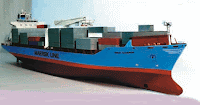 |
| Timrix | The Timrix was constructed as the “Ellie” by Cochranes of Selby. Whilst still on the slips she passed ownership to Metcalf Motor Coatsterd Ltd and was completed and launched as the Nellie M in March 1972. The Nellis M was designed as a bulk cargo and container carrier and was launched by the elder daughter of the founder of the firm. She was then sold to an Irish company possibly Arklow and was sunk by I.R.A. action in the late 1970s. The ship was raised and refurbished. during her spell in the shipyard she was lengthened by approx 7 meters and changed into a two hatch vessel. A later refit in the early 90s saw the number two hatch raised. She was sold out of the Rix Company service in 1998 and was replaced with a more modern ship which is a sister to three others in the Rix fleet. The Timrix was powered by a 1160 bhp Allen type 8pbcs 12-D engine propulsion engine which gave a one way speed on trials of 16 knots and a mean speed of 12.9 knots. The ship has a dead-weight of 1160 tons. Details of the kit Scale 1/75 Length 965mm Beam 153mm Sailing weight 2kgs The model is based on a glassfibre hull with full plating, freeing ports, bulwarks and port detail moulded into the hull. Computer generated plastic, printed in 6 colours is used for the decks and superstructure to give quick and crisp assembly. A full set of fittings in cast light alloy and plastic give the finishing touch to the model adding the vital clutter that is so much part of this attractive little merchant ships appeal. As in all of the Deans kits a set of running gear is included, consisting of the propshaft, tiller and full instructions keyed to a FULL SIZE plan to assist in the construction of the model. Painting instructions are part of the construction notes with tips for using the latest car spray ACRYLIC paint which gives a fast and hard wearing finish. | 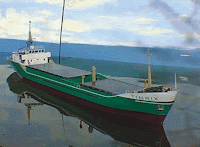 |
| DUKW | A new type of model that has been added to the range of Deans Marine. for more infromation on Semi Kits please visit the Mouldeans section The amphibious version of the General Motors 2.5 ton truck, This vehicle was developed during WW11 to deliver cargo from ships at sea directly to the shore without the use of landing stages and harbours, and if required transport the supplies to the troops or depots. As with most items of equipment many other uses were thought up for this versatile vehicle from aircraft transport to mobile artillery. The D.U.K.W. was so well thought out that it was used in many other conflicts after the war and for long after in the oil and drilling industry, Even today they are being used after reconditioning and the addition of more modern safety equipment some are being given a new lease of life carrying tourist up the river Thames in the heart of London. Details of the kit Scale 1/10 Length 950mm Beam 260mm Sailing weight 8kg This addition to the “Fleet” is based on a glassfibre moulded hull with all plating and stiffening detail moulded into the hull. The wheel wells, propshaft tunnel and the cockpit are all assembled making the lower hull a complete fibreglass moulding. The deck likewise is a complete glass fibre moulding with all detail added. A complete set of fitting is included to give that extra finishing touch to the model. A comprehensive instruction book is included that gives full construction details and full size drawings of parts to produce a working model with 2 wheel front axle drive or full six wheel drive. Also included is a parts listing for the extra items that will be require for each version with there names and the parts numbers and the companies that produce the items. The semi-kit is available for the modeler who wishes to experiment with drives and axles from r/c model cars and will not be paying for parts that might be discarded TO COMPLETE THIS MODEL AS SHOWN IT WILL REQUIRE THE PURCHASE OF WHEELS AND WORKING AXLES PLUS ANCILLARY PARTS. A full kit version with front wheel drive and steering plus a complete working suspension will follow in the near future. THE DIFFERENT PART. As this vehicle can be modeled and powered so many different ways, Deans Marine have decided rather than produce a very expensive kit that might not be required by the modeler we have added an alternative to the normal kit. More in the line of the semi-kit The set of mouldings for this vehicle comes with a comprehensive instruction book with digitally printed black & white pictures to detail the many variations that are available in the power train to suit the budget of the modelers wishing to personalize his model. This book gives a listing of all the parts required for each variation of the power train and the name and address or contact where the parts can be purchased. Some of the variations that are available are as follows. Standard, a model boat with dummy wheels for sailing only. Model with rear wheel drive and propeller for sailing and the capability to enter and exit the lake along a gentle gradient. 4 wheel drive with front axle steering for cross country ability and the capability to enter and exit the lake along a steeper gradient. Full six wheel drive with front axle steering for cross country ability and the capability to enter and exit the lake along gradients up to 45%. Where working fittings are not available commercially, detailed drawing are included to enable the modeller to construct the parts in his own workshop with standard modelling equipment. The full set of assembly pictures is also available as colour prints to compliment the instructions if required. Van deze boot is er een tijdschrift artikel [of meer dan 1] te vinden op de pagina Modellen Tijdschrift Artikelen [Deze pagina is alleen toegankelijk voor VMBC het Anker leden] | 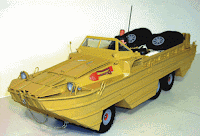 |
| Royal OAK | Scale 1:96 Length 1980mm Beam 330mm The MK2 Semi~kit is a method of supplying the modeller with the requisite parts and information to construct a large model where we have followed the construction of the prototype to completion Models in the range are chosen for their large size, difficulty or unusual design for the modeller who wishes to construct a large or difficult model or something a little out of the ordinary that makes the prototype unlikely to be developed in to a full kit. The semi-kit does not contain any instructions or parts for the decks and superstructure as this is left to the modeller who by the nature of the project will be well versed in developing the project to its basic construction. |  |
| HMCC Badger | The Badger customs cutter is a Customs & Excise launch based in Plymouth and in the service of Her Majesties Customs and Excise. The launch is designed for handling all but the worst conditions, and is renowned for her sea kindliness. As far as we know the Badger was stationed at Plymouth with her near sisters, but at the present time we cannot obtain any further information for the Custom & Excise. Details of the kit Scale 1/15 Length 949mm Beam 255mm Sailing weight 5.1kg The kit is based on a glass fibre hull, glass fibre deck moulding with access hatch moulded in the deck. plus a complete glass fibre moulding for the superstructure. The wheelhouse & funnel is moulded from clear styrolux, the brass framing is from precut brass vinyl. A full set of detailed fitting cast in light alloy is included in the kit along with all running gear, prop and rudder. As with all kits in our range, a comprehensive instruction book and full size plan is included. plus the Deans renowned performance on the water. | 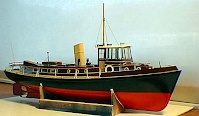 |
| Julie M | This craft is a model of the type of general service craft built around the turn of the century by William Denny & Co. Modified to suit individual tastes and functions, these type of craft were the forerunners of the first torpedo boats, often fitted with a Spar Torpedo, or later a single tube fitted on the bows. When made obsolete these craft were used in many ports and harbours worldwide for general duties, such as mail and picket boats. They were the most common on the far eats stations, were the art of spit and polish or keeping things “tiddley” was brought to a fine art. Coal; fired with reciprocating engines of assorted power, these craft generally had a top speed of 13-14 knots. The hull lines were carried on for many years as the design was copied for many steam yachts and launches. When sold out of general service many were snapped up as private launches. We have been told that this small river steam launch was constructed by Denny Bros for use in the rivers of Siam as a postal and service craft for the Royal family at that time. She lasted from the turn of the century, when she was shipped out to Siam in sections and reassembled. She popped up again during the 1920s, and again in the 1960,s during the troubles. We have been informed that she was “borrowed” by the Special Forces for clandestine operations, at which time the wheelhouse was plated with sheet steel, and a purloined 20mm Cannon mounted in the bows. She has since vanished from the scene, and there are certain problems with trying to trace any more of her history. Details of the kit Scale 1/35 Length 762mm Beam 120mm Sailing weight 2kgs This kit is based on a glass fibre hull with rubbing strip and gingerbread detail moulded into the surface of the hull. As is the glass fibre moulded superstructure. The construction of the deck and is in marine grade plywood, The deck planking is supplied cut to width in Mahogeny and Obeche, A full set of fittings in cast alloy is included in the kit, along with a full size plan and a comprehensive set of instructions. | 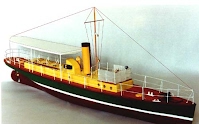 |
| Picket Boat | The steam Picket Boat was developed from the 63ft craft that were carried by Capital ships from 1863, to be launched and carry out attacks on the enemy fleet. They were never used in such a role but became maids of all work for ships. They could be armed with a 3pd gun (as shown) or a Nordenfelt machine gun. The craft were constructed with the best quality and some even survive today in working order. The 56ft was the most numerous and became a classic of its type. After service with the Royal Navy many of the type became the 56ft seaplane tenders for the Royal Air Force. Some of the type even survive to this day as private craft. Details of the kit Scale 1/24 Length 711mm Beam 152mm Sailing weight 2kgs The kit is based on a glass fibre hull, deck is in printed colour coded 1mm plastic as is the main cabin. The main cabin roof. funnel, and engine casing is vacformed plastic. A complete set of fittings in metal and plastic is supplied in the kit along with propshaft,prop etc. The deck planking is preprinted on cast self adhesive vinyl to ease construction | 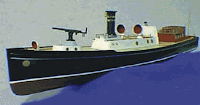 |
| Pinnace | The steam Picket Boat was developed from the 63ft craft that were carried by Capital ships from 1863, to be launched and carry out attacks on the enemy fleet. They were never used in such a role but became maids of all work for ships. The 56ft was the most numerous and became a classic of its type. After service with the Royal Navy many of the type became the 56ft seaplane tenders for the Royal Air Force. the steam engines were removed and replaced by assorted engines, this particular craft was fitted with the Thorneycroft paraffin/ petrol engines. They were used mainly for carrying crews out to seaplanes and general tug work such as towing floating landing lights and moving large seaplanes around the bases. The craft were constructed with the best quality and some even survive today in working order. Details of the kit Scale 1/24 Length 711mm Beam 152mm Sailing weight 2.2kg High quality fibre-glass hull with moulded in rubbing strake. Main s/str, funnel, & coach roof are in vacformed plastic, Decking and cabin sides in pre-printed plastic. A full set off fittings are included along with running gear, propshaft & propellor plus a full size plan & comprehensive instructions are included. | 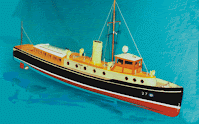 |
| SL Helen | This steam launch is based on Thames launches constructed around 1920 and used on many rivers, estuaries and lakes in the U.K. Many are still in regular use and are often seen at steam boat gatherings in many parts of the country. Details of the kit Scale 1/15 Length 965mm Beam 139mm Sailing weight 2.2kgs This kit is based on a glass fibre hull with rubbing strip and gingerbread detail moulded into the surface of the hull. The construction of the deck and superstructure is in marine grade plywood, The deck planking is supplied cut to width in Mahogeny and Obeche, A full set of fittings in cast alloy is included in the kit, along with a full size plan and a comprehesive set of instructions. | 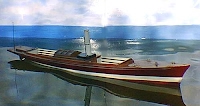 |
| HrMS Banckert | The choice of a model based on a Dutch ship may at first seem a little odd, but she was handed over to the Dutch Navy as the former H.M.S. QUILLIAM. She gives a pleasing model in its light and colourful Dutch scheme with all the graceful looks of one of the emergency class destroyers that are so familiar to the British modeller. Details of the kit Scale 1/96 Length 1.15m Beam 114mm Sailing weight 3.3kgs The model is based on the kit of the GRENVILLE from our range, but with the plans and fittings modified to fit this famous Dutch warship. As with all the models in the range, the hull is based on a light weight glass fibre hull with a plated finish. Weapons and small detailed fittings are cast in light alloy, larger items such as lockers, carley floats etc, are cast in vacast plastic for light weight to assist in giving the model its outstanding performance on the water. To add the finishing touches, etched brass is used for ladders, dial sights and stanchions. Custom made prop shafts and tubes are included along with the rudder, tiller, to make this a complete kit with its FULL SIZE PLAN and comprehensive instructions | 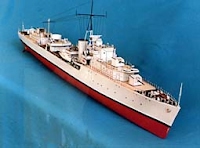 |
| SMS Emden | The most famous ship during and since the first world war. This German raider terrorized the Indian and Pacific Oceans for 3 months during WW1. Under the command of Kapitan Karl von Muller the Emden destroyed 16 British ships totalling 70,825 G.R.T. She seized a Russian auxilary cruiser, a Greek and a British ship were used as colliers. Four British ships were released after capture. She brazenly sailed into Madras harbour and shelled the oil tanks of the Anglo Persian Oil Co, followed by a daring dash into Penang harbour to sink the Russian cruiser Zhemchug. The adventures of the Emden were avidly followed in the Kaiser's Germany and also in the British Empire. In all these exploits only a single merchant sailor's life was lost in a campaign that cost the British 16 ships. Finally on the 9th November 1914 off Direction Island the Emden was caught by the cruiser Sydney. The one sided fight against the much more powerful Sydney resulted in the Emden being run aground on North Keeling island where she still lies to this day. 134 of the crew were dead or dying. The full story of this famous ship is far to long to be told here, we can only recommend the book "EMDEN The last cruise of a chivalrous raider", to tell the complete story. Laid down 6/4/1906; Launched 20/5/1908; Commissioned 20/7/1909; Builder Kaiserliche Werf Danzig Dimensions Length 389ft; Beam 44 ft; Draught 16ft; Dispacement 3650 tons Machinery Vertical 3 cylinder; Boilers Schulz-Thorneycroft; Output 16,171 b.h.p. Speed Max. 25 knots. Armament 10 x 105mm singles; 4 x 8mm M.G.s; 3 x 60mm & 2 x 8mm portables; 2 x 450mm torpedo tubes Details of the kit Scale 1/96 Length 1.14m Beam 140mm Sailing weight 4.3kgs The plated fibreglass hull is the base for this model, along with the superstructure from computer printed 1mm plastic for the main assembly and a sheet of .5mm printed plastic adding the final sharpness to this elegant model. To add all the detail over 100 fittings cast in light alloy or plastic are included in the kit. Vacformed plastic mouldings take care of all the larger and more complex parts such as the many ships boats, funnels, vents and funnel bases. The many stanchions on this model are cast in light alloy to give the correct pattern of spacing, with 2 gauges of brass wire for the stanchion wires. Brass etched ladders add the finest detail and delicate touch to this model, one of the classics amongst warships. A comprehensive instruction book is included in the kit keyed to TWO FULL SIZE PLANS. As in all the kits in the range, a full set of running gear is included in the kit. To add to the classic look of this ship the colour scheme east India station is included along with tips in the instructions for the use of the modern ACRYLIC car spray paints that are giving such outstanding results. | 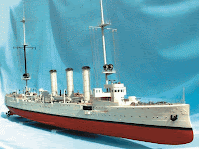 |
| USS Kidd | This kit is typical of the Fletcher class destroyers built by various yards for the U.S. NAVY between 1940 and 1944. In two major versions, this model is one of the later and more numerous type with a heavy A/A weapons fit. She is one of the most powerful and successful types of destroyers ever constructed in the second world war. The Fletcher class was the U.S. Navy's most important fleet destroyer of W.W.11, and served with particular distinction in the Pacific Theatre where its long range and excellent weapons fit proved invaluable. The type was retained in service after the war, and some were released for export from the 1950's. They were sent to many navies, from South America to the Far East. These ships were so well constructed that some are still in service to this day and will only be withdrawn for lack of spares Details of the kit Scale 1/96 Length 1.16m Beam 133mm Sailing weight 3.7kgs This kit contains a one piece glass fibre hull, all decks and superstructure in 1mm printed plastic sheet, along with photographic exploded views of construction notes. To finish off the model to a very high standard and to add the noticable "clutter" of the ship over 200 fittings cast in light alloy and light weight plastic are provided. This gives a highly detailed model. All other fittings as per the kits in our range. | 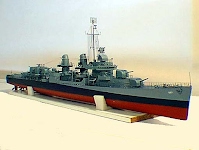 |
| Z37 Narvick | This class of ships was ordered by the German navy after the outbreak of W.W.11 on the 19/9/39. They differed from the previous class, the Z23/30 in only minor details and the fitting of larger funnel caps. The type 36 class, they were a well thought out and successful design. They did not join the fleet until 1942, all were completed with quad 20mm aft. and were soon fitted with the same weapon forward. As the war progressed, all the ships in the class were altered in their weapons fit since damage repairs and modifications were locally carried out. Z37 and her sisters received little mods during their wartime careers. She had a fairly uneventful time, until she was attached to the 8th flotilla and sailed for western France in March 1943 where she was stationed until lost. She was rammed and damaged by Z32 on 30/1/44 and towed into Bordeaux, where the guns were landed for shore defence and the ship was gutted by fire. Z37 was constructed at the Germania yard, Kiel, and was launched on the 24/2/41 on a displ of 2637 tons, her engines produced 70,000 s.h.p. with a speed of 36 knots. Details of the kit Scale 1/96 Length 1.32mm Beam 127mm Sailing weight 3.9kgs This addition to the DEANS range of models is probably the most requested kit ever made, a magnificent partner to the growing range of British ships. Considered by many to be one of the finest and most elegant warships ever to grace the seas, this model captures the fine lines and superb sea keeping qualities of the prototype. As in all the kits in the range, a FULL SIZE PLAN together with propshafts in stainless steel, proptubes in hard brass with replaceable bearings, rudder and tiller are included in this comprehensive kit. Based on a one piece glass fibre hull we have captured the rakish lines and the semi-tunnel underwater section of the original, making this model one of the more complex hulls to come from our workshops. As in all the kits in the range, a FULL SIZE PLAN together with propshafts in stainless steel, proptubes in hard brass with replaceable bearings, rudder and tiller are included in this comprehensive kit. Superstructure and decks in 1mm plastic, lots of cast alloy and cast plastic fittings to add the busy appearance of the full size craft, plus the DEANS trademark of quality, stanchions and ladders in brass etchings. The comprehensive instructions are in exploded view format and, a new addition, laser scanned photos to bring a high definition to the instructions and assist in constructing this classic model of a powerful W.W.11 destroyer.As in all the kits in the range, a FULL SIZE PLAN together with propshafts in stainless steel, proptubes in hard brass with replaceable bearings, rudder and tiller are included in this comprehensive kit. As in all the kits in the range, a FULL SIZE PLAN together with propshafts in stainless steel, proptubes in hard brass with replaceable bearings, rudder and tiller are included in this comprehensive kit. |  |
| HMS Amazon | Tribal class or "F" class destroyers 1905 1908 programme. One of the policies of the first sea lord in 1904 was the production of an ocean going destroyer which should have the following capabilities:- A. Steam at 33 knots for 8 hrs in a moderate sea B. Burn oil fuel C. Carry 2 x 12.lb guns D. Carry 7 days provisions "later 4 days" This was something of a revolution in ship design requirements for those days, being 7.5 knots faster than any previous design particularly when the then novel turbines had yet to be built and tested (only 8 types were in service). Tenders were at last taken up and building of the new "F" class began, divided into 3 separate groups. With no fewer than 7 different yards involved it is hardly surprising that few of the ships looked the same. The 3 groups are: 1905-1906 1906-1907 1907-1908 AFRIDI AMAZON CRUSADER COSSACK SARACEN MAORI GHURKA NUBIAN MOHAWK VIKING TARTAR ZULU The class was completed at an average cost of £137,000. On trials with a displacement of 1,000 tons a speed of 33 knots was achieved. The complement was 5 officers and 56 men. Details of the kit Scale 1/96 Length 901mm Beam 89mm Sailing weight 1.25kgs The models are based on the period after the original ships' sea trials, when a number of modifications were carried out. To this end all ships were changed – up gunned to 2 x 4inch guns forward funnels lengthened so that fumes cleared the bridge, turtle decks removed to a standard fo/castle. This gave the ships the classic destroyer outline. The base of these models is a one piece vacformed or moulded fibreglass hull with all superstructures and decks in 1mm plastic, for one glue construction. These models are designed with the beginner in mind and as a good starter to the world of warship modelling. They embody all the excitement of the building and driving of a warship without the task of constructing a full fleet model. The simple structure on the decks of these ships makes for very quick construction and with all funnels and boats in vacformings, allied with a full set of fittings in cast light alloy and cast plastic makes for an attractive model. These ships have all the performance of their bigger sisters and have one of the most outstanding sea keeping qualities of all the models in the range. As the choice of motor and couplings is very important in the construction of these ships they can be supplied with the kit on request. THIS MODEL IS BASED ON A PLATED GLASS FIBRE HULL THE KIT IS IN SINGLE SCREW FORMAT AND RUNS ON 4 OR 5 1,2AH NICADS. |  |
| HMS Amethyst | This modified Black Swan class frigate was launched on 7th May 1943 at the yard of Alex Stephens & Co , Linthouse. After a very active wartime career "Amethyst" was sent to the Far East as a guard ship for the British community in Shanghai. The action that made her a household name was an incident in the Yangse river in late 1949 where she was trapped almost 200 miles inland. In a heroic action she broke out and escaped to the sea. Amethyst was sold for scrapping at the Plymouth yard of Demmelweek and Reading. Members of the Amethyst association still meet at regular intervals. Details of the kit Scale 1/96 Length 958m Beam 114mm Sailing weight 3.1kgs One of the oldest production kits in the Deans Marine range, Now brought up to date to the standard of the latest kits The fibreglass hull in this is with full plating and port detail. Computer generated colour coded printed plastic forms the main superstructure along with the 1mm plastic deck. To complete the construction of the model all complex parts are vacformed in 1mm plastic for funnel, boats, turrets etc. A complete set of fittings is included in the kit with all detail parts such as weapons, deck fittings, etc, cast in light alloy. Larger item such as lockers, floats, and gun bases are moulded as resine castings for light weight. The lattice mast, such a notable feature of this class of ship is assembled from etched brass in four parts for simple assembly. Ladders and stanchions are also in etched brass to give a final showcase finish. Propshafts in stainless steel are cased in brass proptubes with fitted oilers and replacable bearings along with rudder and tiller arm. These, together with a comprehensive instruction book with digital prited picture / instructions and a FULL SIZE PLAN assist in the assembly of this impressive model. One or our oldest kits and still a very popular ship. This kit has now been reworked and brought up to date of the standards of the latest kits. Glass fibre plated hull, brass etching for fine detail, up to date instructions and a C/d available with all the construction pictures of the prototype models. | 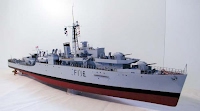 |
| HMS Bramble | ALGERINE MINESWEEPERS These ships were built between 1942 and 1945 and were fitted with magnectic, acoustic, and mechanical sweeping equipment. It would seem that this class of ship developed from the Halcyon class of minesweeper of the 1930's still retaining some of their general appearance. These ships, having been built in the U.K. and Canada, later served in the Canadian and most Western Alliance Navys. Details of the kit Scale 1/96 Length 762m Beam 120mm Sailing weight 2.21kgs The model is based on a plated fibre glass hull. All decks and superstructure are in 1mm printed plastic sheet format with turret, funnel, boats etc in vacformed plastic. Weapons and fine detail fittings are in cast in light alloy, and all larger items are cast in lightweight plastic. Stanchions and ladders for that extra fine detail are in etched brass. Propshafts and tubes are included in this kit along with the rudder and tiller arm. THE FULL SIZE PLAN is from the D McGregor range. With its twin screws and twin motors and short length/beam ratio this makes into one of the busiest little models in our range and she has all the outstanding handling qualities of her bigger and full size sister. The close range weapons fit on this model are 4 40mm bofors guns. The kit contains a comprehensive set of instructions. | 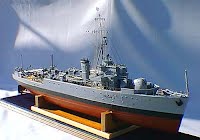 |
| HMS Compass Rose | The Flower class corvette from Deans Marine represents a radical approach to kitting a successful attempt to produce a 1/96 scale warship at a price that will be acceptable to many, and a good start into the world of 1/8th" scale working models. A glassfibre hull construction is featured which means that with limited exceptions only one type of adhesive is required (I used Humbrol liquid poly, plus 5 minute epoxy for sealing prop and rudder tube into place and fixing some of the larger cast fittings) such comparatively inexpensive materials results in a kit costing half as much as a good r/c system. Compliments to Marine Modelling Mag kit Review Augst/Sept 1987. Details of the kit Scale 1/96 Length 673mm Beam 114mm Sailing weight 2.kgs As noted above from a kit review in a leading marine modelling magazine, this kit , the first in a starter range consists of a one piece G/F hull with full plating detail. Decks and superstructure are in 1mm and .5mm printed plastic sheet. To add the required detail to the model without adding to top weight the kit includes over 100 items in cast light alloy or plastic, together with vacformings for the gun cab, funnel, boats etc. All stanchions, ladders, etc are in etched brass. Propeller, rudder and tiller are also included together with our recommendations for the motor, coupling and nicads etc. |  |
| HMS Cossack | The re-armament race of the 1930's led to the major powers beginning construction of destroyers up to 2,000 tons. The British answer to these was the Super Destroyer of the "Tribal class" with 8 4.7" guns in twin mountings, thought by many to be the best looking of all destroyers ever built. The most famous of these was the "COSSACK", due to the Altmark incident in the waters off the coast of Norway. This action made the Cossack a household name along with the famous cry of "THE NAVY'S HERE! Others in the class were the MAORI, ESKIMO, MASHONA, GURKHA, AFRIDI, TARTAR, SOMALI, BEDUOIN, ASHANTI, PUNJABI, MATABELE, AND THE ZULU. These ships displaced 1,870 tons with geared turbines on two shafts giving 44,000 shp and a top speed of 36.5 knots. Details of the kit Scale 1/96 Length 1.2m Beam 127mm Sailing weight 4.4kgs This model is constructed with a plated glass fibre hull, with all portholes and intakes moulded into the hull. To assist in the location of the running gear, the propshaft and rudder exits are marked on the hull. Decks and superstructure are in 1mm or .5mm plastic along with photo exploded views in the instructions to assist in construction. All details are added from the large range of cast alloy and cast plastic fittings included in the kit together with a full running gear set comprising stainless steel propshafts, hard brass proptubes with replaceable bearings, rudder and tiller. Stanchions and ladders are in etched brass to give that crisp finish. A full size plan keyed to a comprehensive instruction book assist in the construction of this classic model destroyer. | 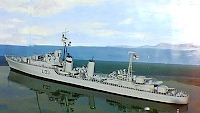 |
| HMS Daring | The "D" class destroyers were typical of the whole series of successive classes from A to I built for the R.N. in the 1930's. In general these were economy designs and tended to be smaller and less well armed than destroyers of other major foreign powers. H.M.S. Daring was commanded by Lord Louis Mountbatten in 1934. She was torpedoed by a U boat on the 18th February 1940 off Duncansby Head Scotland. Daring was launched by Thornycroft in 1932 on a Displ of 1.375 tons. Her main weapons were 4x 4.7" guns and 8 x 21in torpedo tubes, with geared turbines on 2 shafts giving 36,000 s.h.p. and a top speed of 36 knots. When placed along side the V & W in our range, this shows how the destroyers progressed in the 1920/30's. Details of the kit Scale 1/96 Length 1.02m Beam 107mm Sailing weight 2.82kgs This model is based on a plated glass fibre hull, with the superstructure and decks in 1mm plastic. Vac-forms for the funnels, boats, etc, cast alloy main weapons and close range armament. To add the final crisp finish to the model, brass etchings are supplied for all stanchion, ladders etc. A full set of instructions, plus a FULL SIZE PLAN are included in this kit along with stainless steel propshafts, proptubes and rudder. This kit makes into a superb model of this classic British destroyer and as with all the DEANS range, has superb on the water performance. | 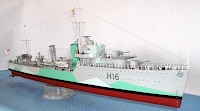 |
| HMS Dreadnought | H.M.S. Dreadnought was the first all big gun battleship to be built. She was laid down at Portsmouth Dockyard in 1906 and was commissioned into the Royal Navy one year later, a building record that has never been equaled. In addition to her uniform main armament of ten 12 inch guns, another major innovation in her design was the use of steam turbines for propulsion, giving her a five knot speed advantage over contemporary battleships. Her uniform main armament meant she was the first ship which could actually take advantage of the great effective range of large naval guns. By firing her guns in groups, aimed from a central control, it was possible to correct the guns' aim by spotting the fall of the shells and correcting the aim accordingly. Dreadnought had a quiet war, her only notable achievement being the sinking of U 29 by ramming in 1915, the only occasion when a submarine fell victim to a battleship. She was scrapped in 1923 Details of the kit Scale 1/96 Length 1.65mm Beam 265mm Sailing weight 12.2kgs The model illustrated shows the ship in her early years, with the original bridge layout The kit is based on the ship as in 1917 The hull is a one piece fiberglass moulding up to the deck line and including the raised focastle to ease construction. All plating and surface detail is moulded into the hull. The deck is 4mm marine plywood with the main deck and foredeck C.N.C. CUT. The deck planking is printed on .6mm marine plywood ready to lay, plus instrctions for laying individual planks for the modeller wishing to add his own touch. The main turrets are also fiberglass mouldings. The 12 inch gun barrels are Acrylic castings. Ships boats, funnells, D.C. towers etc are all vacformings, with optional extras available for precast ships boats as acrylic cast items. Almost all other fittings requiring detail and strength, such as the 12 pounder guns, hatches etc, are cast in light alloy. A laser deck is now included in the Kit | 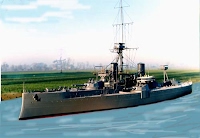 |
| HMS Fencer | During May 1944 the 12 Swordfish from HMS Fencer are credited with the sinking of three U-boats in two days Swordfish LS369 was credited with sinking U-Boat 'U674' on 1st May 1944 whilst protecting Convoy RA59 sailing to the UK from Kola in Russia Sailing from San Diego 2 July 1943, Croatan arrived at Norfolk 19 July. As the nucleus for a hunter-killer group, she sailed 5 August for antisubmarine operations in the Atlantic covering the movement of convoys. Her planes had two skirmishes with surfaced submarines and on 5 September initiated night flying operations from escort carriers. She returned to Norfolk 22 September. From 17 October to 29 December 1943, Croatan made two voyages to Casablanca ferrying aircraft and plane crews for the North African operations. After another antisubmarine patrol from 14 January to 27 February 1944, she took part in tests with the Naval Research Laboratory at Annapolis. From 24 March to 11 May, Croatan made a most successful patrol. On 7 April, her planes marked out U-856, which was sunk by her escorts Champlin (DD-601) and Huse (DE-145) at 40d 18m N., 62d 22m W. On the night of 25-26 April, her four escorts joined in sinking U-488 at 17d 54m N., 38d 05m W. She was also successful in her patrol from 2 June to 22 July. On 10 June, Croatan's planes and escorts Frost (DE-144), Huse, and Inch (DE-146) attacked U-490 and remained in constant contact with it, forcing it to surface the next day. Sixty survivors, including the commanding officer, were rescued before the submarine sank from scuttling charges at 42d 47m N., 40d 08m W. Aircraft and escorts Frost and Inch combined again to sink U-154 on 3 July. Following a brief overhaul and radar tests with the Naval Research Laboratory, Croatan put to sea again 20 August 1944. On 15 September, she aided survivors from Warrington (DD-383) who had foundered in a hurricane. Returning to Norfolk 1 October, Croatan next sailed for antisubmarine training at Guantanamo Bay and Bermuda, then proceeded to provide air cover for a high-speed east bound task force, returning to New York 4 February 1945. For the next month, she qualified pilots in carrier operations, then sailed from Norfolk 25 March to join a barrier line to intercept German submarines. On 16 April, her escorts, Frost and Stanton (DE-247) sank U-880 and U-1235 at 47d 53m N., 30d 26m W. Croatan returned by way of Argentia, Newfoundland to New York 14 May for overhaul. From 15 September to 3 November 1945, Croatan qualified aviators at Quonset Point, then cleared Norfolk 23 November on the first of two transatlantic voyages to bring troops home from Le Havre, Franceon 16 June 1958. In August 1963, she carried 23 Lockheed F-104 Starfighter delivered to the Royal Norwegian Air Force 331 Squadron at Bodø, Norway. In October 1964, she served as an experimental ship under NASA control until May 1965. She was stricken for disposal 15 September 1970 and sold for scrap in 1971. Details of the kit Scale 1/96 Length 1.62m Beam 350mm Sailing weight 12.1kgs Glass fibre detailed hull, Glass fibre detailed hull deck. 1mm Printed plastic details, Colour code printed superstructure. Vacformed details, liferafts, gun cabs etc, Motor mount, Pre-printed self adhesive deck planking, Full metal fittings set Cast resine fittings, Stainless steel Propshaft, propeller, 2 Full size full colour plans WITH EMBEDDED HI RESOLUTION COLOUR PHOTOS and full colour detailing of metal, plastic and resine parts. Digital instructions. Pre- cut waterproof vinyl Decals set. | 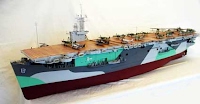 |
| HMS Grenville | was ordered on the 12th June 1941 with 7 others of a class all with names beginning with the letter "U" ie: ULSTER and when launched she was the leader of the 7th emergency flotilla. In 1943 Grenville in company with other destroyers took part in night sweeps up and down the French coast. On the night of the 3/4th October, Grenville and the 4 other ships encountered 5 German R class destroyers who had laid a trap for them. A battle commenced with heavy damage and casualties suffered by both sides. Grenville was hit and stopped. The rest of her war was spent in the Bay of Biscay, where she had a very active career. The full story, told by her captain, is to be found in the book "DESTROYER CAPTAIN" by Roger Hill. In our opinion this is one of the finest true sea stories that we have ever read and for the modeller it is a must. During the 1950's Grenville with the rest of her sisters were converted to type 15 Frigates. She was scrapped by Romanet Ltd of Rochester Kent, and the No X draught mark was removed and presented to DEANS MARINE. Details of the kit Scale 1/96 Length 1.15m Beam 114mm Sailing weight 3.3kgs The plated glass fibre hull is the base for this kit. Deck support beams are from balsa and hardwood, main decks and super structure are in 1mm plastic for quick assembly and vac-formings for the funnel, boats and turrets etc. Brass etchings for all stanchions, ladders, are included in this kit along with a full set of fittings in vacast plastic and light cast alloy. To complete this model both propshafts in stainless steel, proptubes, rudder, ect are included along with recommendations for motors, nicads, and speed controllers. | 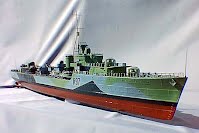 |
| HMS Guernsey | These small seaworthy ships were originally designed along trawler lines to protect the extensive British interests in the North Sea oil installations and to patrol the 200 miles fishery limits. They displace 925 tons with two Ruston diesel engines of 2190BHP each driving one variable pitch propeller giving a top speed of 17 knots Weapons fit is a single 40mm bofors gun and light weapons. The normal compliment is 39 officers and men. Details of the kit Scale 1/72 Length 820mm Beam 160mm Sailing weight 5kg The fiberglass hull in this kit is with full plating and port detail. Computer generated printed plastic forms the main superstructure along with the 1mm plastic deck. To complete the construction of the model all complex parts are vacformed in 1mm plastic for funnel, boats, turret etc. A complete set of fittings are included in the kit with all detail parts such as weapons, deck fittings, etc, cast in light alloy. Larger item such as lockers, floats, and gun bases are moulded in plastic castings for light weight. Ladders and stanchions are also in etched brass to give a final showcase finish. Propshaft in stainless steel are cased in a brass proptube with fitted an oiler and replaceable bearing along with rudder and tiller arm. These, together with a comprehensive instruction book and a FULL SIZE PLAN assist in the assembly of this impressive model. A colour chart and a set of precut decals for the pennant numbers are included in the kit to add the finishing touch to this most attractive addition to our warship range. | 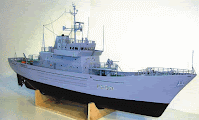 |
| HMS Hannibal | In 1895 the first of the Majestic class battleships came into service. This started a naval revolution as startling as the one that followed the launching of the DREADNOUGHT. For the first time 4 new sets of designs were put together in one ship making them what is now known as a PREDREADNOUGHT. The four new technologies were high velocity main weapons, quick firing 6" mid calibre guns. face hardened armour, and telescopic gunsights. The MAJESTICS were the first capital ships whose main weapons were effective in rough seas due to their high freeboard and good sea keeping qualities. The visual impact of these ships at that time cannot be imagined, but they must have been the same as the "star wars" weapons of today, and they made the British fleet supreme the world over. Details of the kit Scale 1/96 Length 1.34m Beam 266mm Sailing weight 12kg One of the most complicated and detailed model in the Deans fleet, and truly the PRIDE OF THE FLEET. Some of the major features of this model are the one piece fibreglass hull with all plating detail and armour belt, plus all casemates, hatches portholes, anchor bedplates, and the massive ram bow all moulded into the hull; one piece fibreglass moulded superstructure with deck planking and gun port detail engraved into the moulding. Full size plan in 2 parts with photo exploded instruction book to ease assembly of this massive model. A large sheet of brass etchings with over 300 items, adds the final super-detail to the majestic model. Over 400 cast metal fittings & 100 plus cast plastic items add the detail to this model, decks from marine ply, and 62 vacformings for boats, turrets etc. | 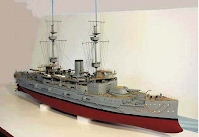 |
| HMS Hardy | The original idea for Frigate design after World War 11 was that they should be of a single hull design that could be fitted out for various purposes. The type 14 which Hardy represents was the design for the minimum A/S frigate. She was built from prefabricated welded sections to allow for rapid assembly. Fitted with a single screw and powered by a Y100 single turbine gave a top speed of 28 knots on a modest output of 19,000 s.h.p. Much faster than wartime frigates of a simular size. The manoeuvrability of this hull design was outstanding and many are the stories of most of the crew breaking arms and legs. Without doubt, if they ever got their teeth into a submarine, with their 2 mortar MK 10's, the chances of it getting away would have been remote. Hardy was built at Yarrow and launched on the 25th November 1953. Details of the kit Scale 1/96 Length 977m Beam 95mm Sailing weight 2.4kgs A lightweight glassfibre hull is the base for this model and to ease construction the break of the fo/castle is a separate moulding. Decks and all superstructure are constructed from printed plastic sheets, and to finish the model a complete set of fittings in cast light alloy and cast plastic are included. The complicated lattice mast is an alloy casting, all stanchions, ladders etc are in brass etched format. Comprehensive instructions and a FULL SIZE PLAN are included to ease assembly....... |  |
| HMS Inflexible | H.M.S. Inflexible was launched at the Royal Dockyard Portsmouth in 1876 and was armed with 4 x 16” MLR guns in two turrets set en-echelon. Plus 2 x t/tubes and 2 x torpedo carriages, a varied assortment of guns from 4.7” to 20pdrs and many lighter weapons, with 8407 IHP she could make 14.75 knots. The importance of Inflexible, in design terms, is that she was the supreme example of the citadel ship, designed to take punishment. The central part of the ship is a huge cofferdam, protecting the engines, boilers and magazines, with up to 24 inches of armour making her the most heavily armoured ship even built. It was universally agreed that she was the ugliest ship afloat, however her size and gun power caught the publics imagination, plus the wrangling between the designer N Barnaby and the chief constructor E Reed made this ship such a sensation as in the Dreadnought debate a quarter of a century later. She served twice in the Med and as guard ship to Portsmouth in 1901, and was sold for breaking up in 1903. Details of the kit Scale 1/96 Length 1012mm Beam 290mm Sailing weight 12.2Kgs The most complicated and detailed model in the Deans Marine collection and truly the latest in the PRIDE OF OUR FLEET. Some of the major features of this model are; the one piece fibreglass hull with all plating and portlight details, the Rambow is a separate glass fibre casting, one piece fibreglass moulded Glacis plate with non-slip, and gun port detail engraved into the moulding, the two turrets are also glass fibre mouldings, as are the two funnels and uptakes. Decks are from 1.5mm pre printed plastic, the superstructure is from 1mm and .5mm plastic, there are 17 vacformings for boats, decks etc, the deck planking is pre-printed on cast vinyl and is self adhesive. A complete set of fittings which adds the detail to this model is included in the kit, there is over 400 cast metal plus over 100 cast plastic fittings for example the weapons, deck fittings, etc., are cast in light alloy, larger items such as lockers, floats, and gun bases are moulded in plastic for light weight. The ratlines, such a difficult part of a ship of this type are in etched brass along with fine detail parts such as door hinges, cable reels, Ladders and stanchions, other fittings included are the Propshafts in stainless steel, cased in brass proptubes that have replaceable bearings and are fitted with oilers, not forgetting the rudder and tiller arms. Full size colour plan with embedded digital pictures for detail, Instruction book with sketches and assembly drawings plus a second book of photo exploded pictures and information to ease assembly of this massive model, a colour chart and painting instructions are also included to add the finishing touch to this most powerful looking model as a worthy and much requested addition to our warship range. | 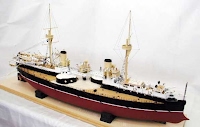 |
| HMS Javelin | Name ship of the class, the Javelin was one of the famous J.K.N. class destroyers that served with distinction through W.W.11 and it was this class of ship that suffered the highest losses through being sent in to the fiercest fighting. The three groups of this class were based on the "Intrepid" and "Tribal" classes and were the first single funnelled destroyers in the Royal Navy since the A class of 1895. Javelin was launched at the JOHN BROWN yard on 21st December 1938 with her original name of KASHMIR. Later re-named she served through the war making her one of the 2 of this class that survived, she was broken up on 17th June 1949. Details of the kit Scale 1/96 Length 1.13m Beam 114mm Sailing weight 3.1kgs This model of the famous ship is based on a full plated glass fiber hull with ports and intakes moulded in. The decks and superstructures are in 1mm & .5mm printed plastic sheet. Vacforms supply the hard parts such as gun shields, funnel and the ships boats etc with over 600 cast metal and plastic fittings assisting in making up the classic destroyer. As in all of the kits in our range it includes a FULL SIZE PLAN to complement the comprehensive instructions. Brass etchings are supplied to assemble the complicated lattice mast, stanchions, ladders etc. The colour scheme supplied is for the ship in her pacific fleet scheme with its blue panel on the ships hull. | 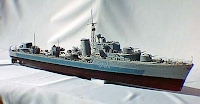 |
| HMS Kelly | H.M.S. KELLY was launched on the 25th October 1938 and began her short but active career when handed over to Captain, Lord Louis Mountbatten Royal Navy on 23rd August 1939. In May of the following year she was torpedoed by a German "E" Boat, nearly tearing her in half. For 91 hours, whilst under tow, she and her consorts fended off the unwelcome attentions of both "E" Boats and enemy bombers. Although many said she could never be repaired the work was completed and on re-commissioning she was ordered to the Mediteranian. During the evacuation of Crete in 1942 whilst in the company of H.M.S. Kashmir she was attacked and hit in the boiler room by a bomb that passed down the funnel. Still under way and with full helm she turned on her beam ends and sank. Details of the kit Scale 1/96 Length 1.13m Beam 114mm Sailing weight 3.1kgs The model kit of this famous destroyer is based on a moulded glass fiber hull with full plating detail, ports, etc. As in most of the kits, superstructure and decks are in 1mm and .5mm plastic. To finish the model to the high detailed standard of all the Deans range, the main weapons, close range weapons and numerous small highly detailed fittings are cast in light alloy or vac-cast plastic. This is to save top weight and to give outstanding performance of this type of model on the water. This model is capable of being thrown around the lake at a scale speed in excess of 30 knots. To add the finishing touch and to give a near showcase model all complicated items such as gun turrets, funnel, boats etc are in vacformed plastic, brass etchings for stanchions, ladders etc giving a strong model to take the odd knocks and bumps. | 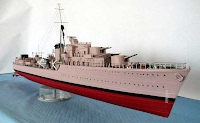 |
| HMS Loch Katrine | The ships of the Loch class of A/S frigates represent the final product of wartime design of frigates. They were designed to be mass produced in sections at dispersed sites and transported to an assembly point at a slipway. She was constructed at H. ROBB & Co in Lieth, laid down in 1943 and launched 21/8/44 Welding and riveting were used to speed production and a team of 60 men could build a ship of this class. With a single 4” gun on the focastle for surface action, the main weapons were beyond doubt the twin squid anti-submarine mortars, along with the high mounted rapid firing twin 20mm guns for anti-personnel work. Only 28 Loch class ships were completed as Loch class frigates and a further 19 finished as the Bay class. To speed construction curved structures were eliminated in the design and a noticeable result of this was the deck sheer was reduced to three straight lines As completed the ships displaced 1435 tons. The power was supplied by four cylinder, triple expansion engines (yes that is correct) of 5,500 ihp driving two shafts giving a speed of 19.5 knots. Weapons fit was a single 4” mkv, a quad 2pdr, and 4 x twin 20mm Oerlikons. Two 3 barrel squid mortars were fitted forward and two D/C mortars fitted to the quarter deck with a single D/C rail aft. Following the end of hostilities many ships were laid up or sold. The LOCH KATRINE was transferred to New Zealand in 1949 and renamed the H.M.N.Z.S ROTOITI. She was broken up in Hong Kong in 1962. Details of the kit Scale 1/96 Length 985mm Beam 122mm Sailing weight 3.02 The fibreglass hull in this kit is with full plating and port detail. Computer generated printed plastic forms the main superstructure along with the 1mm plastic deck. To complete the construction of the model all complex parts are vacformed in 1mm plastic for funnel, boats, turret etc. A complete set of fittings are included in the kit with all detail parts such as weapons, deck fittings, etc, cast in light alloy. Larger item such as lockers, floats, and gun bases are moulded in plastic castings for light weight. The lattice mast, such a notable feature of this class of ship is assembled from etched brass in four parts for simple assembly. Ladders and stanchions are also in etched brass to give a final showcase finish. Propshafts in stainless steel are cased in brass proptubes with fitted oilers and replaceable bearings along with rudder and tiller arm. These, together with a comprehensive instruction book and a FULL SIZE PLAN assist in the assembly of this impressive model. A colour chart and a set of precut decals for the pennant number are included in the kit to add the finishing touch to this most attractive addition to our warship range. | 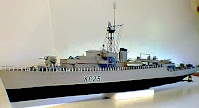 |
| HMS Magnificent | In 1895 the first of the Majestic class battleships came into service. This started a naval revolution as startling as the one that followed the launching of the DREADNOUGHT. For the first time 4 new sets of design's were put together in one ship making them what is now known as a PREDREADNOUGHT. The four new technologies were, high velocity main weapons, quick firing 6" mid calibre guns. face hardened armour, and telescopic gunsights. The MAJESTICS were the first capital ships whose main weapons were effective in rough seas due to their high freeboard and good seakeeping qualities. The visual impact of these ships at that time cannot be imagined, but they must have been the same as the "star wars" weapons of today, and they made the British fleet supreme the world over. Details of the kit Scale 1/96 Length 1.34m Beam 265mm Sailing weight 12.2kgs The most complicated and detailed model in the Deans fleet and truly the PRIDE OF THE FLEET. Some of the major features of this model are the one piece fiberglass hull with all plating detail and armour belt, plus all casemates, hatches portholes, anchor bedplates, and the massive ram bow all moulded into the hull; one piece fiberglass moulded superstructure with deck planking and gun port detail engraved into the moulding. Full size plan in 2 parts with photo exploded instruction book to ease assembly of this massive model. Over 400 cast metal fittings & 100 plus cast plastic items add the detail to this model, decks from marine ply and 1mm plastic, and 62 vac-formings for boats, turrets etc. | 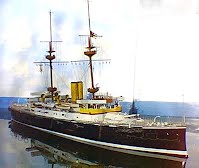 |
| HMS Manxman | The Abdiel class of fast minelayers was a most successful design of ship, the first group being launched in 1940. The class of ship was dependent of sustained high speed for mine laying operations. Manxman was constructed at Stephen Hawthorn Leslie works and launched 0n 5/9/40 She was powered with 2 shaft geared turbines with 72,000 S.H.P giving a top speed of 40 + knots with a full load of 156 mines. Manxman served through-out WW 11 and lasted until the 70s as m/S support ship based in Malta. This class of successful ships will always be remembered for their wartime exploits. Built for mining operations in enemy waters they were exceedingly effective in that role. Their outstanding attributes of very high speed and considerable enclosed carrying capacity only added to their usefulness when it came to running troops and supplies through enemy defensives in the Mediterranean sea, the first four the class made a very important contribution helping to sustain Malta in 1942 Details of the kit Scale 1/96 Length 1.34m Beam 150mm Sailing weight 5kgs The fiberglass hull in this kit is with full plating and port detail. The large stern mine laying doors and all outlets are moulded into this hull. Computer generated printed plastic forms the main superstructure along with the 1mm plastic deck. To complete the construction of the model all complex parts are vacformed in 1mm plastic for funnel, boats, turrets etc. A complete set of fittings are included in the kit with all detail parts such as weapons, deck fittings, etc, cast in light alloy. Larger item such as lockers, floats, and gun bases are moulded in plastic castings for light weight. The two large mine loading cranes, such a notable feature of this class of ship are assembled from etched brass in 9 parts for simple assembly. Ladders and stanchions are also in etched brass to give a final showcase finish. Propshafts in stainless steel are cased in brass proptubes with fitted oilers and replaceable bearings along with rudder and tiller arm. These, together with a comprehensive instruction book and a FULL SIZE PLAN assist in the assembly of this impressive model. A colour chart and a set of decals for signal flags are included in the kit to add the finishing touch to this most powerful looking model as a worthy and much requested addition to our warship range. |  |
| HMS Marvel | ALGERINE MINESWEEPERS These ships were built between 1942 and 1945 and were fitted with magnectic, acoustic, and mechanical sweeping equipment. It would seem that this class of ship developed from the Halcyon class of minesweeper of the 1930's still retaining some of their general appearance. These ships, having been built in the U.K. and Canada, later served in the Canadian and most Western Alliance Navys. Details of the kit Scale 1/96 Length 762m Beam 120mm Sailing weight 2.21kgs The model is based on a plated fibre glass hull. All decks and superstructure are in 1mm printed plastic sheet format with turret, funnel, boats etc in vacformed plastic. Weapons and fine detail fittings are in cast in light alloy, and all larger items are cast in lightweight plastic. Stanchions and ladders for that extra fine detail are in etched brass. Propshafts and tubes are included in this kit along with the rudder and tiller arm. THE FULL SIZE PLAN is from the D McGregor range. With its twin screws and twin motors and short length/beam ratio this makes into one of the busiest little models in our range and she has all the outstanding handling qualities of her bigger and full size sister. The close range weapons fit on this model are 4 40mm bofors guns. The kit contains a comprehensive set of instructions. | 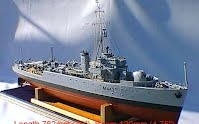 |
| HMS Mohawk | Tribal class or "F" class destroyers 1905 1908 programme. One of the policies of the first sea lord in 1904 was the production of an ocean going destroyer which should have the following capabilities:- A. Steam at 33 knots for 8 hrs in a moderate sea B. Burn oil fuel C. Carry 2 x 12.lb guns D. Carry 7 days provisions "later 4 days" This was something of a revolution in ship design requirements for those days, being 7.5 knots faster than any previous design particularly when the then novel turbines had yet to be built and tested (only 8 types were in service). Tenders were at last taken up and building of the new "F" class began, divided into 3 separate groups. With no fewer than 7 different yards involved it is hardly surprising that few of the ships looked the same. The 3 groups are: 1905-1906 1906-1907 1907-1908 AFRIDI AMAZON CRUSADER COSSACK SARACEN MAORI GHURKA NUBIAN MOHAWK VIKING TARTAR ZULU The class was completed at an average cost of £137,000. On trials with a displacement of 1,000 tons a speed of 33 knots was achieved. The complement was 5 officers and 56 men. Details of the kit Scale 1/96 Length 901mm Beam 89mm Sailing weight 1.25kgs The models are based on the period after the original ships' sea trials, when a number of modifications were carried out. To this end all ships were changed – up gunned to 2 x 4inch guns forward funnels lengthened so that fumes cleared the bridge, turtle decks removed to a standard fo/castle. This gave the ships the classic destroyer outline. The base of these models is a one piece vacformed or moulded fibreglass hull with all superstructures and decks in 1mm plastic, for one glue construction. These models are designed with the beginner in mind and as a good starter to the world of warship modelling. They embody all the excitement of the building and driving of a warship without the task of constructing a full fleet model. The simple structure on the decks of these ships makes for very quick construction and with all funnels and boats in vacformings, allied with a full set of fittings in cast light alloy and cast plastic makes for an attractive model. These ships have all the performance of their bigger sisters and have one of the most outstanding sea keeping qualities of all the models in the range. As the choice of motor and couplings is very important in the construction of these ships they can be supplied with the kit on request. THIS MODEL IS BASED ON A PLATED GLASS FIBRE HULL THE KIT IS IN SINGLE SCREW FORMAT AND RUNS ON 4 OR 5 1,2AH NICADS. | 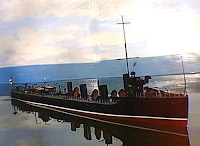 |
| HMS Morcambe Bay | The Morcambe Bay was constructed by W Pickersgill in Sunderland and laid down on the 30/4/44 and launched on 1/1/44. On a displacement of 2530 tons at full load she was powered by 2 x Admiralty three drum boilers driving four cylinder, triple expansion (yes that is correct) giving a total of 5.5oohp with a top speed of 19.5 knots. The ship carried a compliment of 157 men. In 1944 as the war moved to the Pacific, it was noted that a escort ship with a heavy A/A firepower was required to accompany the British fleet. A quick cure was to modify some of the Loch class frigates then under construction. Accordingly 26 of the class were designated A/A frigates and called the Bay class. The hull, superstucture, engines and basic layout of the new class remained unchanged. The major changes were to the ships weapons, which consisted of two twin 4” A/A mountings and two twin 40mm bofors. Fire control for the 4” guns was by Mkv director with a 285 radar, The 40mm s were directed by a simple tacymetric director on each mounting. For Anti_Sub use a Hedgehog mortar was mounted on thebfo/castle, whilst on the quarter deck was the usual outfit of rails and mortars. Of the 26 vessels only 19 were completed as Bays, Six ships were completed to different designs such as survey vessels and despach vessels, one was cancelled. The excellent seakeeping qualities of the hulls were ably demonstrated on several occasions when ships of the class rode out Typhoons which were a common hazard in the Far East. By the mid 1950 the usefulness against modern aircraft was in decline, so in 1956 the first of the class went to the breakers. Several ships were sold abroad. Mounts Bay and Morcambe Bay were sold to the Portuguese Navy after a refit at Thorneycrofts yard. as the Vaso da Gama and the Dom Francesco de Almeida. She was scrapped on the 7/9/70. Details of the kit Scale 1/96 Length 985mm Beam 122mm Sailing weight 3.02 The fiberglass hull in this kit is with full plating and port detail. Computer generated printed plastic forms the main superstructure along with the 1mm plastic deck. To complete the construction of the model all complex parts are vacformed in 1mm plastic for funnel, boats, turret etc. A complete set of fittings are included in the kit with all detail parts such as weapons, deck fittings, etc, cast in light alloy. Larger item such as lockers, floats, and gun bases are moulded in plastic castings for light weight. The lattice mast, such a notable feature of this class of ship is assembled from etched brass in four parts for simple assembly. Ladders and stanchions are also in etched brass to give a final showcase finish. Propshafts in stainless steel are cased in brass proptubes with fitted oilers and replaceable bearings along with rudder and tiller arm. These, together with a comprehensive instruction book and a FULL SIZE PLAN assist in the assembly of this impressive model. A colour chart and a set of precut decals for the pennant number are included in the kit to add the finishing touch to this most attractive addition to our warship range. | 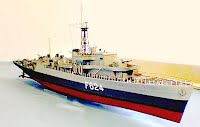 |
| HMS Nubian | The frigates of the Tribal class were constructed to perform three functions, Air Direction, Anti-Aircraft and Anti-Submarine duties. For this reason they were classed as general purpose frigates. When launched they were quite an advanced vessel as they included many "firsts" in their design. The TRIBALS were the first ships to be fitted to carry a helicopter, having a hangar between the aft 4.5" gun and the mortar mk10. They were the first ships to be fitted with the seacat missile system and, most novel at the time, the engines comprised a steam turbine propulsion system (COSAG) and a gas turbine which could be used for additional boost and to get away from a cold start. The single shaft is powered from the combined steam and gas turbines, the former developing 12,500 shp, and the latter developing 7,500 shp. This indicated a top speed of 28 knots. All engine control rooms were air conditioned as was the rest of the ship.. The weapon fit of the class was 2 x 4.5" guns 2 x 4 seacat launch pads (or 2 x 4mm bofors) 1 x 3 barrel mortar mk 10. Some ships were later fitted with 2 x 20mm oerlikons as "junk bashers". 2 x 8 barrelled 3" decoy rocket launchers are also fitted port and starboard. Details of the kit Scale 1/96 Length 1.1m Beam 141mm Sailing weight 4.5kgs This was the first kit in the range to have MOD 11.This was the decision by DEANS MARINE to scrap all of the kits in the range that are left behind in the development process. The model is then remade as a totally new kit based on a new hull and fittings that bring it up to the standards of the later kits in the range that have had the advantage of the latest construction methods. As in all of our products lots of brass etchings are included for stanchions, ladders The enormous lattice mast and the bedstead radar that was such a notable feature of these ships. The brass etching makes this a simple construction job. The Mod 11 programme will be carried out on all kits in the range throughout the life of the model. Although this is a large model for a frigate she sails and steers well, being capable of almost "on the spot" turns. | 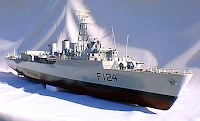 |
| HMS Sentinal | The Sentinel class of cruiser came from Vickers yard in 1905, had a ram bow, three funnels, and a turtle back fo/castle. The four, triple expansion engines developed 17,500 h .p. giving a speed of 25 knots. The ships of this class were small fast cruisers referred to as scouts. They arose from the need for a fast ship to perform a scouting role in the North Sea and keep an eye on the increasing activity by the German navy in that area. Coupled with this role was the requirement for a flotilla leader to the small seagoing destroyers. These ships had to have the ability to work with their brood, but to still provide for the captain and his staff. Whilst lightly armed, compared with a third class cruiser they had a high speed which enabled them to "scout" in the knowledge that they could outrun any serious opposition. A total of 15 scouts were completed between 1905 and 1913 all with differences in construction. Details of the kit Scale 1/96 Length 1.14m Beam 140mm Sailing weight 4.5kgs The plated fibreglass hull is the base for this model, along with the superstructure from computer printed 1mm plastic for the main assembly and a sheet of .5mm printed plastic adding the final sharpness to this elegant model. To add all the detail over 450 fittings cast in light alloy or plastic are included in the kit. Vacformed plastic mouldings take care of all the larger and more complex parts such as the many ships boats, funnels, vents and funnel bases. The many stanchions on this model are cast in light alloy to give the correct pattern of spacing, with 2 gauges of brass wire for the stanchion wires. Brass etched ladders add the finest detail and delicate touch to this model, one of the classics amongst warships. Although a large model by small ship standards the handling and sea-keeping qualities are outstanding. A comprehensive instruction book is included in the kit keyed to a FULL SIZE PLAN and large format exploded view. As in all the kits in the range, a full set of running gear is included in the kit. To add to the classic look of the ships of this era 2 colour schemes are included in the instructions. The black hulled victorian livery gives a great presence and for an alternative scheme the colour of China station are included along with the standard Atlantic fleet grey. Tips are also in the instructions for the use of the modern ACRYLIC car spray paints that are giving such outstanding results. | 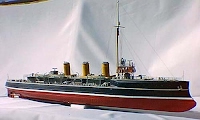 |
| HMS Skirmisher | The Scout class of cruiser came from Vickers yard in 1905 and had a ram bow, three funnels, and a turtle back focastle. The four, triple expansion engines developed 17,500 h.p. giving a speed of 25 knots. The class were small fast cruisers referred to as scouts. They arose from the need for a fast ship to perform a scouting role in the North Sea to keep an eye on the increasing activity of the German navy in that area, Coupled to this role was the requirement for a flotilla leader to the smaller seagoing destroyers. These ships had to have the ability to work with their brood, but still provide for the captain and his staff. Whilst lightly armed compared with a third class cruiser they had a high speed which enabled them to scout in the knowledge that they could outrun any serious oppositon. A total of 15 "Scouts" were completed between 1905 and 1913 all with differences in construction. Skirmisher can be considered typical of the class. Details of the kit Scale 1/96 Length 1.14m Beam 140mm Sailing weight 4.5kgs The plated fibreglass hull is the base for this model along with the superstructure from computer printed 1mm plastic for the main assembly. A sheet of .5mm printed plastic adds the final sharpness to this elegant model. To complete the detail over 450 light alloy and cast plastic fittings are included. Vacformed plastic mouldings take care of all the larger and more complex parts such as the many ships boats, funnels, vents and funnel bases. The many stanchions on this model are cast in light alloy to give the correct pattern of spacing, with 2 gauges of brass wire for the stanchion wires. Brass ladders add the finest detail and delicate touch to this model, one of the classics amongst warships Although a large model by small ship standards the handling and sea-keeping qualities are outstanding. A comprehensive instruction book is included in the kit keyed to a FULL SIZE PLAN and large format exploded view. As in all the kits in the range, a full set of running gear is included. To add to the classic look of the ships of this era 2 colour schemes are included in the instructions. Black hulled Victorian livery gives a great presence and for an alternative scheme the China station livery is included, along with the standard Atlantic fleet grey. Tips are also given in the instructions for the use of the modern ACRYLIC car spray paints that are giving such outstanding results. | 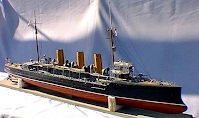 |
| HMS Solebay | This model is of a class of warship that many shiplovers think is the most handsome and elegant of all ships to serve in the Royal Navy. The speed, lines, and offensive power of the armed destroyers has always captured the imagination of all warship enthusiasts, and the Battle class combines all of the best with a powerful gun armament. The completion of these war designed ships ran on well into 1947 being built alongside the famous Emergency class ships. The ships are referred to as the 1942 class, and most handsome they were in appearance. They embraced all the features that had been learnt during the war years, but so complicated was the weapons fit that only one of the class was completed by 1944. A further six ships joined the fleet in 1945. The last of the fleet was completed in 1948. A brief history of H.M.S. Solebay follows as this ship is a representative of the class. She was built by Hawthorn Leslie, Hebburn on Tyne and launched on 22/2/1944 and was completed 11/10/1945. She was the leader of the 5th destroyer flotilla from completion until 1953, so she would have carried the broad black band around her funnell She was at the Coronation review at Spithead on 15/6/53. After this she was paid off into reserve at Chatham. In 1957 she joined the 1st Destroyer squadron on Med/Home service. In 1959 she was deployed to the Far East returning in 1960 for a further Home/Med service. In 1962 returned to Porsmouth to become harbour training ship. She was broken up in Troon in 1967. Details of the kit Scale 1/96 Length 1.21m Beam 152mm Sailing weight 4.1 The model of H.M.S SOLEBAY is constructed on a fully plated glassfibre hull with ports, asdic and intakes moulded in, all to the official admiralty drawings. The decks and superstructure are in 1 & .5mm computer generated printed plastic. Ships boats (with options) the funnel and the staag mounting shields are supplied as vacformings. For the first time the main armament and director are resin mouldings resulting in extremely sharp and accurate fittings. Cast metal, etched brass mast ,stanchions, and resin fittings add the truly professional touch to this classic destroyer model. Propellor tubes, fitted with oiling points and stainless steel shafts are included together with a comprehensive instruction book and a FULL SIZE plan. Full details are supplied for the fitting of motors, nicads and radio equipment. | 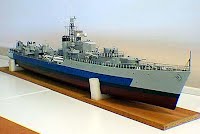 |
| HMS Tanatside | In 1938 the Navy saw the need for a small, fast destroyer type of ship, to carry out escort and screening duties for convoys with a reasonable Anti Aircraft and Anti Submarine capability together with good sea keeping. Tanatside was one of the large number of the Hunt class built in the three main types with 2 of the class in a forth group. Tanatside was launched at the Yarrow ship yard on the 30th April 1942. For the full story of the Tanatside and her career we recommend the book by Captain Roger Hill "Destroyer Captain". Details of the kit Scale 1/96 Length 889m Beam 101mm Sailing weight 2.1kgs A plated fibreglass hull forms the base for this model of these "Pert" little ships. Decks and superstructure are in 1mm printed plastic sheet with .5mm sheet for the 2 main structures. To complete this detailed little ship over 150 cast metal and cast plastic items along with vacforming for all gun shield, gun cabs, ship boats are provided. Etched brass for the stanchions give the finishing touch to the dainty appearance of this ship. As in all the kits it is complete with all running hardware ie; proptubes, propshafts in stainless steel, rudder, tiller arm etc. "On the water" performance and steering are outstanding as proved by Mr. M. Demain who held the Kit class National place for 3 years with one of these ships.... |  |
| HMS Vanquisher | This class of destroyer is most probably the best known and the most successful to serve in the Royal Navy. They were the most numerous and longest serving class of ships ever built. The Vanquisher was completed at J. Brown & Co on the Clydebank in 1917 on a displ, of 1,090 tons with engines of 27,000 s.h.p. to give a maximum speed of 34 knots. Vanquisher served in the Royal Navy throughout the second world war when she was converted to a long range escort. Almost totally worn out after her long and strenuous service she was sold for scrapping in March 1947. Thought by many to be the best looking of all the British destroyers constructed, these ships were the most coveted command of many a naval officer. The classic lines of these ships can be seen in a larger size in all following British ships in the A to I class, of which the Daring is an example. Details of the kit Scale 1/96 Length 1.03m Beam 95mm Sailing weight 2.4kgs This model captures the attractive and dainty looks of this class of ships. The plated fibreglass hull with its slender lines gives a good start to the model. All deck and superstructure parts are in printed 1mm & .5mm plastic sheet, with vac-formings used for the boats, funnels, gun shields and in the mounts of the triple t/tubes carried in this class of ship. To complement the kit over 400 fittings in cast light alloy and cast plastic give the clutter and detail to enable a working model of showcase standard to be produced. | 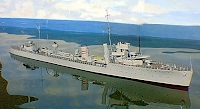 |
| HMS Verulam | On the night of the 16th May 1945, in company with 4 other vessels, Verulam, with Saumarez as the leader, proceeded into the straights of Malacca, where they located the Japanese cruiser "Haguro" and the destroyer KamiKaze. During this comparatively short action the Haguro was hit by 8 torpedoes and later sank, whilst the "KamiKaze" was hit by shell fire but escaped. Verulam was not damaged in this incident and it was considered to be the only classic destroyer attack of the second world war when torpedoes were fired. Verulam was built by Fairfield and Co and launched on the 23rd March 1943. Her trial displacement was 2,225 tons and over the measured mile she attained the speed of 32.7 knots. She was broken up on 23rd October 1972. Details of the kit Scale 1/96 Length 1.15m Beam 114mm Sailing weight 3.3kgs The plated glassfibre hull is the basis for this model of one of the fastest destroyers of W.W.11. The superstructures and decks are in 1mm plastic to give the crisp finish so noticeable on this type of ship. Funnels, ships boats, gun shield are in vacformed plastic for quick construction. To add the glasscase detail to the model further fittings are included in cast light alloy and plastic, together with propshafts and propellers. A full set of instructions and A FULL SIZE PLAN assist in the construction of this most elegant model which has earned the nickname the 40 knot "razor blade". | 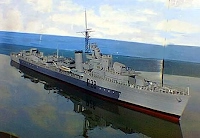 |
| HMS Zulu | The frigates of the Tribal class were constructed to perform three functions, Air Direction, Anti-Aircraft and Anti-Submarine duties. For this reason they were classed as general purpose frigates. When launched they were quite an advanced vessel as they included many "firsts" in their design. The TRIBALS were the first ships to be fitted to carry a helicopter, having a hangar between the aft 4.5" gun and the mortar mk10. They were the first ships to be fitted with the seacat missile system and, most novel at the time, the engines comprised a steam turbine propulsion system (COSAG) and a gas turbine which could be used for additional boost and to get away from a cold start. The single shaft is powered from the combined steam and gas turbines, the former developing 12,500 shp, and the latter developing 7,500 shp. This indicated a top speed of 28 knots. All engine control rooms were air conditioned as was the rest of the ship.. The weapon fit of the class was 2 x 4.5" guns 2 x 4 seacat launch pads (or 2 x 4mm bofors) 1 x 3 barrel mortar mk 10. Some ships were later fitted with 2 x 20mm oerlikons as "junk bashers". 2 x 8 barrelled 3" decoy rocket launchers are also fitted port and starboard. Details of the kit Scale 1/96 Length 1.1m Beam 141mm Sailing weight 4.5kgs This was the first kit in the range to have MOD 11.This was the decision by DEANS MARINE to scrap all of the kits in the range that are left behind in the development process. The model is then remade as a totally new kit based on a new hull and fittings that bring it up to the standards of the later kits in the range that have had the advantage of the latest construction methods. As in all of our products lots of brass etchings are included for stanchions, ladders The enormous lattice mast and the bedstead radar that was such a notable feature of these ships. The brass etching makes this a simple construction job. The Mod 11 programme will be carried out on all kits in the range throughout the life of the model. Although this is a large model for a frigate she sails and steers well, being capable of almost "on the spot" turns. |  |
| HMY Britannia | The origins of Britannia can be followed back to 1938 when it was agreed that the current yacht Victoria and Albet 111 was due for replacement. The Admiralty prepared a set of outline drawings for tender. The start of WW11 postponed the project until 1952 when the idea was revived and subsequently ordered from John Browns shipyard on the Clyde due to their expertise in constructing top class ships such as the Queens and the Coronia. The design specifications for the ship are impressive for she had to be capable of continuous operations in the Arctic and Tropical waters. She is capable of a continuous sea speed of 21 knots and has a range of 2,000 miles at full speed on a displacement of 4,715 tons. Two Steam turbines on each shaft provide a total of 12,000 h.p and in full speed burn 117 tons of fuel a day. Electrical power is provided by three 500 KW steam turbo generators and a single 270 KW diesel for harbour duties. The ships company comprises twenty one officers and 256 men and when on Royal duties a twenty six piece Royal Marine band. Within her design the utmost care has been taken in fine details, a few examples are, the funnel has been carefully shaped and fitted with internal filters plus the exhaust gas speed has been uprated to ensure that no soot falls on the decks. A flange is fitted around the top edge of the funnel to trap water and this is piped down inside to prevent the top of the funnel becoming stained. The funnel also acts as a derrick post for the two booms, To preserve the lines the eye plates hinge back into the casing when not in use and cover plates are fitted. Other fine points are the freeing ports/ bulwark doors are open at sea as required but can be closed when not in use to preserve the unbroken line of the bulwarks. The front of the bridge has been designed in a wind tunnel to prevent any strong wind eddies forming. Denny brown active fin stabiisers were a new feature at the time, the twin fins can reduce a roll of twenty degrees to six degrees at a speed of 17 knots. The ships engines are staggered at 10 r.p.m difference to help reduce vibrations Britannia, as can be expected is constructed to lloyds 100A1 standard following naval practice the platform deck is watertight throughout and the lower hull is divided by fifteen watertight bulkheads. To produce the immaculate finish on the hull the steel above the waterline is riveted but worked flush. Below the waterline the plate are lapped and the forward edges are faired woth composition to reduce drag. The ship is designed to convert to a hospital ship in times of crisis, she can accomodate 200 patients within the spaces accupied by the Royal apartments She was named and launched by Her Majesty The Queen on the 16th April 1953 as the previous ship of this name was King George V11s racing yacht which was scuttled on his death in 1936. The fate of Britannia at the present time is undecided although the Queen has expressed the wish that some future role be found for the ship rather than see her broken up Details of the kit Scale 1/96 Length 1.3m Beam 178mm Sailing weight 4.3kgs The model of Britannia is based on a fibreglass hull with bulwarks, portholes, proptube exits and bilge keels moulded into the hull. The construction of the superstructure is from computer generated printed plastic in 1mm and .5m. To finish the assembly vacforms are provided for the funnel and all ships boats for those who wish to add lots of detail. Also included as an option are a complete set of the ships motor boat hulls with all detail moulded into the castings to give two options for the model. To add the finishing touch, all fittings are included cast in light alloy or plastic. Brass etchings are supplied for the Ships stanchions and ladders. Proptubes fitted with oiling tubes and stainless steel shafts are included together with a comprehensive instruction book to aid assembly with sketches and pictures to assist in the construction. All part numbers are keyed to the FULL SIZE PLAN included in the kit. Full details are supplied for the fitting of motors, nicads, and radio equipment. | 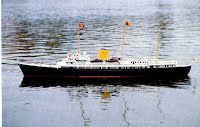 |
| Landing Ship [Medium] | The LSM is an ocean-going amphibious assault ship 203’ 6” long, with a beam of 34’ 6”. During 1944-45 the crews consisting of 48 enlisted men and 4 officers were assembled and trained at the Naval Amphibious Base, Little Creek, VA. The ship could transport 50 troops and 6 Mark VI medium tanks. Armament was 1 Bofers twin or a single 40mm cannon, 4 each 20mm anti-aircraft guns and 7 each 50 caliber machine guns (this could vary). She was powered by two diesel engines [ General Motors Model 16-278A or Fairbanks Morse Model 38D8 1/8 x 10] with 2,800 shaft horsepower and a speed of 13 knots. LSMs were flat bottomed and drew 6-7 feet when loaded. Their primary mission was to transport tanks, vehicles, equipment, personnel and supplies to the beaches. Beaching was accomplished by dropping a stern anchor approximately 100 yds from the beach, and then running up on the beach usually between 2/3 and full speed ahead. The bow doors were opened and the ramp lowered to off-load the cargo. The twin propellers were sometimes kept running in the ahead mode to keep the ship on the beach as she was unloading. Retracting from the beach was accomplished by reversing the engines and hauling in the stern anchor. Between 1944-45 554 LSMs were built at six different US shipyards. Sixty hulls were converted or built as LSMRs, rocket ships with a crew of five officers and 133 enlisted men. In addition to rocket launchers and mortars LSMRs were armed with a 5” 38 calibre dual purpose gun, 2 each twin 40mm cannons and 2 each 20mm anti-aaircraft guns( this could vary). These small ships had more fire power than the Battleship IOWA. Most LSM and LSMRs served in the Pacific during WWII [none in Europe] and most participated in assault landings on the Phillipines, Iwo Jima and Okinawa. This action was followed by occupation duty in Japan, Korea and China. Thirty nine craft served during the Korean war and three saw action in Vietnam. LSM 161 was the last one to see commissioned service in the US Navy and was stricken from the records on 1 June 1965. Following WWII 129 were transferred to the navies of twenty five different countries. Some remain on active duty in Greece, Korea and Taiwan and maybe Communist China. Some remain in use by private industry in the USA including two on the west coast - the salvage ship SALVAGE CHIEF (formerly LSM380) and the first factory ship WESTERN SEA (formally USS PEE DEE RIVER - LSMR 517). Eighty nine LSMs and eighteen LSMRs were converted to barges some of which are still in use. Note that in October 1955 seven LSMs that were on active duty and all the 401 and 501 class LSMRs were assigned names. The LSMRs were named after minor US rivers. Details of the kit Scale 1/72 Length 910mm Beam 150mm Sailing weight 2.0kgs The fibreglass hull in this kit is with full rubbing strip and port detail. Computer generated printed plastic forms the main tank deck and basic superstucture along with the 1mm plastic deck. To complete the construction of the model all complex parts are vacformed in 1mm plastic for bridge, boat, motor mounting and nicads tray etc. A complete set of fittings are included in the kit with all detail parts such as weapons, deck fittings, etc, cast in light alloy. Larger item such as lockers, floats, and gun bases are moulded in plastic castings for light weight. Ladders and stanchions are also in etched brass to give a final showcase finish. Propshafts in stainless steel are cased in brass proptubes with fitted oilers and replaceable bearings along with rudders and tiller arms. These, together with a comprehensive instruction book and a FULL SIZE PLAN assist in the assembly of this impressive model. A colour chart, plus a set of decals, are included in the kit to add the finishing touch to this kit model as a worthy and much requested addition to our warship range. | 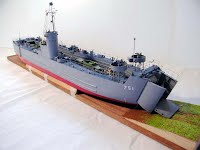 |






